A Resilient Internet of Things (IOT) using Dedicated Data Contingency Planning: The Raspberry Pi Use Case
VerifiedAdded on 2023/01/23
|77
|11519
|32
AI Summary
This research aims to find an effective data contingency and secure the development of IoT. The researcher takes effort to analyze and compare the existing continuity framework of a business and their application or efficiency in context to the IoT infrastructure.
Contribute Materials
Your contribution can guide someone’s learning journey. Share your
documents today.
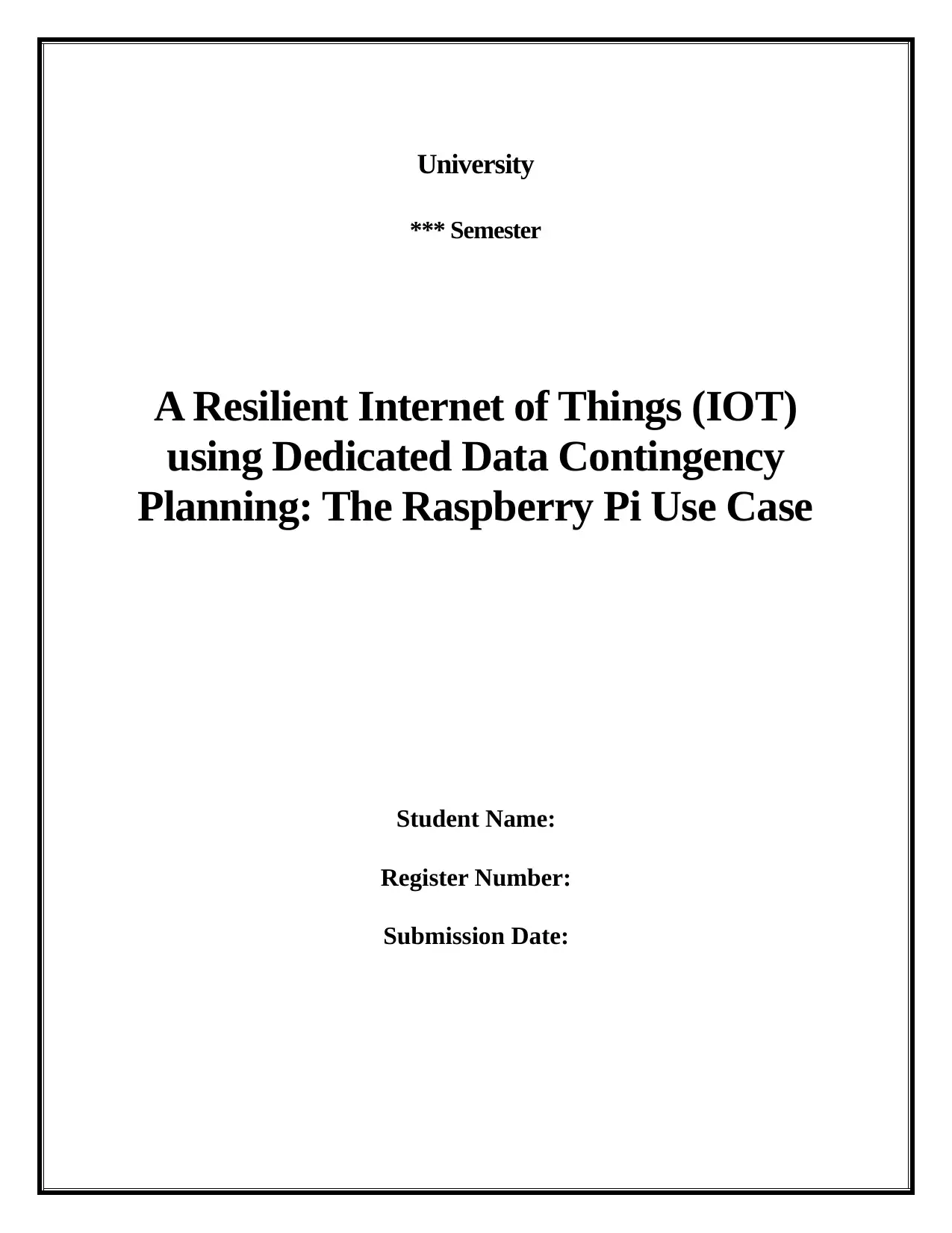
University
*** Semester
A Resilient Internet of Things (IOT)
using Dedicated Data Contingency
Planning: The Raspberry Pi Use Case
Student Name:
Register Number:
Submission Date:
*** Semester
A Resilient Internet of Things (IOT)
using Dedicated Data Contingency
Planning: The Raspberry Pi Use Case
Student Name:
Register Number:
Submission Date:
Secure Best Marks with AI Grader
Need help grading? Try our AI Grader for instant feedback on your assignments.

Abstract
IoT (Internet of Things) is subjected to various vulnerabilities and it must be identified and
treated immediately, if not it can harm the data present in the IoT environment. This research
aims to find an effective data contingency and secure the development of IoT. The researcher
takes effort to analyze and compare the existing continuity framework of a business and their
application or efficiency in context to the IoT infrastructure. The key attack vectors that stresses
on the impact on data availability are determined. This research first identifies the quality and
challenge of the artefact. Then, the process of designing, implementation and testing the artefacts
are performed with technical demonstration. A testbed of raspberry pi 3 is used with SSH to
complete the testbed. It also gives the solutions on how these attacks can be controlled and
reduced. On the other hand, Kali Linux is also used as a victim attacker. From this research, it is
determined that, the IoT devices can be secured during designing, installation, configuration and
maintenance.
IoT (Internet of Things) is subjected to various vulnerabilities and it must be identified and
treated immediately, if not it can harm the data present in the IoT environment. This research
aims to find an effective data contingency and secure the development of IoT. The researcher
takes effort to analyze and compare the existing continuity framework of a business and their
application or efficiency in context to the IoT infrastructure. The key attack vectors that stresses
on the impact on data availability are determined. This research first identifies the quality and
challenge of the artefact. Then, the process of designing, implementation and testing the artefacts
are performed with technical demonstration. A testbed of raspberry pi 3 is used with SSH to
complete the testbed. It also gives the solutions on how these attacks can be controlled and
reduced. On the other hand, Kali Linux is also used as a victim attacker. From this research, it is
determined that, the IoT devices can be secured during designing, installation, configuration and
maintenance.

Table of Contents
Chapter 1: Introduction................................................................................................................................................... 1
1.1 Academic Question............................................................................................................................................. 2
1.2 Aims................................................................................................................................................................... 2
1.3 Objectives........................................................................................................................................................... 2
1.4 Artefact to be developed...................................................................................................................................... 3
1.5 Dissertation Structure......................................................................................................................................... 3
Chapter 2: Literature Review........................................................................................................................................... 4
2.1 Overview............................................................................................................................................................. 4
Chapter 3: Artefact-3500.................................................................................................................................................. 7
3.1 Demonstration................................................................................................................................................... 11
Chapter 4: Critical Evaluation-1000............................................................................................................................... 17
Chapter 5: Conclusion-500............................................................................................................................................. 22
References...................................................................................................................................................................... 24
Chapter 1: Introduction................................................................................................................................................... 1
1.1 Academic Question............................................................................................................................................. 2
1.2 Aims................................................................................................................................................................... 2
1.3 Objectives........................................................................................................................................................... 2
1.4 Artefact to be developed...................................................................................................................................... 3
1.5 Dissertation Structure......................................................................................................................................... 3
Chapter 2: Literature Review........................................................................................................................................... 4
2.1 Overview............................................................................................................................................................. 4
Chapter 3: Artefact-3500.................................................................................................................................................. 7
3.1 Demonstration................................................................................................................................................... 11
Chapter 4: Critical Evaluation-1000............................................................................................................................... 17
Chapter 5: Conclusion-500............................................................................................................................................. 22
References...................................................................................................................................................................... 24
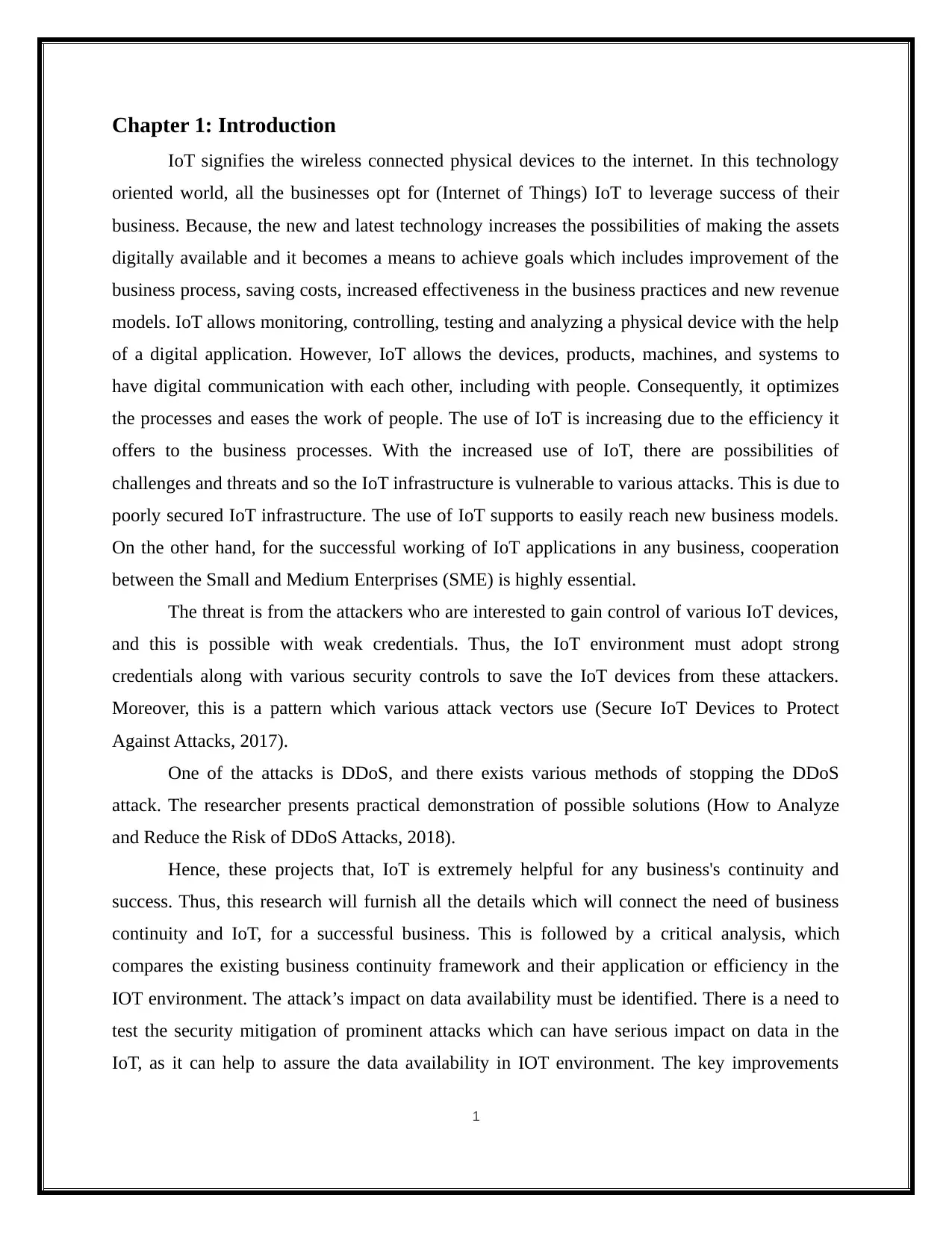
Chapter 1: Introduction
IoT signifies the wireless connected physical devices to the internet. In this technology
oriented world, all the businesses opt for (Internet of Things) IoT to leverage success of their
business. Because, the new and latest technology increases the possibilities of making the assets
digitally available and it becomes a means to achieve goals which includes improvement of the
business process, saving costs, increased effectiveness in the business practices and new revenue
models. IoT allows monitoring, controlling, testing and analyzing a physical device with the help
of a digital application. However, IoT allows the devices, products, machines, and systems to
have digital communication with each other, including with people. Consequently, it optimizes
the processes and eases the work of people. The use of IoT is increasing due to the efficiency it
offers to the business processes. With the increased use of IoT, there are possibilities of
challenges and threats and so the IoT infrastructure is vulnerable to various attacks. This is due to
poorly secured IoT infrastructure. The use of IoT supports to easily reach new business models.
On the other hand, for the successful working of IoT applications in any business, cooperation
between the Small and Medium Enterprises (SME) is highly essential.
The threat is from the attackers who are interested to gain control of various IoT devices,
and this is possible with weak credentials. Thus, the IoT environment must adopt strong
credentials along with various security controls to save the IoT devices from these attackers.
Moreover, this is a pattern which various attack vectors use (Secure IoT Devices to Protect
Against Attacks, 2017).
One of the attacks is DDoS, and there exists various methods of stopping the DDoS
attack. The researcher presents practical demonstration of possible solutions (How to Analyze
and Reduce the Risk of DDoS Attacks, 2018).
Hence, these projects that, IoT is extremely helpful for any business's continuity and
success. Thus, this research will furnish all the details which will connect the need of business
continuity and IoT, for a successful business. This is followed by a critical analysis, which
compares the existing business continuity framework and their application or efficiency in the
IOT environment. The attack’s impact on data availability must be identified. There is a need to
test the security mitigation of prominent attacks which can have serious impact on data in the
IoT, as it can help to assure the data availability in IOT environment. The key improvements
1
IoT signifies the wireless connected physical devices to the internet. In this technology
oriented world, all the businesses opt for (Internet of Things) IoT to leverage success of their
business. Because, the new and latest technology increases the possibilities of making the assets
digitally available and it becomes a means to achieve goals which includes improvement of the
business process, saving costs, increased effectiveness in the business practices and new revenue
models. IoT allows monitoring, controlling, testing and analyzing a physical device with the help
of a digital application. However, IoT allows the devices, products, machines, and systems to
have digital communication with each other, including with people. Consequently, it optimizes
the processes and eases the work of people. The use of IoT is increasing due to the efficiency it
offers to the business processes. With the increased use of IoT, there are possibilities of
challenges and threats and so the IoT infrastructure is vulnerable to various attacks. This is due to
poorly secured IoT infrastructure. The use of IoT supports to easily reach new business models.
On the other hand, for the successful working of IoT applications in any business, cooperation
between the Small and Medium Enterprises (SME) is highly essential.
The threat is from the attackers who are interested to gain control of various IoT devices,
and this is possible with weak credentials. Thus, the IoT environment must adopt strong
credentials along with various security controls to save the IoT devices from these attackers.
Moreover, this is a pattern which various attack vectors use (Secure IoT Devices to Protect
Against Attacks, 2017).
One of the attacks is DDoS, and there exists various methods of stopping the DDoS
attack. The researcher presents practical demonstration of possible solutions (How to Analyze
and Reduce the Risk of DDoS Attacks, 2018).
Hence, these projects that, IoT is extremely helpful for any business's continuity and
success. Thus, this research will furnish all the details which will connect the need of business
continuity and IoT, for a successful business. This is followed by a critical analysis, which
compares the existing business continuity framework and their application or efficiency in the
IOT environment. The attack’s impact on data availability must be identified. There is a need to
test the security mitigation of prominent attacks which can have serious impact on data in the
IoT, as it can help to assure the data availability in IOT environment. The key improvements
1
Secure Best Marks with AI Grader
Need help grading? Try our AI Grader for instant feedback on your assignments.
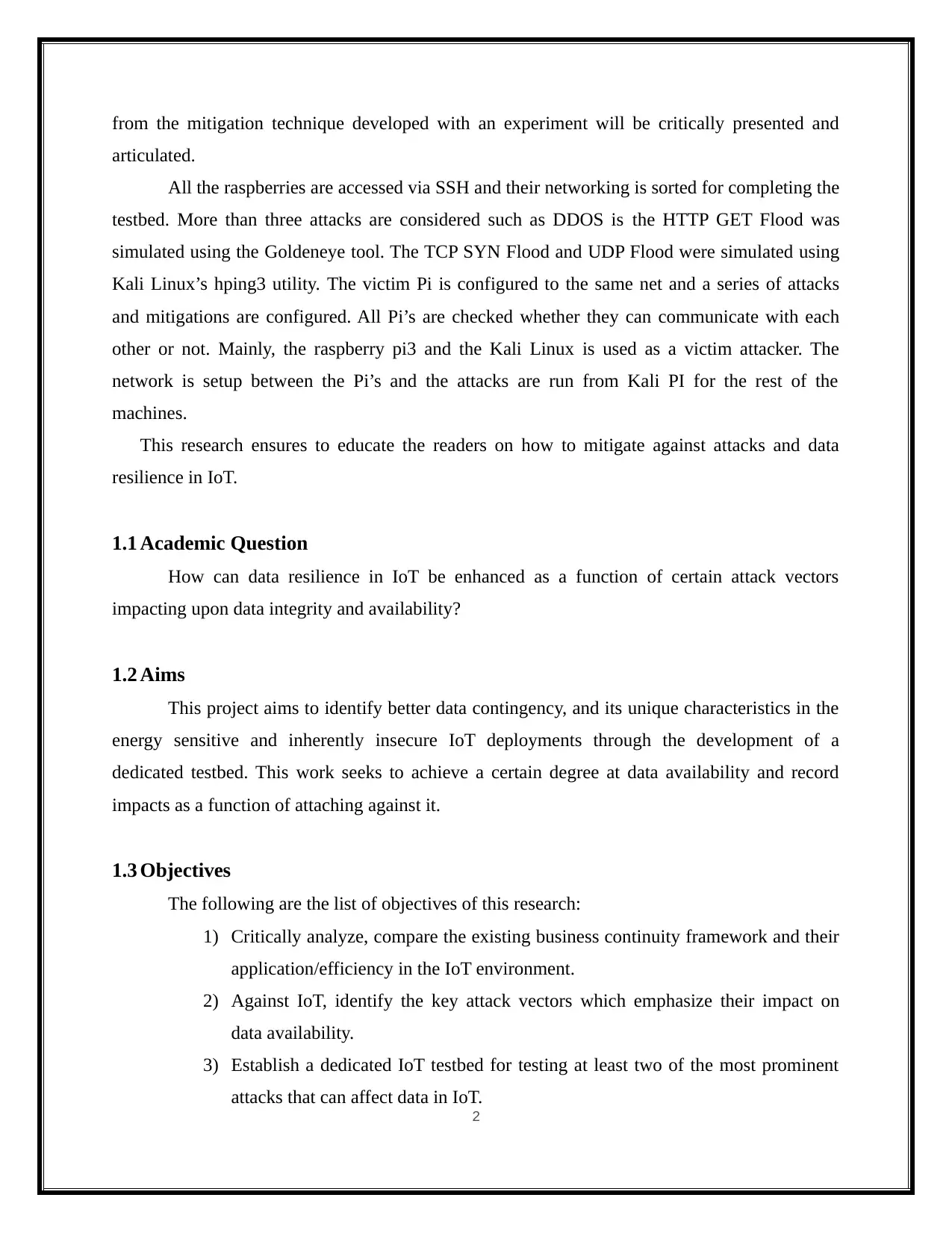
from the mitigation technique developed with an experiment will be critically presented and
articulated.
All the raspberries are accessed via SSH and their networking is sorted for completing the
testbed. More than three attacks are considered such as DDOS is the HTTP GET Flood was
simulated using the Goldeneye tool. The TCP SYN Flood and UDP Flood were simulated using
Kali Linux’s hping3 utility. The victim Pi is configured to the same net and a series of attacks
and mitigations are configured. All Pi’s are checked whether they can communicate with each
other or not. Mainly, the raspberry pi3 and the Kali Linux is used as a victim attacker. The
network is setup between the Pi’s and the attacks are run from Kali PI for the rest of the
machines.
This research ensures to educate the readers on how to mitigate against attacks and data
resilience in IoT.
1.1 Academic Question
How can data resilience in IoT be enhanced as a function of certain attack vectors
impacting upon data integrity and availability?
1.2 Aims
This project aims to identify better data contingency, and its unique characteristics in the
energy sensitive and inherently insecure IoT deployments through the development of a
dedicated testbed. This work seeks to achieve a certain degree at data availability and record
impacts as a function of attaching against it.
1.3 Objectives
The following are the list of objectives of this research:
1) Critically analyze, compare the existing business continuity framework and their
application/efficiency in the IoT environment.
2) Against IoT, identify the key attack vectors which emphasize their impact on
data availability.
3) Establish a dedicated IoT testbed for testing at least two of the most prominent
attacks that can affect data in IoT.
2
articulated.
All the raspberries are accessed via SSH and their networking is sorted for completing the
testbed. More than three attacks are considered such as DDOS is the HTTP GET Flood was
simulated using the Goldeneye tool. The TCP SYN Flood and UDP Flood were simulated using
Kali Linux’s hping3 utility. The victim Pi is configured to the same net and a series of attacks
and mitigations are configured. All Pi’s are checked whether they can communicate with each
other or not. Mainly, the raspberry pi3 and the Kali Linux is used as a victim attacker. The
network is setup between the Pi’s and the attacks are run from Kali PI for the rest of the
machines.
This research ensures to educate the readers on how to mitigate against attacks and data
resilience in IoT.
1.1 Academic Question
How can data resilience in IoT be enhanced as a function of certain attack vectors
impacting upon data integrity and availability?
1.2 Aims
This project aims to identify better data contingency, and its unique characteristics in the
energy sensitive and inherently insecure IoT deployments through the development of a
dedicated testbed. This work seeks to achieve a certain degree at data availability and record
impacts as a function of attaching against it.
1.3 Objectives
The following are the list of objectives of this research:
1) Critically analyze, compare the existing business continuity framework and their
application/efficiency in the IoT environment.
2) Against IoT, identify the key attack vectors which emphasize their impact on
data availability.
3) Establish a dedicated IoT testbed for testing at least two of the most prominent
attacks that can affect data in IoT.
2

4) Designing, implementing and test security mitigation using the dedicated testbed
to assure data availability within the IoT environment.
5) Critically present and articulate the key improvements from the mitigation
technique developed as part of the experiment process.
1.4 Artefact to be developed
This work seeks to articulate a data contingency technique running in a dedicated IoT
testbed with demonstrable resilience against certain attacks affecting data availability/integrity.
1.5 Dissertation Structure
Chapter 1 is the introduction part, which gives the background of the topic to be discussed.
Chapter 2 contains literature review, where various reviews are presented to support the research.
Chapter 3 sheds light on the artefacts. This chapter discusses about the quality and challenges of
artefacts. Further, the Artefact related analysis, designing and testing is presented with
appropriate demonstration.
Chapter 4 presents the critical evaluations of the artefact and process, where its strengths and
weaknesses are identified. Additionally, the arguments related to the artefacts are
shared.
Chapter 5 furnishes the conclusion of this research.
3
to assure data availability within the IoT environment.
5) Critically present and articulate the key improvements from the mitigation
technique developed as part of the experiment process.
1.4 Artefact to be developed
This work seeks to articulate a data contingency technique running in a dedicated IoT
testbed with demonstrable resilience against certain attacks affecting data availability/integrity.
1.5 Dissertation Structure
Chapter 1 is the introduction part, which gives the background of the topic to be discussed.
Chapter 2 contains literature review, where various reviews are presented to support the research.
Chapter 3 sheds light on the artefacts. This chapter discusses about the quality and challenges of
artefacts. Further, the Artefact related analysis, designing and testing is presented with
appropriate demonstration.
Chapter 4 presents the critical evaluations of the artefact and process, where its strengths and
weaknesses are identified. Additionally, the arguments related to the artefacts are
shared.
Chapter 5 furnishes the conclusion of this research.
3
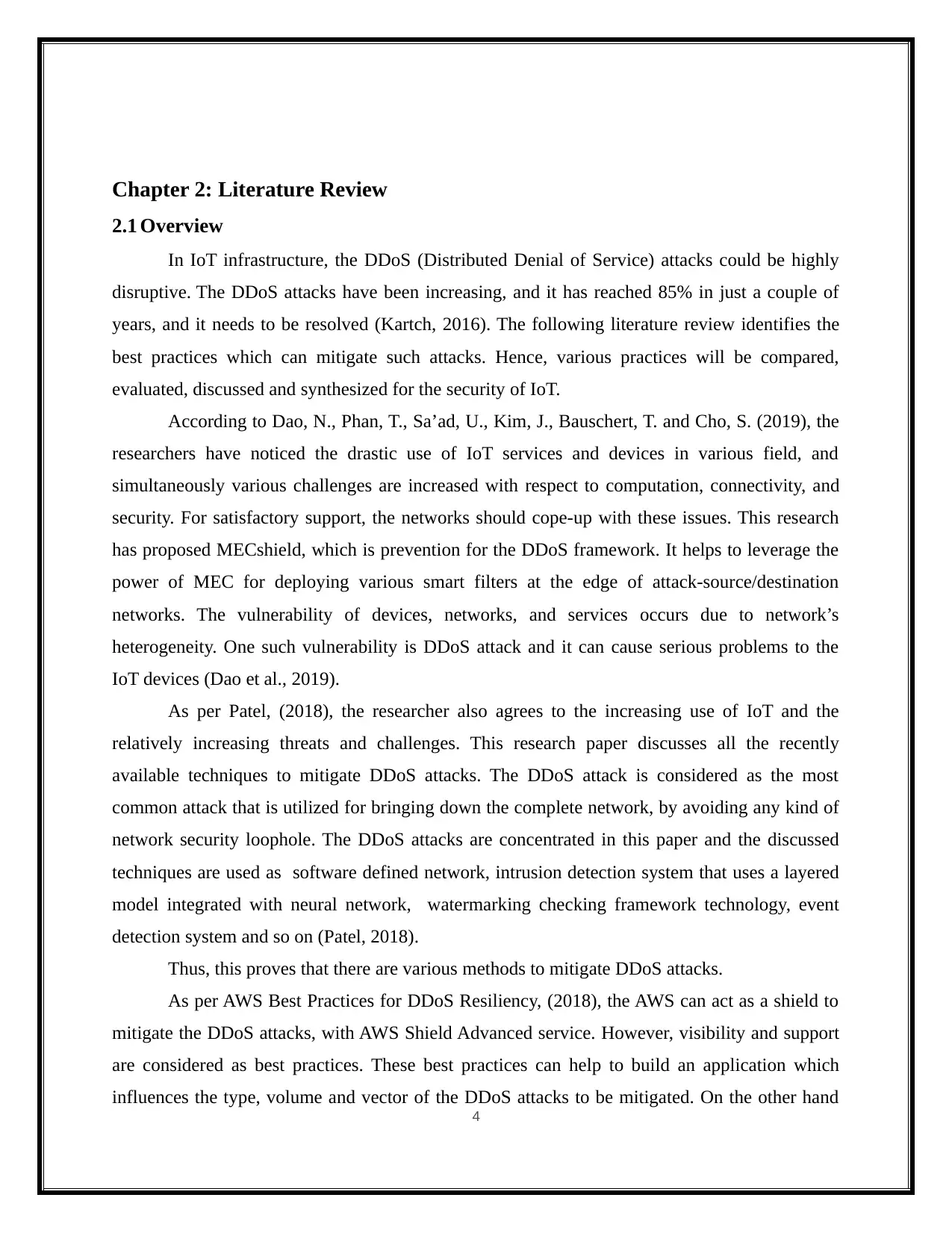
Chapter 2: Literature Review
2.1 Overview
In IoT infrastructure, the DDoS (Distributed Denial of Service) attacks could be highly
disruptive. The DDoS attacks have been increasing, and it has reached 85% in just a couple of
years, and it needs to be resolved (Kartch, 2016). The following literature review identifies the
best practices which can mitigate such attacks. Hence, various practices will be compared,
evaluated, discussed and synthesized for the security of IoT.
According to Dao, N., Phan, T., Sa’ad, U., Kim, J., Bauschert, T. and Cho, S. (2019), the
researchers have noticed the drastic use of IoT services and devices in various field, and
simultaneously various challenges are increased with respect to computation, connectivity, and
security. For satisfactory support, the networks should cope-up with these issues. This research
has proposed MECshield, which is prevention for the DDoS framework. It helps to leverage the
power of MEC for deploying various smart filters at the edge of attack-source/destination
networks. The vulnerability of devices, networks, and services occurs due to network’s
heterogeneity. One such vulnerability is DDoS attack and it can cause serious problems to the
IoT devices (Dao et al., 2019).
As per Patel, (2018), the researcher also agrees to the increasing use of IoT and the
relatively increasing threats and challenges. This research paper discusses all the recently
available techniques to mitigate DDoS attacks. The DDoS attack is considered as the most
common attack that is utilized for bringing down the complete network, by avoiding any kind of
network security loophole. The DDoS attacks are concentrated in this paper and the discussed
techniques are used as software defined network, intrusion detection system that uses a layered
model integrated with neural network, watermarking checking framework technology, event
detection system and so on (Patel, 2018).
Thus, this proves that there are various methods to mitigate DDoS attacks.
As per AWS Best Practices for DDoS Resiliency, (2018), the AWS can act as a shield to
mitigate the DDoS attacks, with AWS Shield Advanced service. However, visibility and support
are considered as best practices. These best practices can help to build an application which
influences the type, volume and vector of the DDoS attacks to be mitigated. On the other hand
4
2.1 Overview
In IoT infrastructure, the DDoS (Distributed Denial of Service) attacks could be highly
disruptive. The DDoS attacks have been increasing, and it has reached 85% in just a couple of
years, and it needs to be resolved (Kartch, 2016). The following literature review identifies the
best practices which can mitigate such attacks. Hence, various practices will be compared,
evaluated, discussed and synthesized for the security of IoT.
According to Dao, N., Phan, T., Sa’ad, U., Kim, J., Bauschert, T. and Cho, S. (2019), the
researchers have noticed the drastic use of IoT services and devices in various field, and
simultaneously various challenges are increased with respect to computation, connectivity, and
security. For satisfactory support, the networks should cope-up with these issues. This research
has proposed MECshield, which is prevention for the DDoS framework. It helps to leverage the
power of MEC for deploying various smart filters at the edge of attack-source/destination
networks. The vulnerability of devices, networks, and services occurs due to network’s
heterogeneity. One such vulnerability is DDoS attack and it can cause serious problems to the
IoT devices (Dao et al., 2019).
As per Patel, (2018), the researcher also agrees to the increasing use of IoT and the
relatively increasing threats and challenges. This research paper discusses all the recently
available techniques to mitigate DDoS attacks. The DDoS attack is considered as the most
common attack that is utilized for bringing down the complete network, by avoiding any kind of
network security loophole. The DDoS attacks are concentrated in this paper and the discussed
techniques are used as software defined network, intrusion detection system that uses a layered
model integrated with neural network, watermarking checking framework technology, event
detection system and so on (Patel, 2018).
Thus, this proves that there are various methods to mitigate DDoS attacks.
As per AWS Best Practices for DDoS Resiliency, (2018), the AWS can act as a shield to
mitigate the DDoS attacks, with AWS Shield Advanced service. However, visibility and support
are considered as best practices. These best practices can help to build an application which
influences the type, volume and vector of the DDoS attacks to be mitigated. On the other hand
4
Paraphrase This Document
Need a fresh take? Get an instant paraphrase of this document with our AI Paraphraser
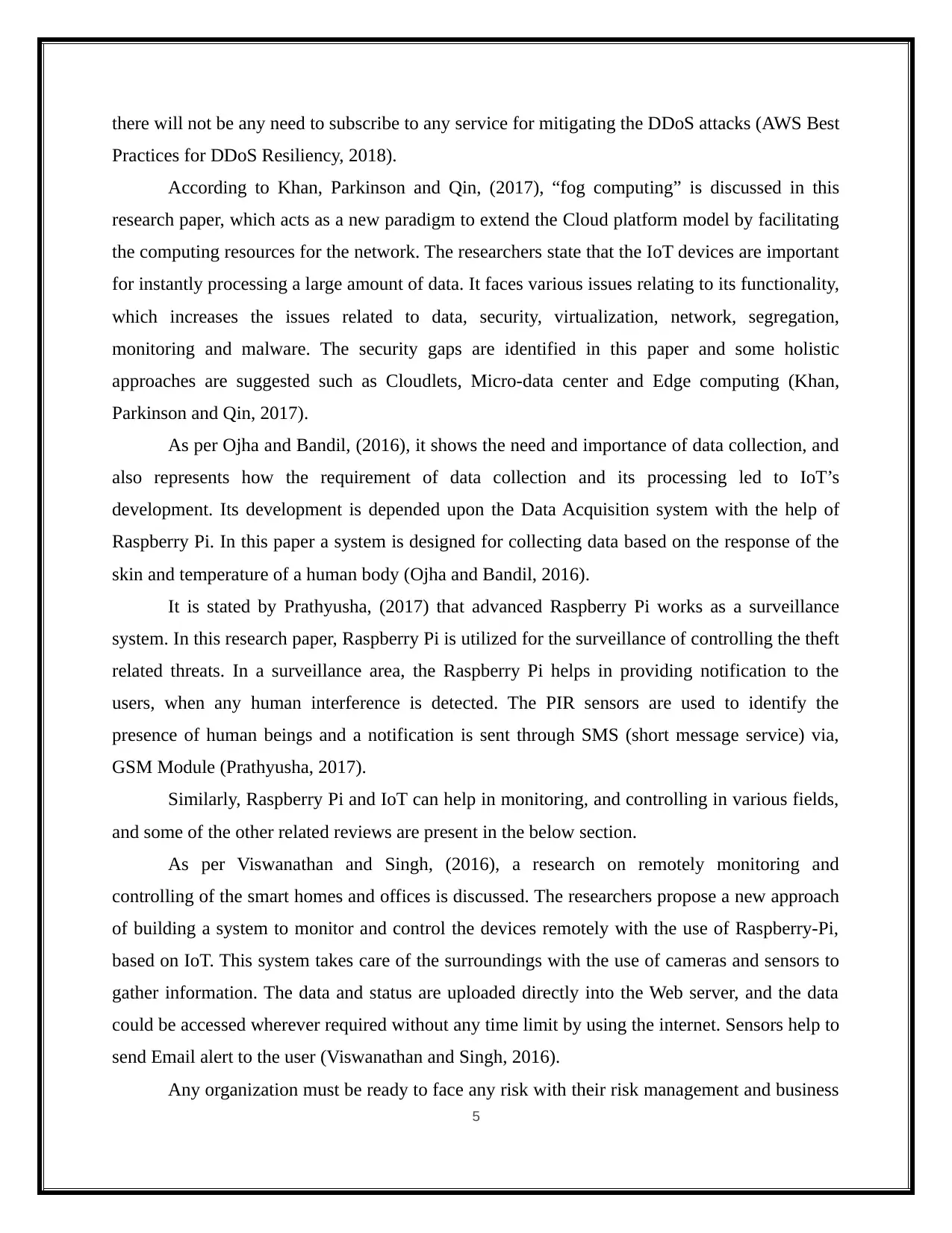
there will not be any need to subscribe to any service for mitigating the DDoS attacks (AWS Best
Practices for DDoS Resiliency, 2018).
According to Khan, Parkinson and Qin, (2017), “fog computing” is discussed in this
research paper, which acts as a new paradigm to extend the Cloud platform model by facilitating
the computing resources for the network. The researchers state that the IoT devices are important
for instantly processing a large amount of data. It faces various issues relating to its functionality,
which increases the issues related to data, security, virtualization, network, segregation,
monitoring and malware. The security gaps are identified in this paper and some holistic
approaches are suggested such as Cloudlets, Micro-data center and Edge computing (Khan,
Parkinson and Qin, 2017).
As per Ojha and Bandil, (2016), it shows the need and importance of data collection, and
also represents how the requirement of data collection and its processing led to IoT’s
development. Its development is depended upon the Data Acquisition system with the help of
Raspberry Pi. In this paper a system is designed for collecting data based on the response of the
skin and temperature of a human body (Ojha and Bandil, 2016).
It is stated by Prathyusha, (2017) that advanced Raspberry Pi works as a surveillance
system. In this research paper, Raspberry Pi is utilized for the surveillance of controlling the theft
related threats. In a surveillance area, the Raspberry Pi helps in providing notification to the
users, when any human interference is detected. The PIR sensors are used to identify the
presence of human beings and a notification is sent through SMS (short message service) via,
GSM Module (Prathyusha, 2017).
Similarly, Raspberry Pi and IoT can help in monitoring, and controlling in various fields,
and some of the other related reviews are present in the below section.
As per Viswanathan and Singh, (2016), a research on remotely monitoring and
controlling of the smart homes and offices is discussed. The researchers propose a new approach
of building a system to monitor and control the devices remotely with the use of Raspberry-Pi,
based on IoT. This system takes care of the surroundings with the use of cameras and sensors to
gather information. The data and status are uploaded directly into the Web server, and the data
could be accessed wherever required without any time limit by using the internet. Sensors help to
send Email alert to the user (Viswanathan and Singh, 2016).
Any organization must be ready to face any risk with their risk management and business
5
Practices for DDoS Resiliency, 2018).
According to Khan, Parkinson and Qin, (2017), “fog computing” is discussed in this
research paper, which acts as a new paradigm to extend the Cloud platform model by facilitating
the computing resources for the network. The researchers state that the IoT devices are important
for instantly processing a large amount of data. It faces various issues relating to its functionality,
which increases the issues related to data, security, virtualization, network, segregation,
monitoring and malware. The security gaps are identified in this paper and some holistic
approaches are suggested such as Cloudlets, Micro-data center and Edge computing (Khan,
Parkinson and Qin, 2017).
As per Ojha and Bandil, (2016), it shows the need and importance of data collection, and
also represents how the requirement of data collection and its processing led to IoT’s
development. Its development is depended upon the Data Acquisition system with the help of
Raspberry Pi. In this paper a system is designed for collecting data based on the response of the
skin and temperature of a human body (Ojha and Bandil, 2016).
It is stated by Prathyusha, (2017) that advanced Raspberry Pi works as a surveillance
system. In this research paper, Raspberry Pi is utilized for the surveillance of controlling the theft
related threats. In a surveillance area, the Raspberry Pi helps in providing notification to the
users, when any human interference is detected. The PIR sensors are used to identify the
presence of human beings and a notification is sent through SMS (short message service) via,
GSM Module (Prathyusha, 2017).
Similarly, Raspberry Pi and IoT can help in monitoring, and controlling in various fields,
and some of the other related reviews are present in the below section.
As per Viswanathan and Singh, (2016), a research on remotely monitoring and
controlling of the smart homes and offices is discussed. The researchers propose a new approach
of building a system to monitor and control the devices remotely with the use of Raspberry-Pi,
based on IoT. This system takes care of the surroundings with the use of cameras and sensors to
gather information. The data and status are uploaded directly into the Web server, and the data
could be accessed wherever required without any time limit by using the internet. Sensors help to
send Email alert to the user (Viswanathan and Singh, 2016).
Any organization must be ready to face any risk with their risk management and business
5

continuity management (BCM), as they are essential parts as they cover various risks. However,
only BCM can't facilitate security for the organization, in context to various risks that it faces
(Alexander, 2017).
2.2 Data Integrity and Availability
How can data resilience in IoT be enhanced in a function of certain attack vectors
impacting upon data integrity and availability?
he rapid development of
Internet of Things (IoT) is
starting
to transform how we live [1].
As more physical devices
such as mobile phones,
wearable devices, and
vehicles are
connecting to the Internet
through embedded systems
and
sensors, large amounts of data
can be collected and sent to
6
only BCM can't facilitate security for the organization, in context to various risks that it faces
(Alexander, 2017).
2.2 Data Integrity and Availability
How can data resilience in IoT be enhanced in a function of certain attack vectors
impacting upon data integrity and availability?
he rapid development of
Internet of Things (IoT) is
starting
to transform how we live [1].
As more physical devices
such as mobile phones,
wearable devices, and
vehicles are
connecting to the Internet
through embedded systems
and
sensors, large amounts of data
can be collected and sent to
6
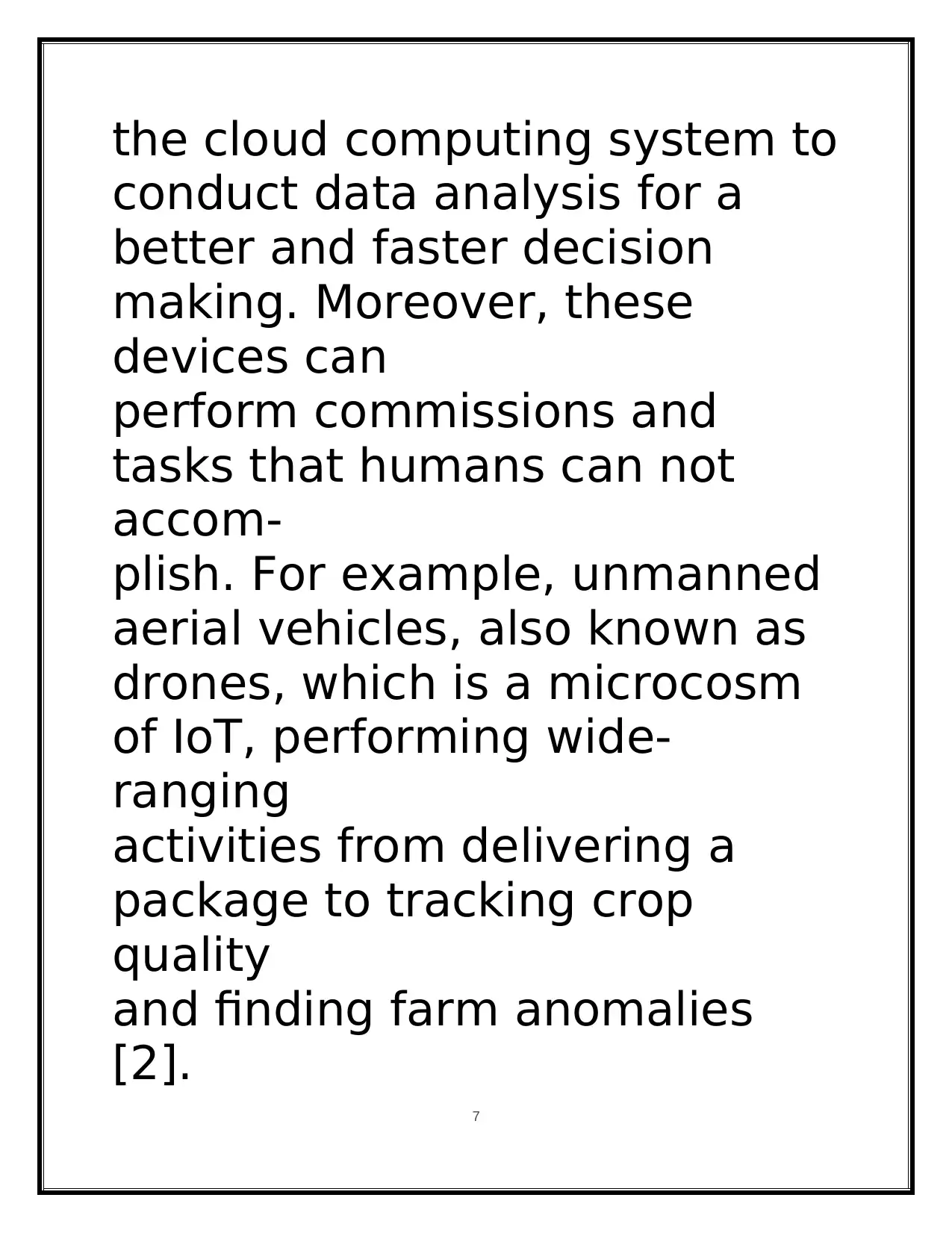
the cloud computing system to
conduct data analysis for a
better and faster decision
making. Moreover, these
devices can
perform commissions and
tasks that humans can not
accom-
plish. For example, unmanned
aerial vehicles, also known as
drones, which is a microcosm
of IoT, performing wide-
ranging
activities from delivering a
package to tracking crop
quality
and finding farm anomalies
[2]. 7
conduct data analysis for a
better and faster decision
making. Moreover, these
devices can
perform commissions and
tasks that humans can not
accom-
plish. For example, unmanned
aerial vehicles, also known as
drones, which is a microcosm
of IoT, performing wide-
ranging
activities from delivering a
package to tracking crop
quality
and finding farm anomalies
[2]. 7
Secure Best Marks with AI Grader
Need help grading? Try our AI Grader for instant feedback on your assignments.
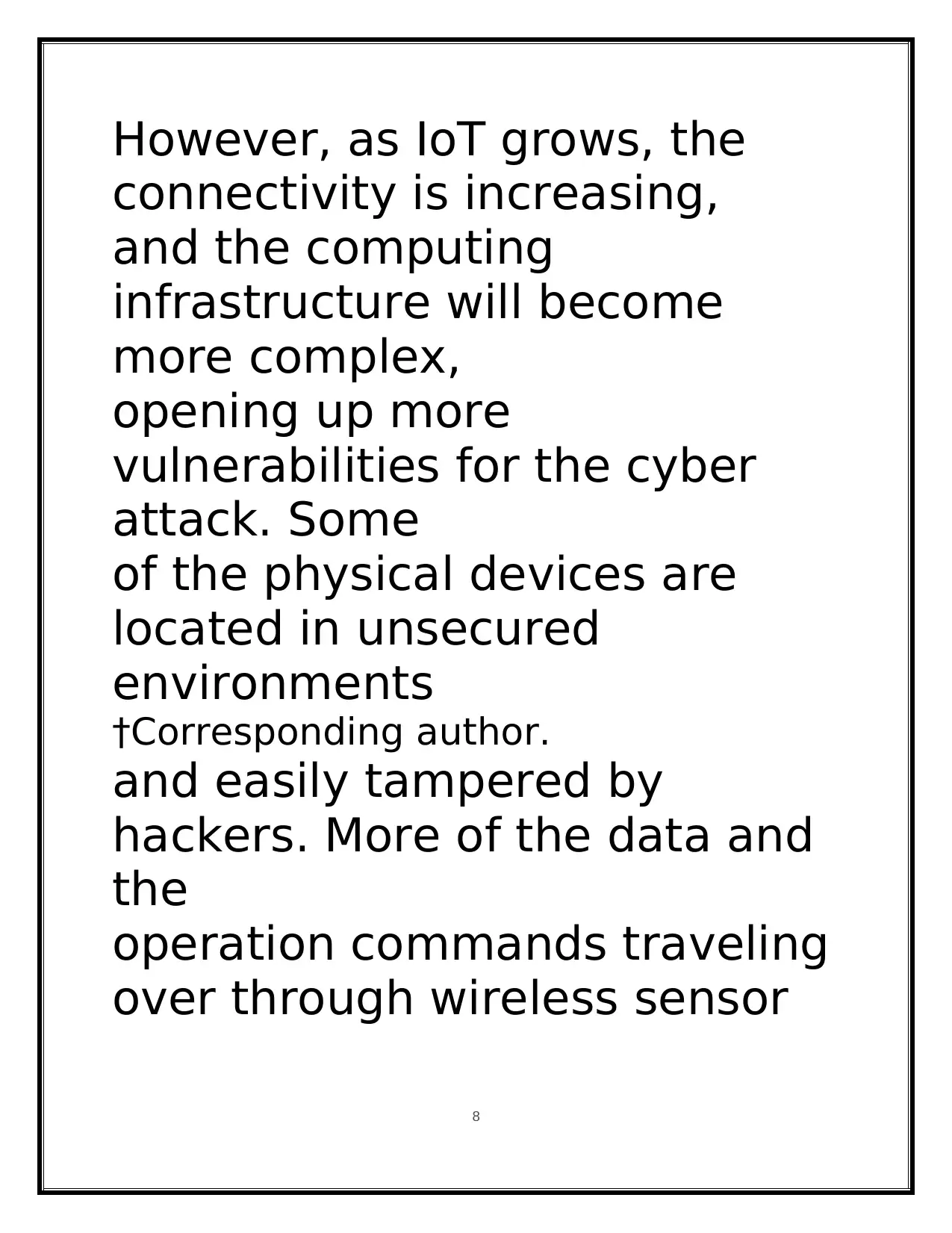
However, as IoT grows, the
connectivity is increasing,
and the computing
infrastructure will become
more complex,
opening up more
vulnerabilities for the cyber
attack. Some
of the physical devices are
located in unsecured
environments
†Corresponding author.
and easily tampered by
hackers. More of the data and
the
operation commands traveling
over through wireless sensor
8
connectivity is increasing,
and the computing
infrastructure will become
more complex,
opening up more
vulnerabilities for the cyber
attack. Some
of the physical devices are
located in unsecured
environments
†Corresponding author.
and easily tampered by
hackers. More of the data and
the
operation commands traveling
over through wireless sensor
8
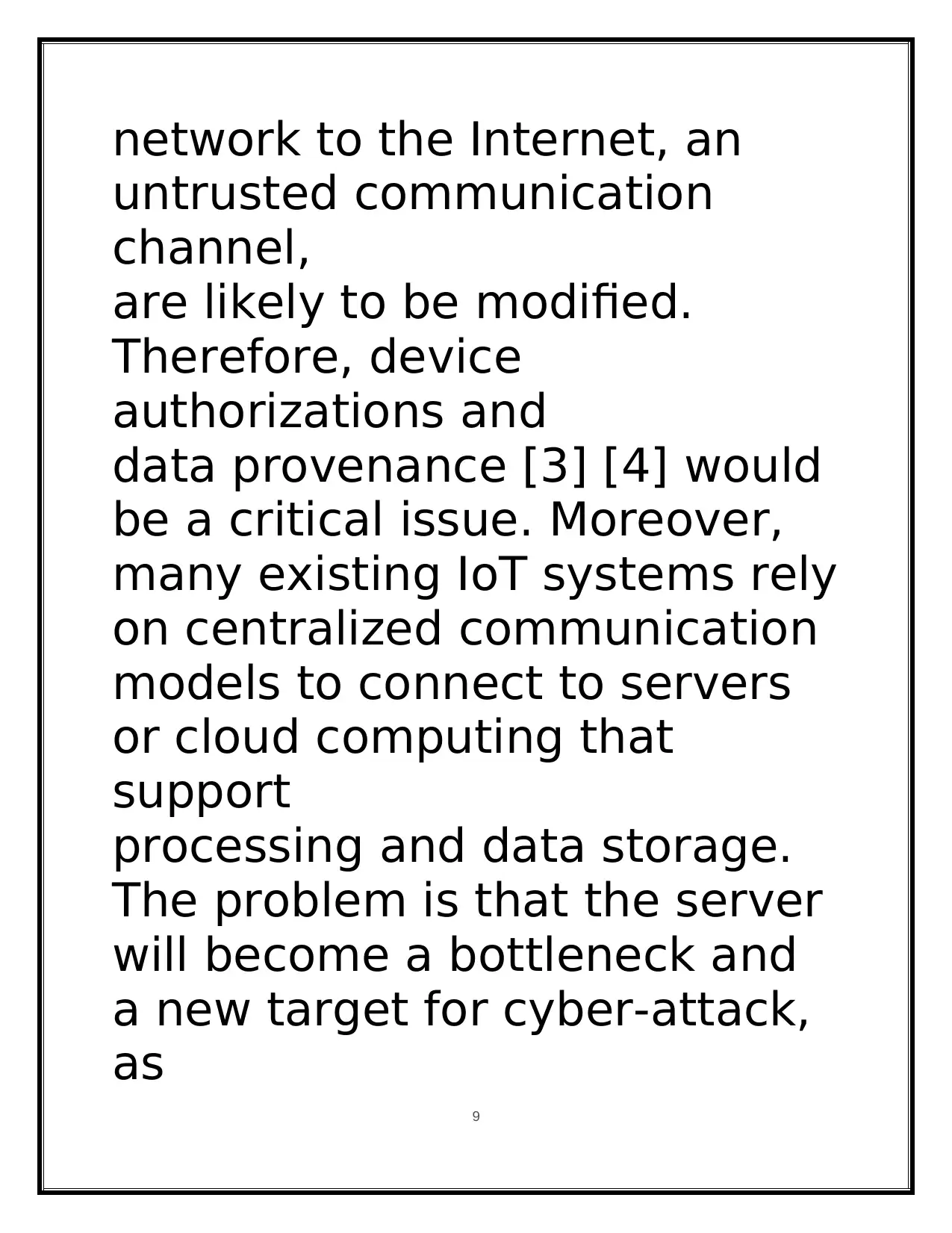
network to the Internet, an
untrusted communication
channel,
are likely to be modified.
Therefore, device
authorizations and
data provenance [3] [4] would
be a critical issue. Moreover,
many existing IoT systems rely
on centralized communication
models to connect to servers
or cloud computing that
support
processing and data storage.
The problem is that the server
will become a bottleneck and
a new target for cyber-attack,
as 9
untrusted communication
channel,
are likely to be modified.
Therefore, device
authorizations and
data provenance [3] [4] would
be a critical issue. Moreover,
many existing IoT systems rely
on centralized communication
models to connect to servers
or cloud computing that
support
processing and data storage.
The problem is that the server
will become a bottleneck and
a new target for cyber-attack,
as 9
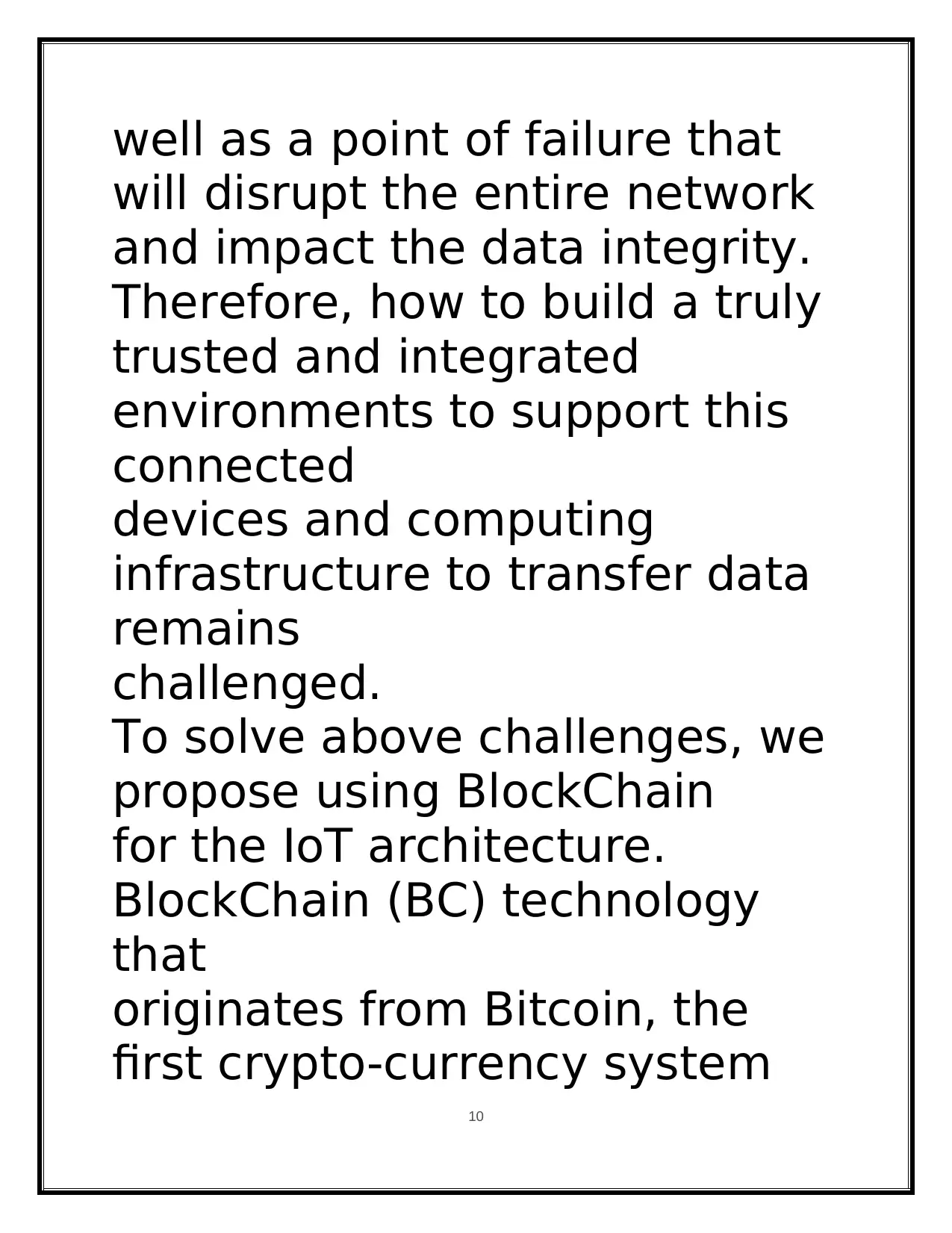
well as a point of failure that
will disrupt the entire network
and impact the data integrity.
Therefore, how to build a truly
trusted and integrated
environments to support this
connected
devices and computing
infrastructure to transfer data
remains
challenged.
To solve above challenges, we
propose using BlockChain
for the IoT architecture.
BlockChain (BC) technology
that
originates from Bitcoin, the
first crypto-currency system
10
will disrupt the entire network
and impact the data integrity.
Therefore, how to build a truly
trusted and integrated
environments to support this
connected
devices and computing
infrastructure to transfer data
remains
challenged.
To solve above challenges, we
propose using BlockChain
for the IoT architecture.
BlockChain (BC) technology
that
originates from Bitcoin, the
first crypto-currency system
10
Paraphrase This Document
Need a fresh take? Get an instant paraphrase of this document with our AI Paraphraser
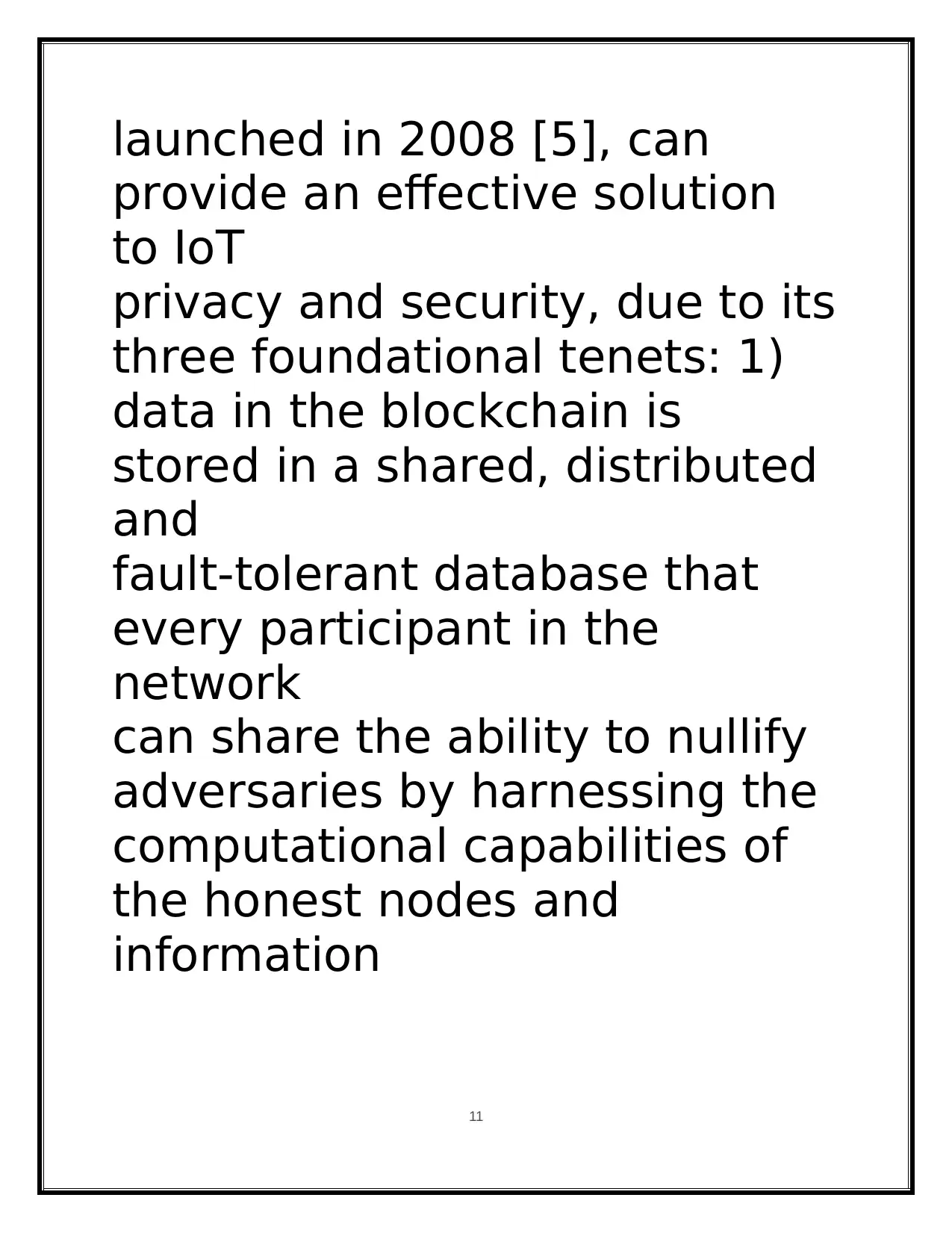
launched in 2008 [5], can
provide an effective solution
to IoT
privacy and security, due to its
three foundational tenets: 1)
data in the blockchain is
stored in a shared, distributed
and
fault-tolerant database that
every participant in the
network
can share the ability to nullify
adversaries by harnessing the
computational capabilities of
the honest nodes and
information
11
provide an effective solution
to IoT
privacy and security, due to its
three foundational tenets: 1)
data in the blockchain is
stored in a shared, distributed
and
fault-tolerant database that
every participant in the
network
can share the ability to nullify
adversaries by harnessing the
computational capabilities of
the honest nodes and
information
11

exchanged is resilient to
manipulation, 2) Blockchain is
a
decentralized architecture to
make the architectures robust
against any failures and
attacks and, 3) Blockchain
relies
on public key infrastructure
which allows the contents to
be
encrypted in a way that is
expensive to crack. With
blockchain-
based IoT architecture, all
data operations are
transparently
12
manipulation, 2) Blockchain is
a
decentralized architecture to
make the architectures robust
against any failures and
attacks and, 3) Blockchain
relies
on public key infrastructure
which allows the contents to
be
encrypted in a way that is
expensive to crack. With
blockchain-
based IoT architecture, all
data operations are
transparently
12
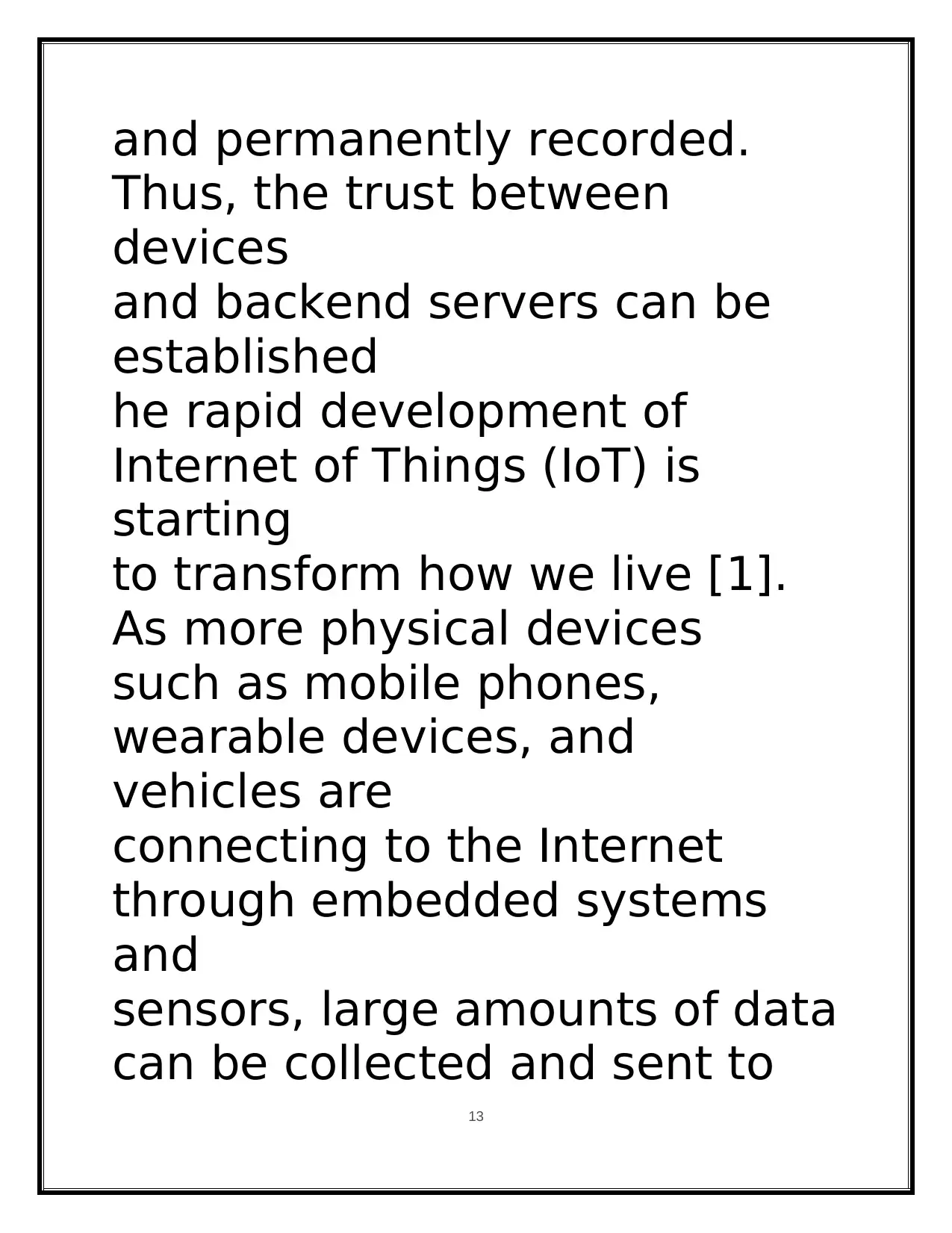
and permanently recorded.
Thus, the trust between
devices
and backend servers can be
established
he rapid development of
Internet of Things (IoT) is
starting
to transform how we live [1].
As more physical devices
such as mobile phones,
wearable devices, and
vehicles are
connecting to the Internet
through embedded systems
and
sensors, large amounts of data
can be collected and sent to
13
Thus, the trust between
devices
and backend servers can be
established
he rapid development of
Internet of Things (IoT) is
starting
to transform how we live [1].
As more physical devices
such as mobile phones,
wearable devices, and
vehicles are
connecting to the Internet
through embedded systems
and
sensors, large amounts of data
can be collected and sent to
13
Secure Best Marks with AI Grader
Need help grading? Try our AI Grader for instant feedback on your assignments.

the cloud computing system to
conduct data analysis for a
better and faster decision
making. Moreover, these
devices can
perform commissions and
tasks that humans can not
accom-
plish. For example, unmanned
aerial vehicles, also known as
drones, which is a microcosm
of IoT, performing wide-
ranging
activities from delivering a
package to tracking crop
quality
and finding farm anomalies
[2]. 14
conduct data analysis for a
better and faster decision
making. Moreover, these
devices can
perform commissions and
tasks that humans can not
accom-
plish. For example, unmanned
aerial vehicles, also known as
drones, which is a microcosm
of IoT, performing wide-
ranging
activities from delivering a
package to tracking crop
quality
and finding farm anomalies
[2]. 14

However, as IoT grows, the
connectivity is increasing,
and the computing
infrastructure will become
more complex,
opening up more
vulnerabilities for the cyber
attack. Some
of the physical devices are
located in unsecured
environments
†Corresponding author.
and easily tampered by
hackers. More of the data and
the
operation commands traveling
over through wireless sensor
15
connectivity is increasing,
and the computing
infrastructure will become
more complex,
opening up more
vulnerabilities for the cyber
attack. Some
of the physical devices are
located in unsecured
environments
†Corresponding author.
and easily tampered by
hackers. More of the data and
the
operation commands traveling
over through wireless sensor
15

network to the Internet, an
untrusted communication
channel,
are likely to be modified.
Therefore, device
authorizations and
data provenance [3] [4] would
be a critical issue. Moreover,
many existing IoT systems rely
on centralized communication
models to connect to servers
or cloud computing that
support
processing and data storage.
The problem is that the server
will become a bottleneck and
a new target for cyber-attack,
as 16
untrusted communication
channel,
are likely to be modified.
Therefore, device
authorizations and
data provenance [3] [4] would
be a critical issue. Moreover,
many existing IoT systems rely
on centralized communication
models to connect to servers
or cloud computing that
support
processing and data storage.
The problem is that the server
will become a bottleneck and
a new target for cyber-attack,
as 16
Paraphrase This Document
Need a fresh take? Get an instant paraphrase of this document with our AI Paraphraser
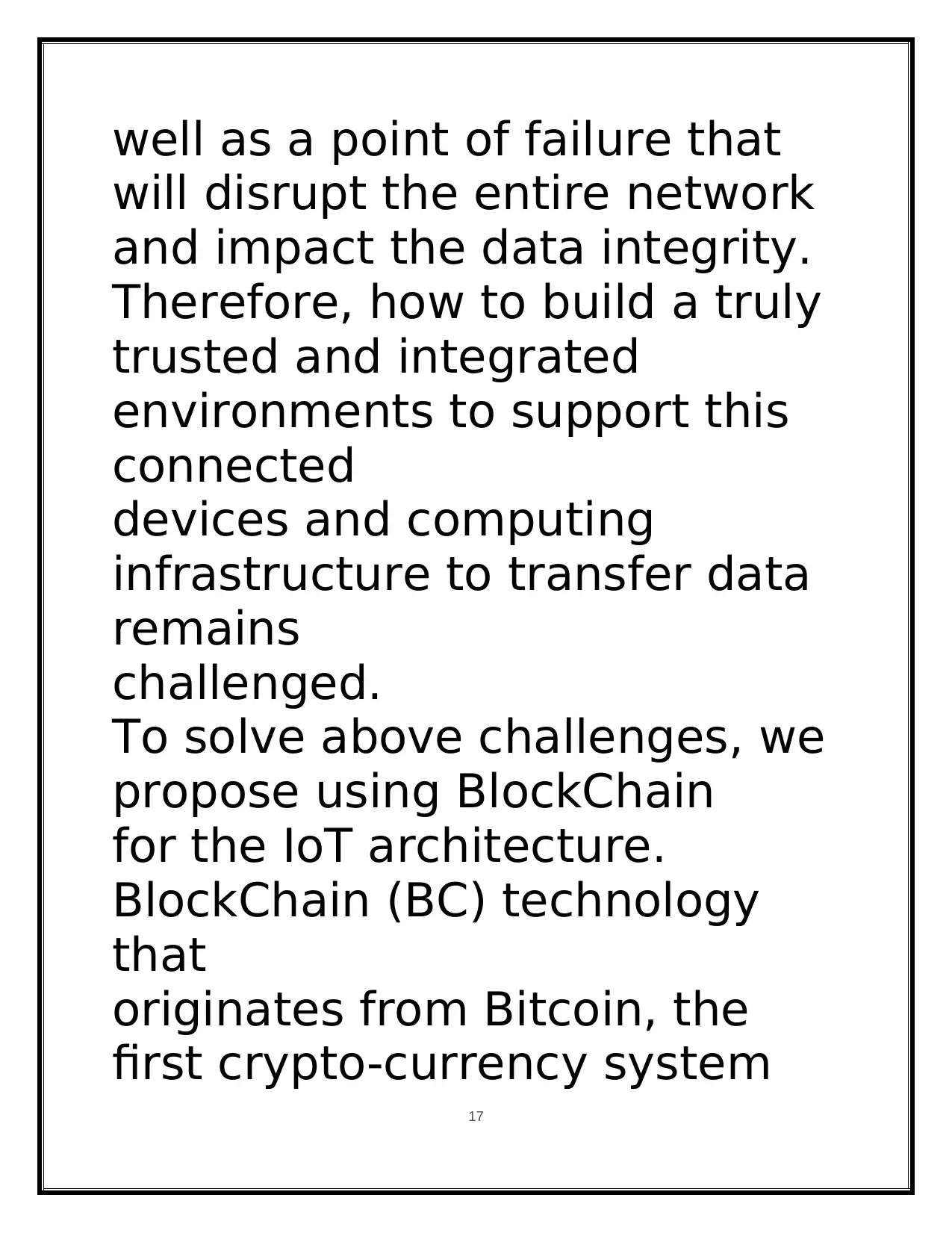
well as a point of failure that
will disrupt the entire network
and impact the data integrity.
Therefore, how to build a truly
trusted and integrated
environments to support this
connected
devices and computing
infrastructure to transfer data
remains
challenged.
To solve above challenges, we
propose using BlockChain
for the IoT architecture.
BlockChain (BC) technology
that
originates from Bitcoin, the
first crypto-currency system
17
will disrupt the entire network
and impact the data integrity.
Therefore, how to build a truly
trusted and integrated
environments to support this
connected
devices and computing
infrastructure to transfer data
remains
challenged.
To solve above challenges, we
propose using BlockChain
for the IoT architecture.
BlockChain (BC) technology
that
originates from Bitcoin, the
first crypto-currency system
17
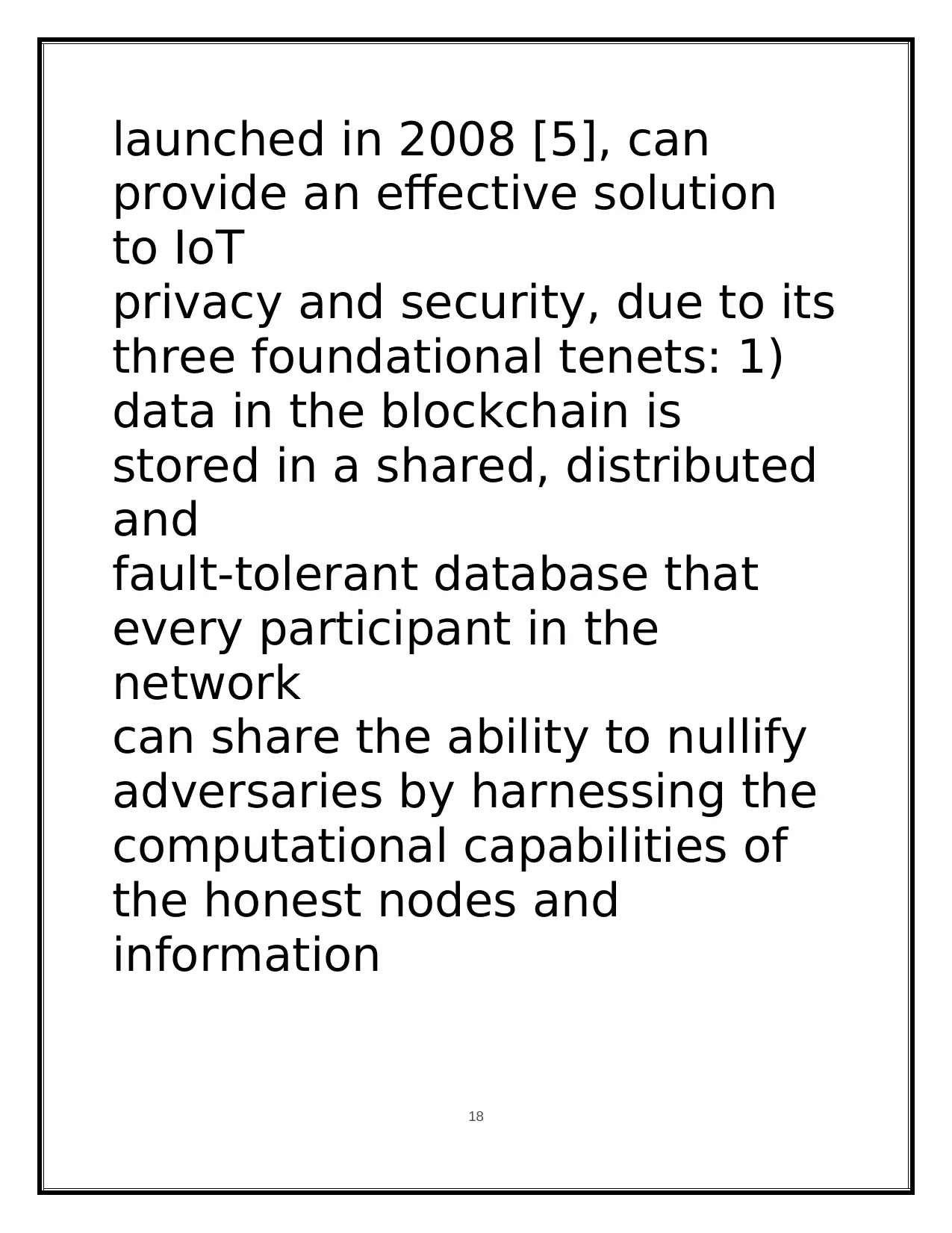
launched in 2008 [5], can
provide an effective solution
to IoT
privacy and security, due to its
three foundational tenets: 1)
data in the blockchain is
stored in a shared, distributed
and
fault-tolerant database that
every participant in the
network
can share the ability to nullify
adversaries by harnessing the
computational capabilities of
the honest nodes and
information
18
provide an effective solution
to IoT
privacy and security, due to its
three foundational tenets: 1)
data in the blockchain is
stored in a shared, distributed
and
fault-tolerant database that
every participant in the
network
can share the ability to nullify
adversaries by harnessing the
computational capabilities of
the honest nodes and
information
18

exchanged is resilient to
manipulation, 2) Blockchain is
a
decentralized architecture to
make the architectures robust
against any failures and
attacks and, 3) Blockchain
relies
on public key infrastructure
which allows the contents to
be
encrypted in a way that is
expensive to crack. With
blockchain-
based IoT architecture, all
data operations are
transparently
19
manipulation, 2) Blockchain is
a
decentralized architecture to
make the architectures robust
against any failures and
attacks and, 3) Blockchain
relies
on public key infrastructure
which allows the contents to
be
encrypted in a way that is
expensive to crack. With
blockchain-
based IoT architecture, all
data operations are
transparently
19
Secure Best Marks with AI Grader
Need help grading? Try our AI Grader for instant feedback on your assignments.
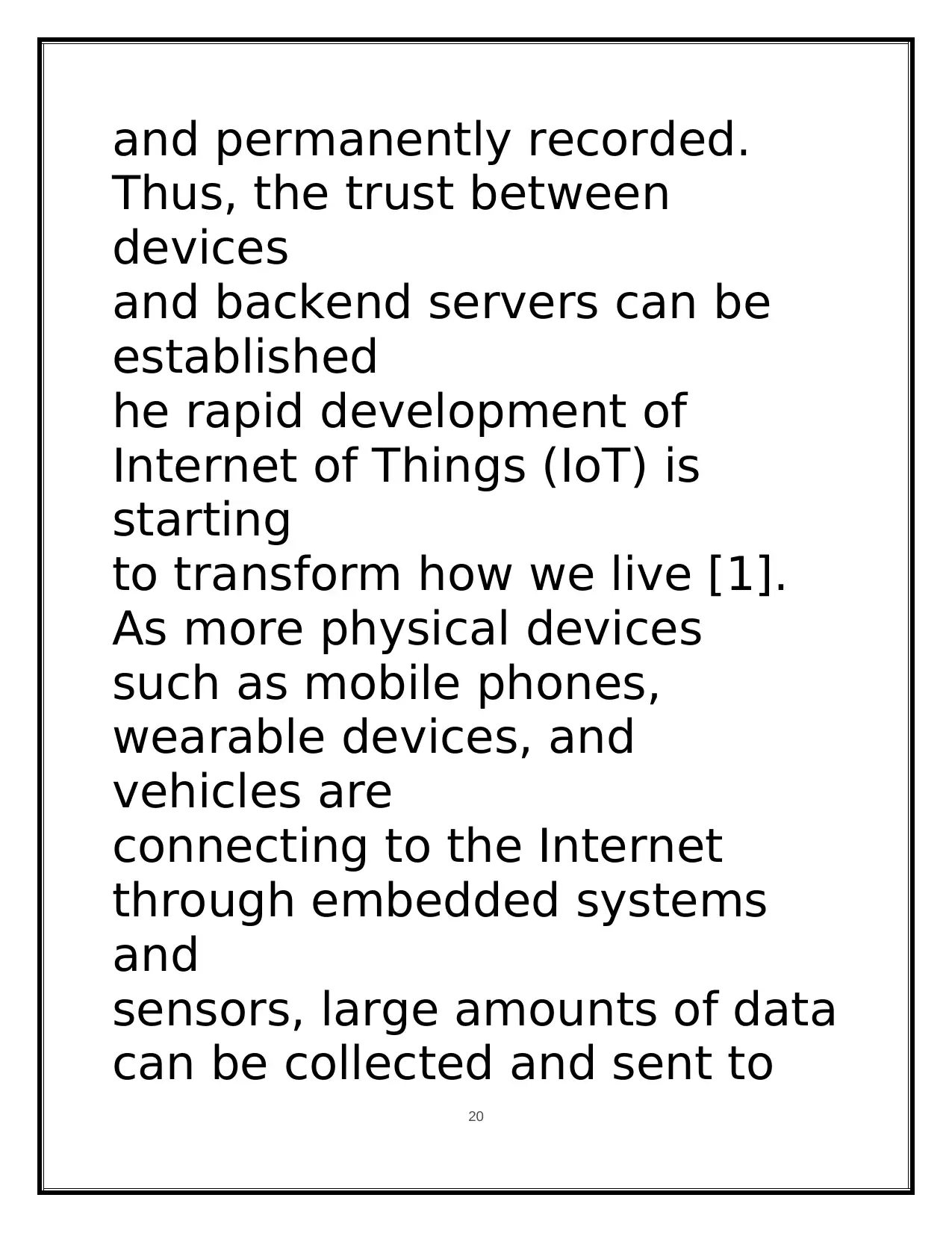
and permanently recorded.
Thus, the trust between
devices
and backend servers can be
established
he rapid development of
Internet of Things (IoT) is
starting
to transform how we live [1].
As more physical devices
such as mobile phones,
wearable devices, and
vehicles are
connecting to the Internet
through embedded systems
and
sensors, large amounts of data
can be collected and sent to
20
Thus, the trust between
devices
and backend servers can be
established
he rapid development of
Internet of Things (IoT) is
starting
to transform how we live [1].
As more physical devices
such as mobile phones,
wearable devices, and
vehicles are
connecting to the Internet
through embedded systems
and
sensors, large amounts of data
can be collected and sent to
20
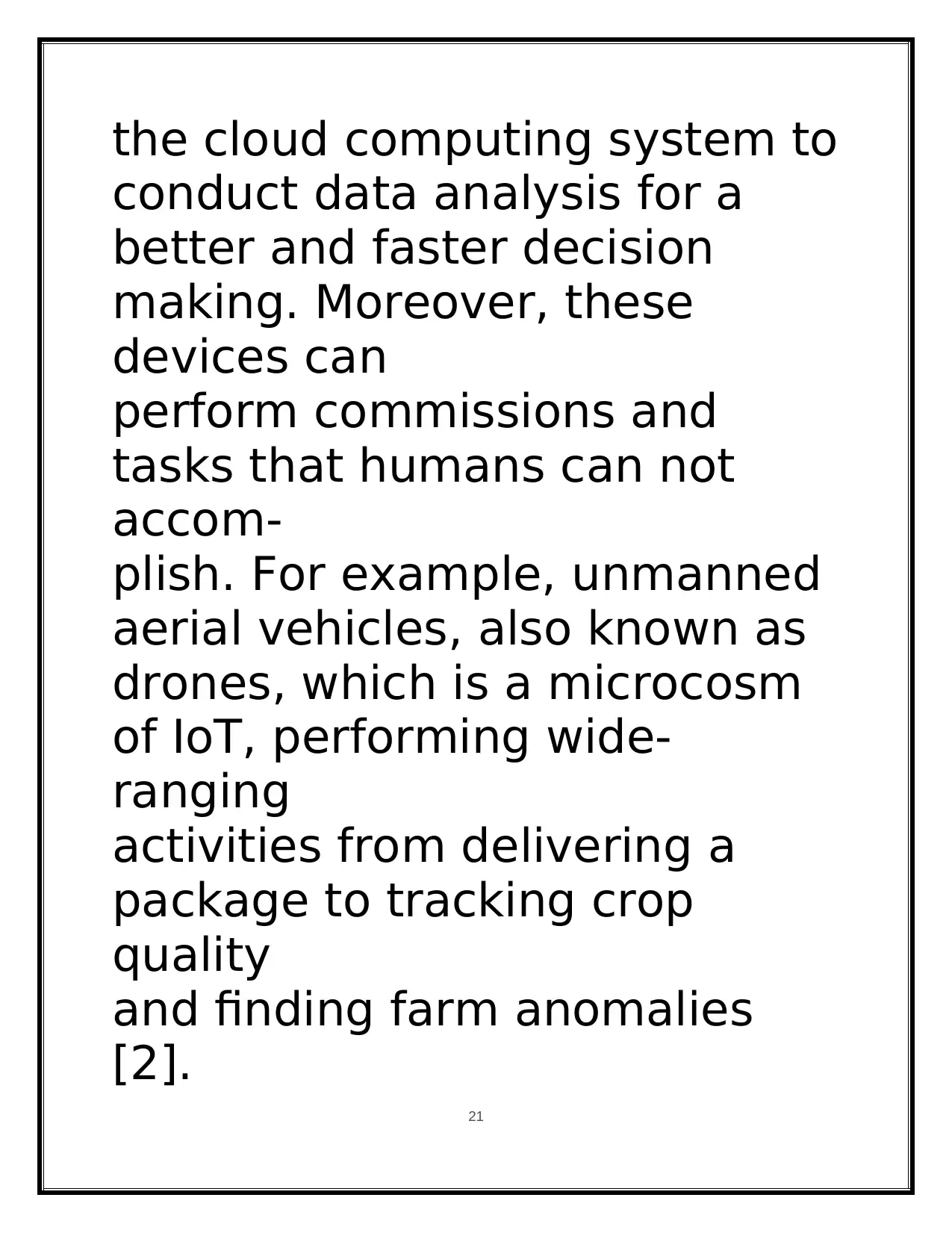
the cloud computing system to
conduct data analysis for a
better and faster decision
making. Moreover, these
devices can
perform commissions and
tasks that humans can not
accom-
plish. For example, unmanned
aerial vehicles, also known as
drones, which is a microcosm
of IoT, performing wide-
ranging
activities from delivering a
package to tracking crop
quality
and finding farm anomalies
[2]. 21
conduct data analysis for a
better and faster decision
making. Moreover, these
devices can
perform commissions and
tasks that humans can not
accom-
plish. For example, unmanned
aerial vehicles, also known as
drones, which is a microcosm
of IoT, performing wide-
ranging
activities from delivering a
package to tracking crop
quality
and finding farm anomalies
[2]. 21
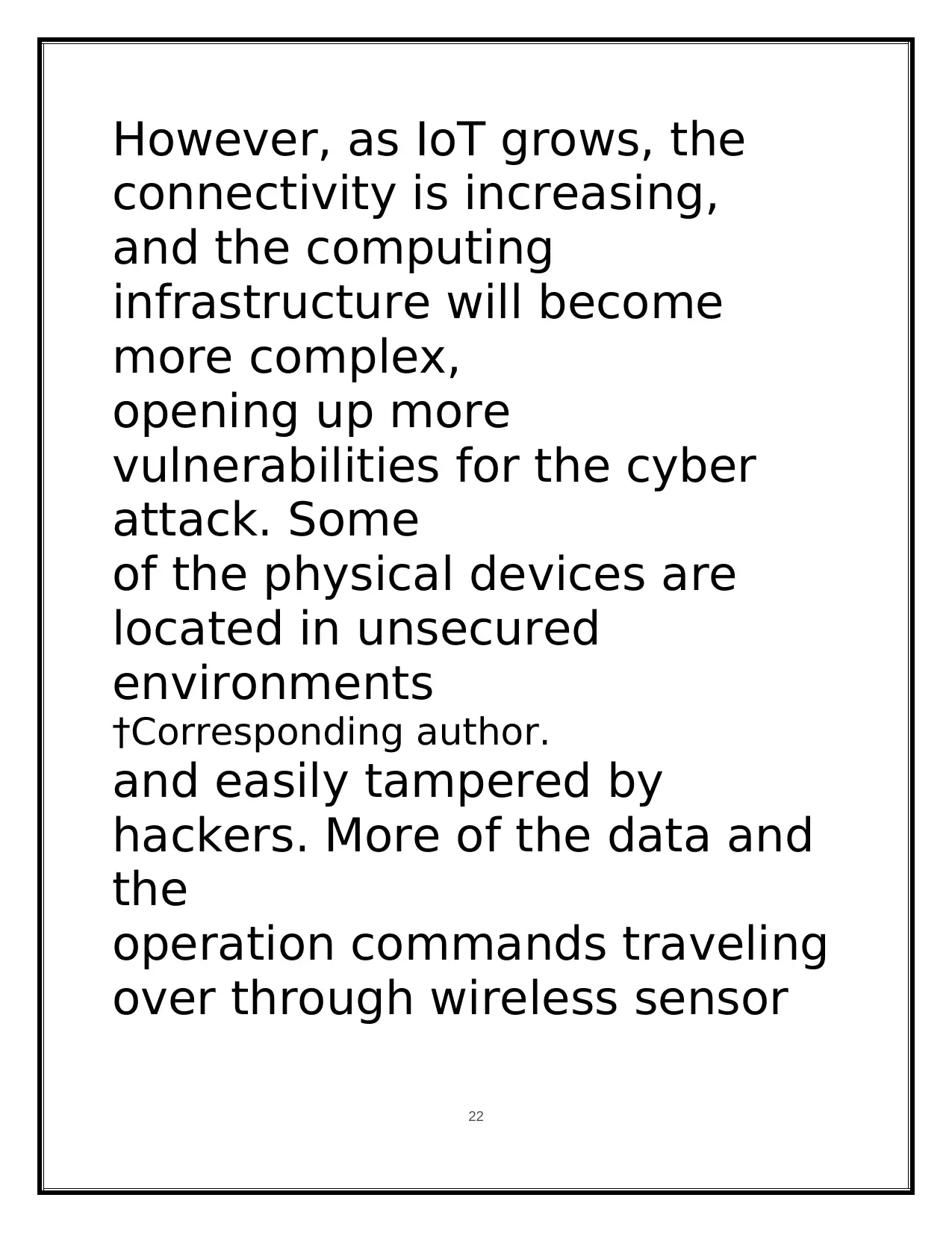
However, as IoT grows, the
connectivity is increasing,
and the computing
infrastructure will become
more complex,
opening up more
vulnerabilities for the cyber
attack. Some
of the physical devices are
located in unsecured
environments
†Corresponding author.
and easily tampered by
hackers. More of the data and
the
operation commands traveling
over through wireless sensor
22
connectivity is increasing,
and the computing
infrastructure will become
more complex,
opening up more
vulnerabilities for the cyber
attack. Some
of the physical devices are
located in unsecured
environments
†Corresponding author.
and easily tampered by
hackers. More of the data and
the
operation commands traveling
over through wireless sensor
22
Paraphrase This Document
Need a fresh take? Get an instant paraphrase of this document with our AI Paraphraser
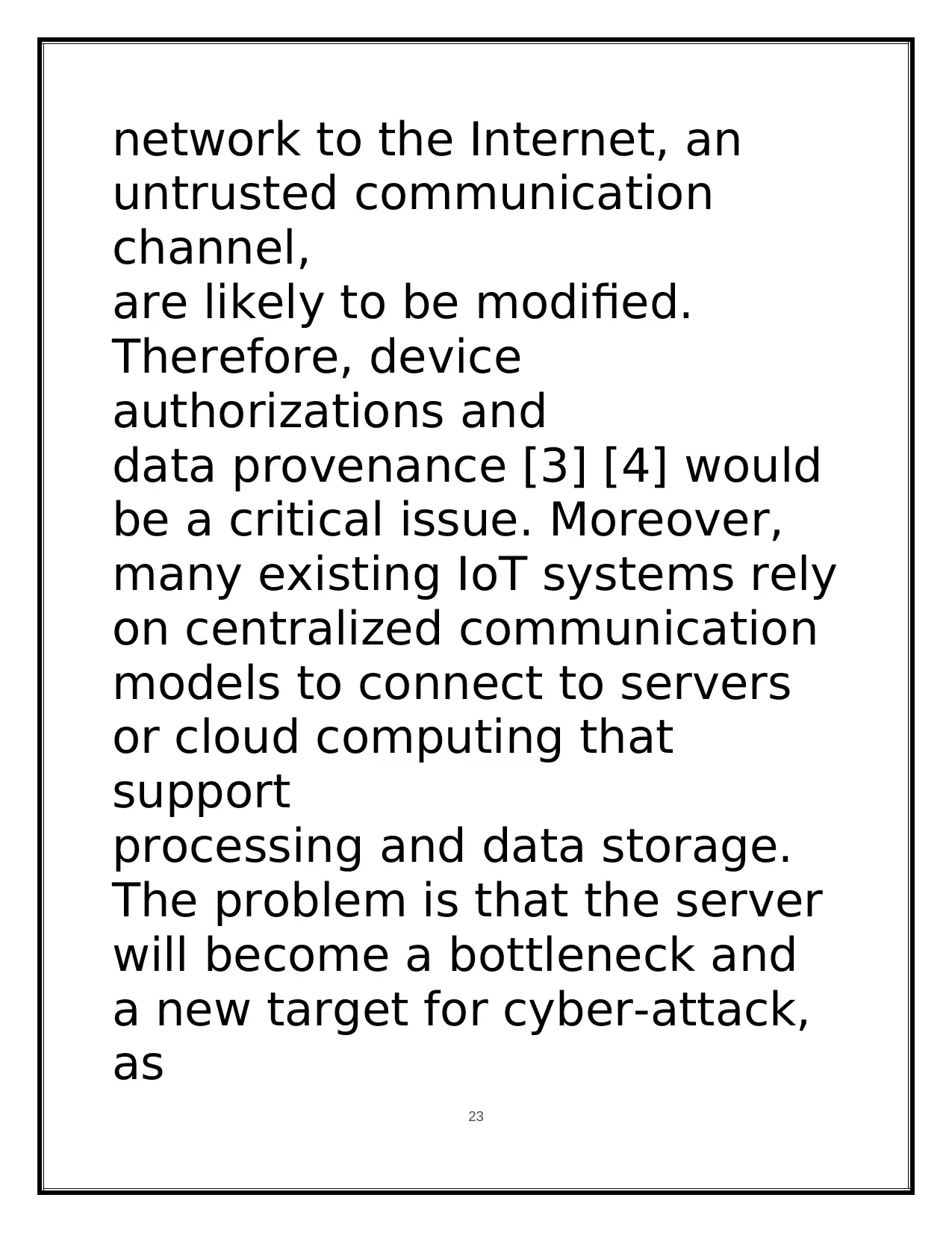
network to the Internet, an
untrusted communication
channel,
are likely to be modified.
Therefore, device
authorizations and
data provenance [3] [4] would
be a critical issue. Moreover,
many existing IoT systems rely
on centralized communication
models to connect to servers
or cloud computing that
support
processing and data storage.
The problem is that the server
will become a bottleneck and
a new target for cyber-attack,
as 23
untrusted communication
channel,
are likely to be modified.
Therefore, device
authorizations and
data provenance [3] [4] would
be a critical issue. Moreover,
many existing IoT systems rely
on centralized communication
models to connect to servers
or cloud computing that
support
processing and data storage.
The problem is that the server
will become a bottleneck and
a new target for cyber-attack,
as 23
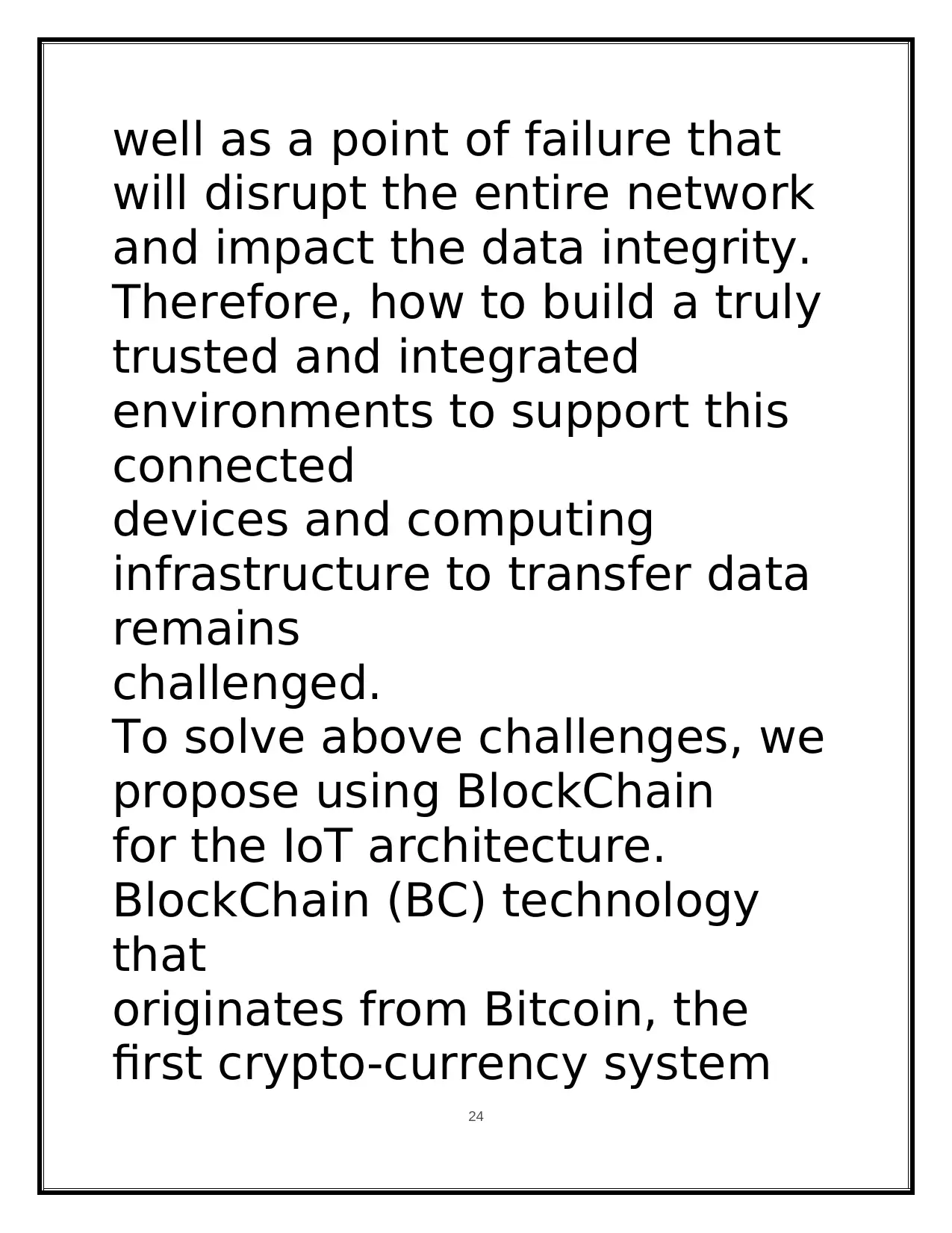
well as a point of failure that
will disrupt the entire network
and impact the data integrity.
Therefore, how to build a truly
trusted and integrated
environments to support this
connected
devices and computing
infrastructure to transfer data
remains
challenged.
To solve above challenges, we
propose using BlockChain
for the IoT architecture.
BlockChain (BC) technology
that
originates from Bitcoin, the
first crypto-currency system
24
will disrupt the entire network
and impact the data integrity.
Therefore, how to build a truly
trusted and integrated
environments to support this
connected
devices and computing
infrastructure to transfer data
remains
challenged.
To solve above challenges, we
propose using BlockChain
for the IoT architecture.
BlockChain (BC) technology
that
originates from Bitcoin, the
first crypto-currency system
24
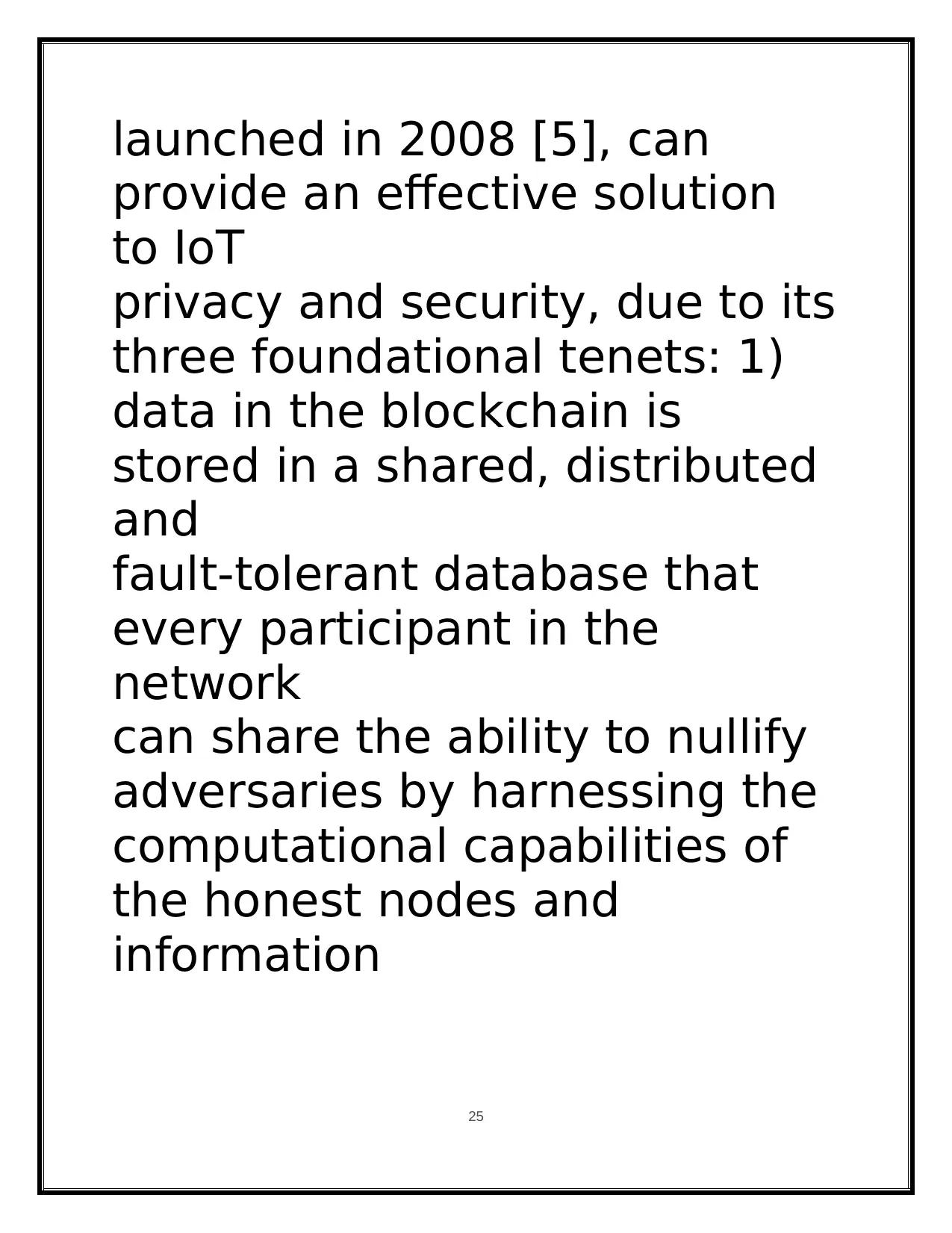
launched in 2008 [5], can
provide an effective solution
to IoT
privacy and security, due to its
three foundational tenets: 1)
data in the blockchain is
stored in a shared, distributed
and
fault-tolerant database that
every participant in the
network
can share the ability to nullify
adversaries by harnessing the
computational capabilities of
the honest nodes and
information
25
provide an effective solution
to IoT
privacy and security, due to its
three foundational tenets: 1)
data in the blockchain is
stored in a shared, distributed
and
fault-tolerant database that
every participant in the
network
can share the ability to nullify
adversaries by harnessing the
computational capabilities of
the honest nodes and
information
25
Secure Best Marks with AI Grader
Need help grading? Try our AI Grader for instant feedback on your assignments.
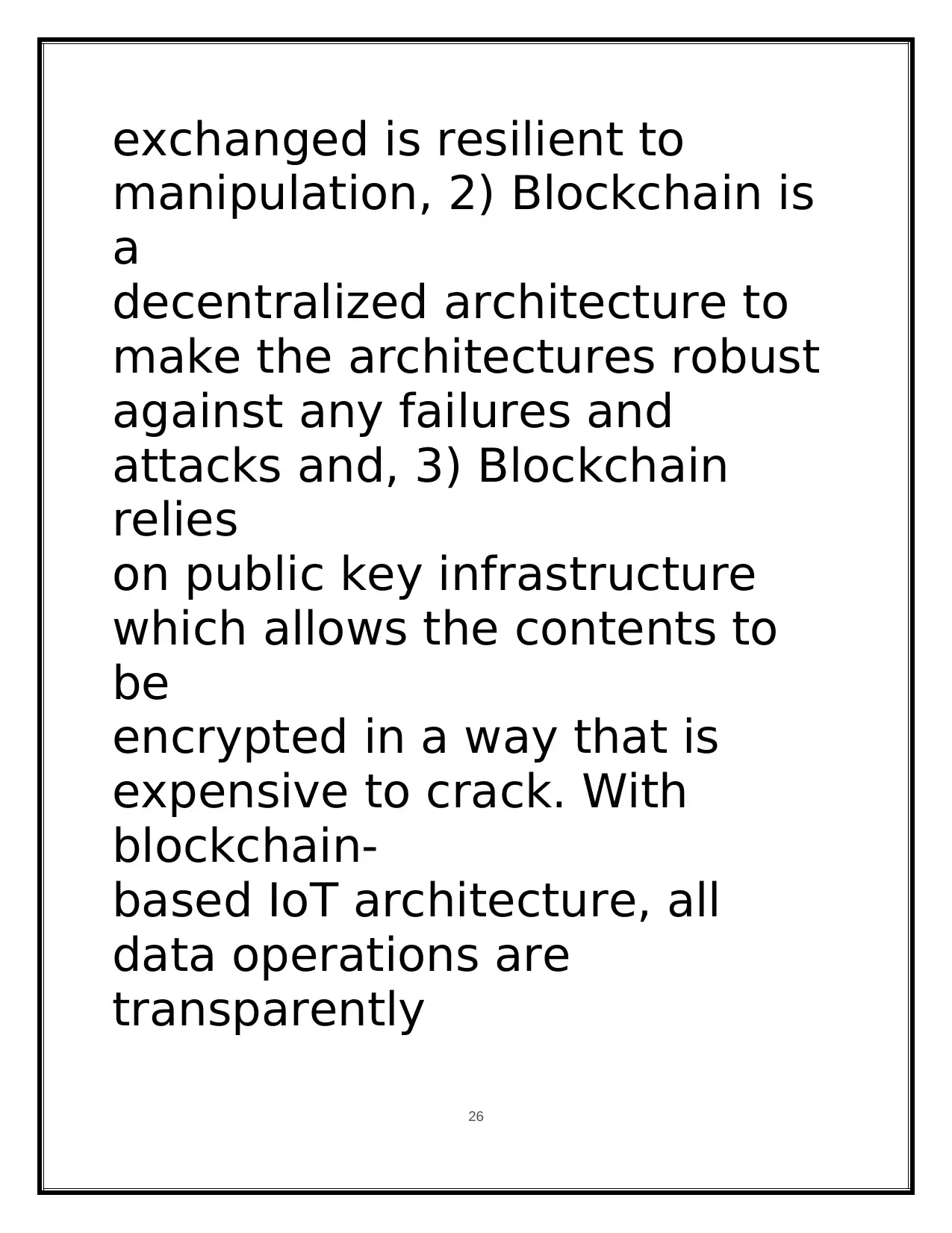
exchanged is resilient to
manipulation, 2) Blockchain is
a
decentralized architecture to
make the architectures robust
against any failures and
attacks and, 3) Blockchain
relies
on public key infrastructure
which allows the contents to
be
encrypted in a way that is
expensive to crack. With
blockchain-
based IoT architecture, all
data operations are
transparently
26
manipulation, 2) Blockchain is
a
decentralized architecture to
make the architectures robust
against any failures and
attacks and, 3) Blockchain
relies
on public key infrastructure
which allows the contents to
be
encrypted in a way that is
expensive to crack. With
blockchain-
based IoT architecture, all
data operations are
transparently
26

and permanently recorded.
Thus, the trust between
devices
and backend servers can be
established
he rapid development of
Internet of Things (IoT) is
starting
to transform how we live [1].
As more physical devices
such as mobile phones,
wearable devices, and
vehicles are
connecting to the Internet
through embedded systems
and
sensors, large amounts of data
can be collected and sent to
27
Thus, the trust between
devices
and backend servers can be
established
he rapid development of
Internet of Things (IoT) is
starting
to transform how we live [1].
As more physical devices
such as mobile phones,
wearable devices, and
vehicles are
connecting to the Internet
through embedded systems
and
sensors, large amounts of data
can be collected and sent to
27
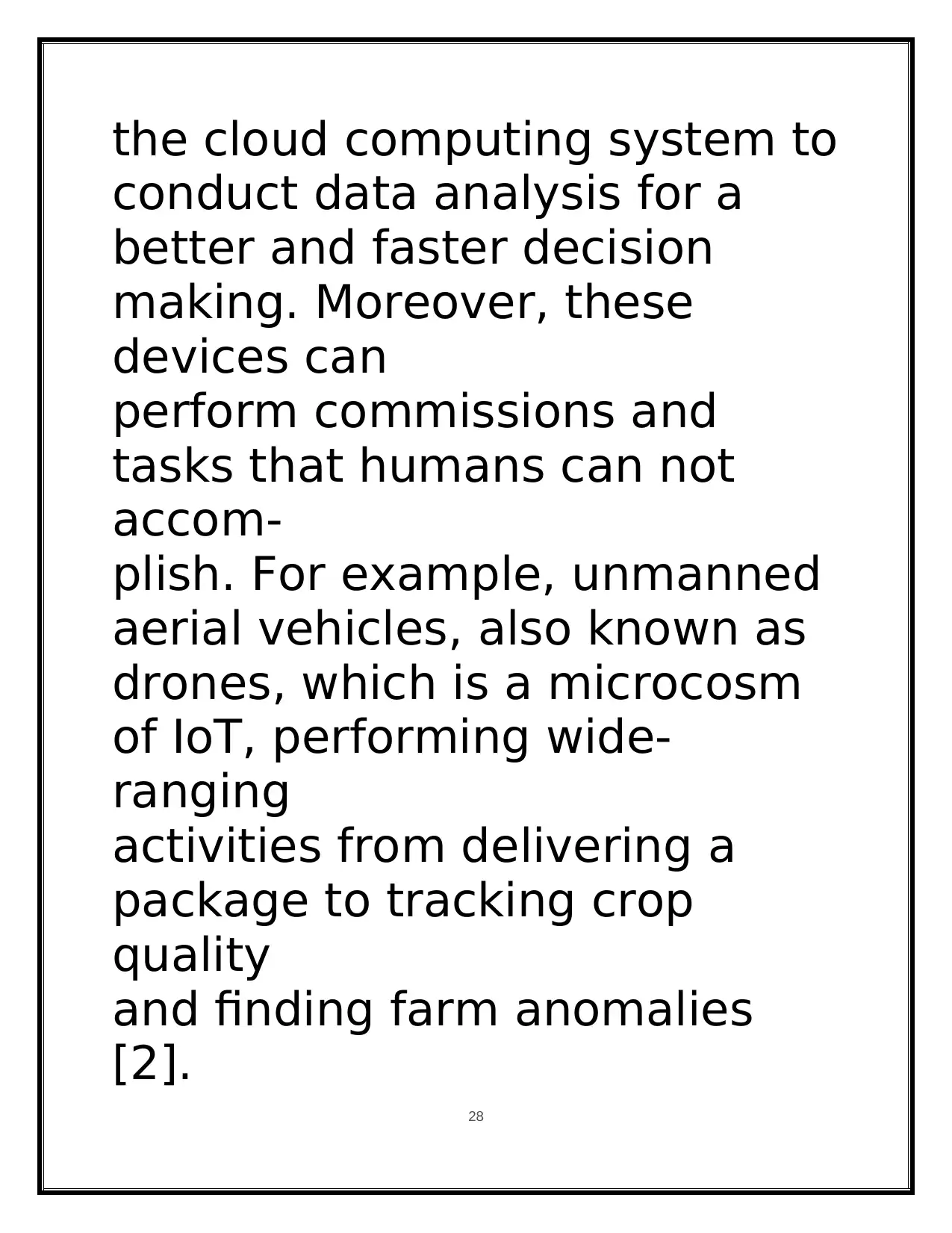
the cloud computing system to
conduct data analysis for a
better and faster decision
making. Moreover, these
devices can
perform commissions and
tasks that humans can not
accom-
plish. For example, unmanned
aerial vehicles, also known as
drones, which is a microcosm
of IoT, performing wide-
ranging
activities from delivering a
package to tracking crop
quality
and finding farm anomalies
[2]. 28
conduct data analysis for a
better and faster decision
making. Moreover, these
devices can
perform commissions and
tasks that humans can not
accom-
plish. For example, unmanned
aerial vehicles, also known as
drones, which is a microcosm
of IoT, performing wide-
ranging
activities from delivering a
package to tracking crop
quality
and finding farm anomalies
[2]. 28
Paraphrase This Document
Need a fresh take? Get an instant paraphrase of this document with our AI Paraphraser
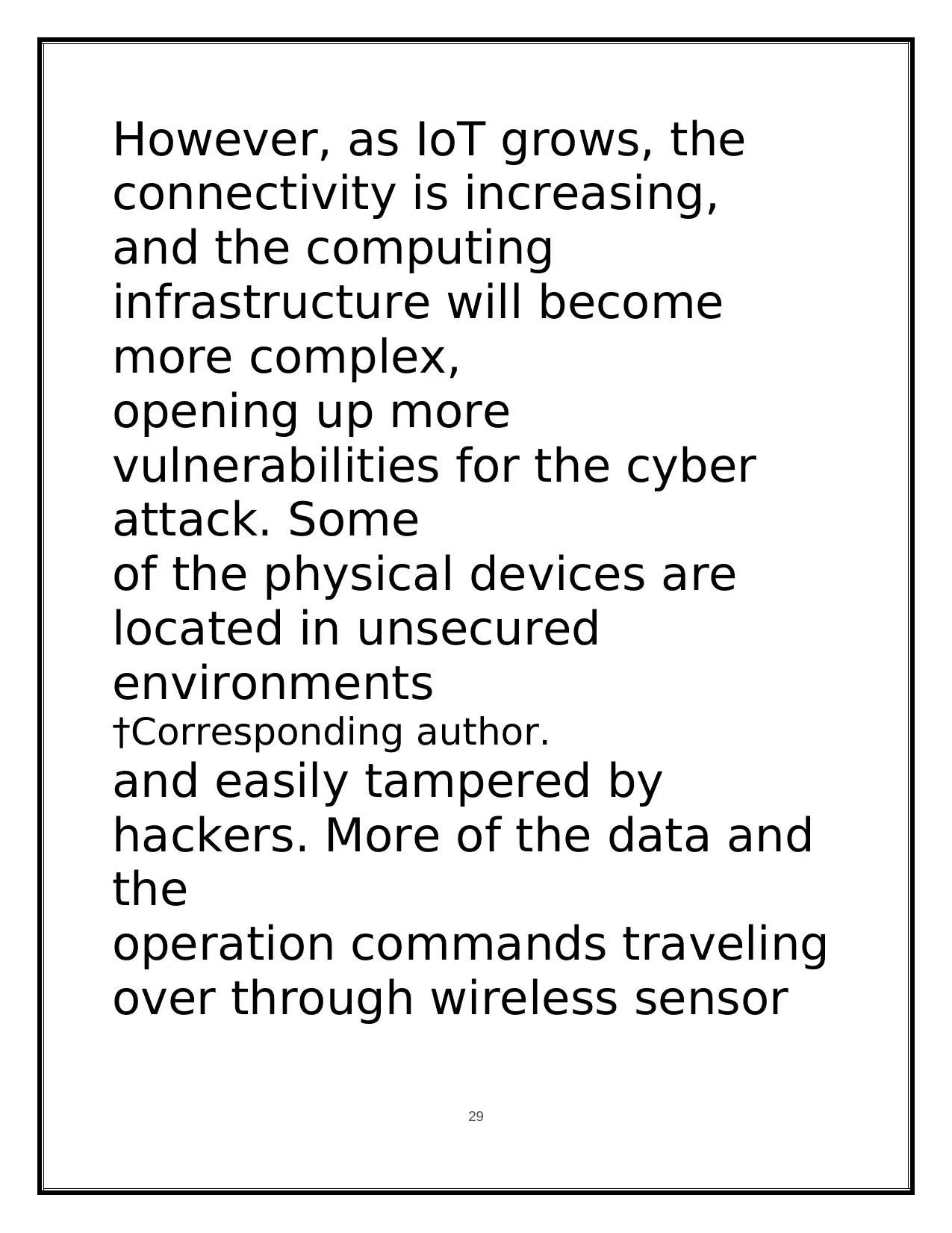
However, as IoT grows, the
connectivity is increasing,
and the computing
infrastructure will become
more complex,
opening up more
vulnerabilities for the cyber
attack. Some
of the physical devices are
located in unsecured
environments
†Corresponding author.
and easily tampered by
hackers. More of the data and
the
operation commands traveling
over through wireless sensor
29
connectivity is increasing,
and the computing
infrastructure will become
more complex,
opening up more
vulnerabilities for the cyber
attack. Some
of the physical devices are
located in unsecured
environments
†Corresponding author.
and easily tampered by
hackers. More of the data and
the
operation commands traveling
over through wireless sensor
29
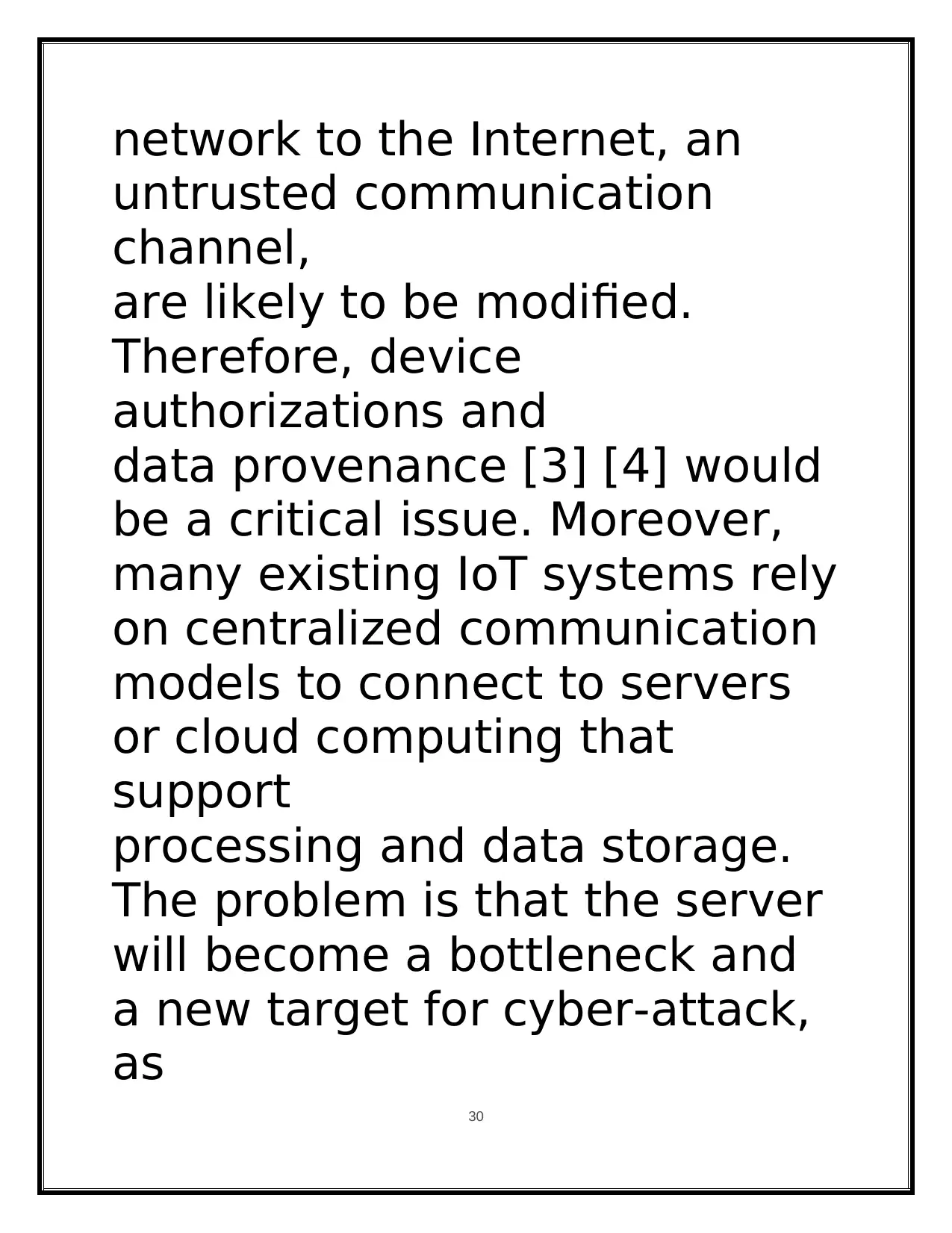
network to the Internet, an
untrusted communication
channel,
are likely to be modified.
Therefore, device
authorizations and
data provenance [3] [4] would
be a critical issue. Moreover,
many existing IoT systems rely
on centralized communication
models to connect to servers
or cloud computing that
support
processing and data storage.
The problem is that the server
will become a bottleneck and
a new target for cyber-attack,
as 30
untrusted communication
channel,
are likely to be modified.
Therefore, device
authorizations and
data provenance [3] [4] would
be a critical issue. Moreover,
many existing IoT systems rely
on centralized communication
models to connect to servers
or cloud computing that
support
processing and data storage.
The problem is that the server
will become a bottleneck and
a new target for cyber-attack,
as 30
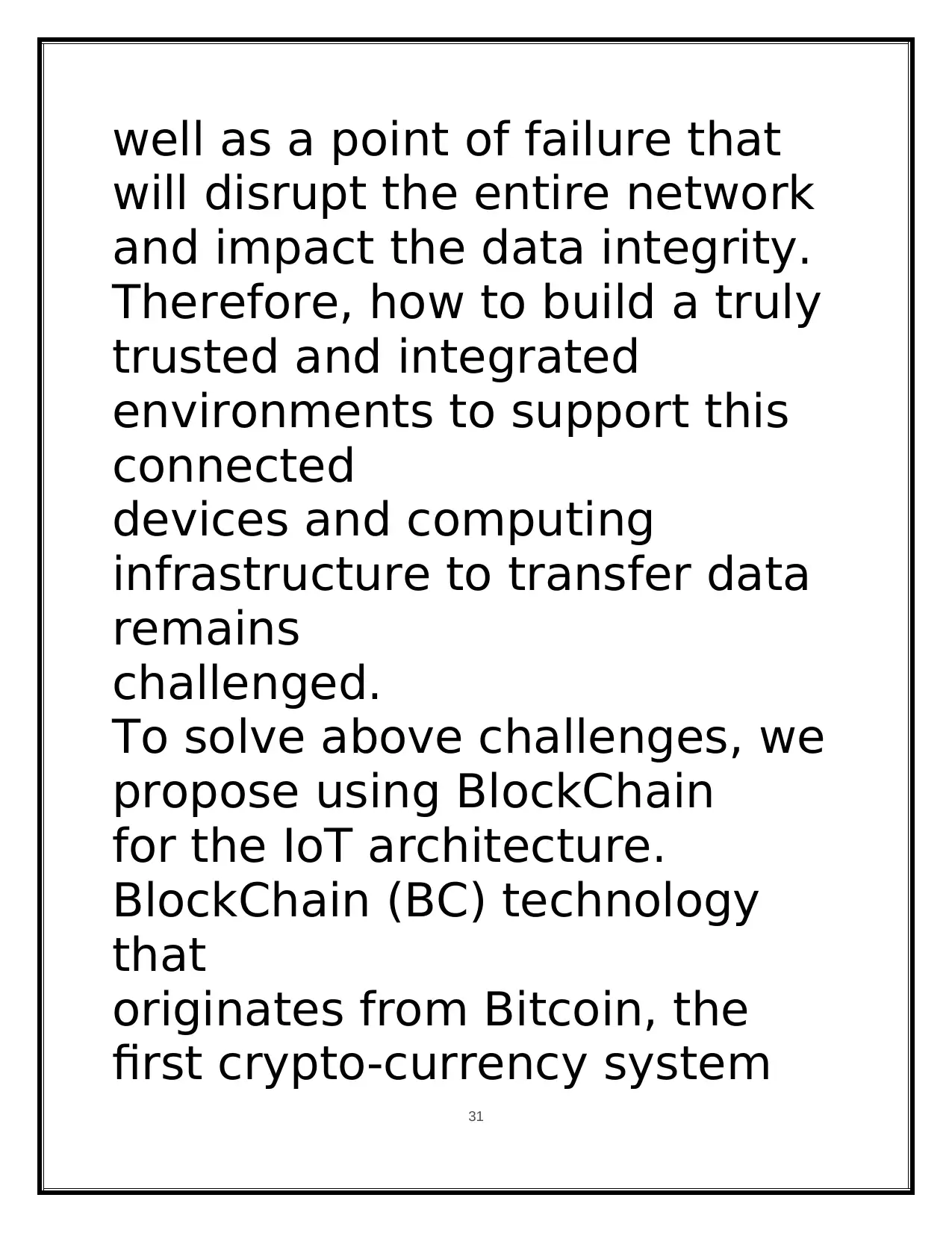
well as a point of failure that
will disrupt the entire network
and impact the data integrity.
Therefore, how to build a truly
trusted and integrated
environments to support this
connected
devices and computing
infrastructure to transfer data
remains
challenged.
To solve above challenges, we
propose using BlockChain
for the IoT architecture.
BlockChain (BC) technology
that
originates from Bitcoin, the
first crypto-currency system
31
will disrupt the entire network
and impact the data integrity.
Therefore, how to build a truly
trusted and integrated
environments to support this
connected
devices and computing
infrastructure to transfer data
remains
challenged.
To solve above challenges, we
propose using BlockChain
for the IoT architecture.
BlockChain (BC) technology
that
originates from Bitcoin, the
first crypto-currency system
31
Secure Best Marks with AI Grader
Need help grading? Try our AI Grader for instant feedback on your assignments.
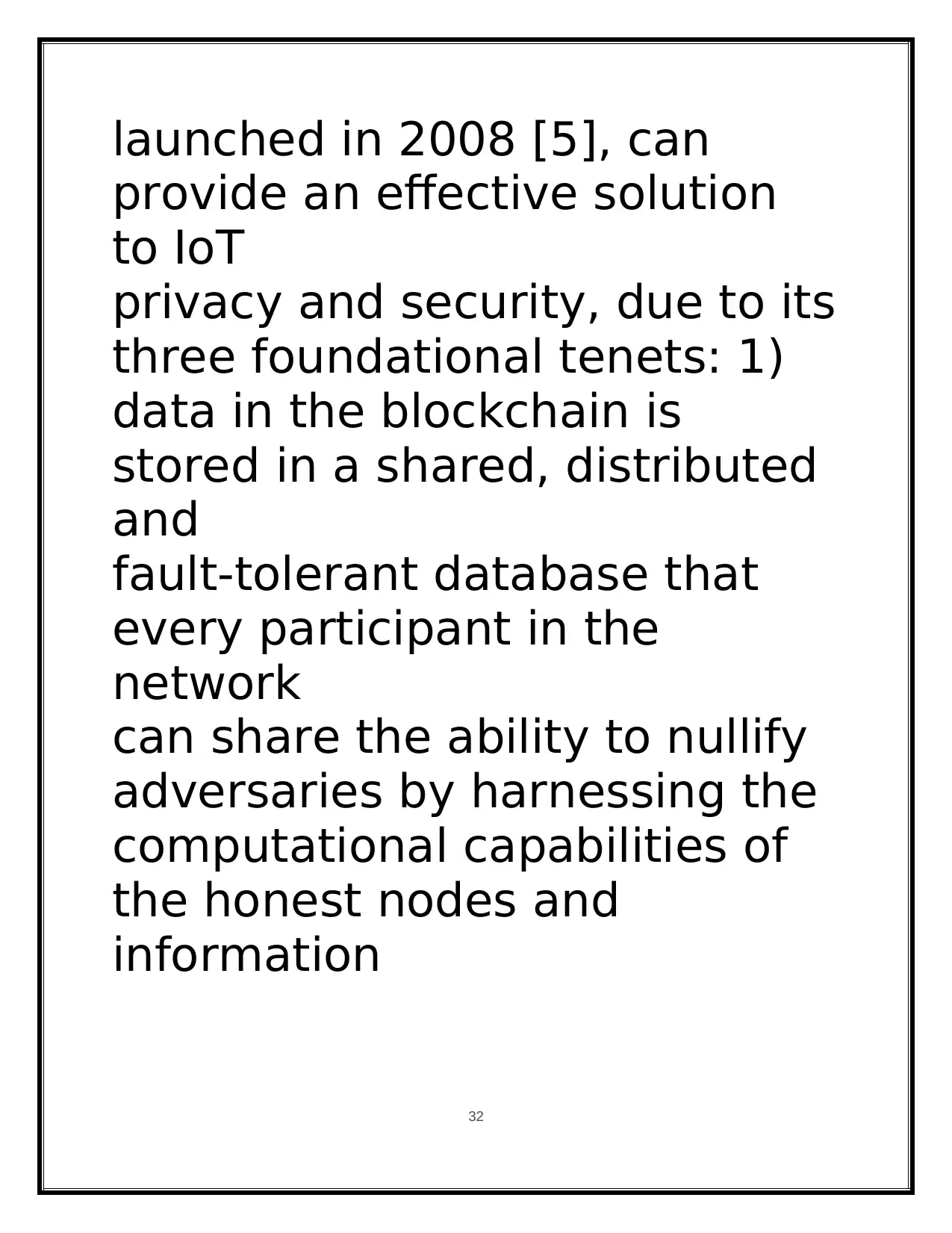
launched in 2008 [5], can
provide an effective solution
to IoT
privacy and security, due to its
three foundational tenets: 1)
data in the blockchain is
stored in a shared, distributed
and
fault-tolerant database that
every participant in the
network
can share the ability to nullify
adversaries by harnessing the
computational capabilities of
the honest nodes and
information
32
provide an effective solution
to IoT
privacy and security, due to its
three foundational tenets: 1)
data in the blockchain is
stored in a shared, distributed
and
fault-tolerant database that
every participant in the
network
can share the ability to nullify
adversaries by harnessing the
computational capabilities of
the honest nodes and
information
32
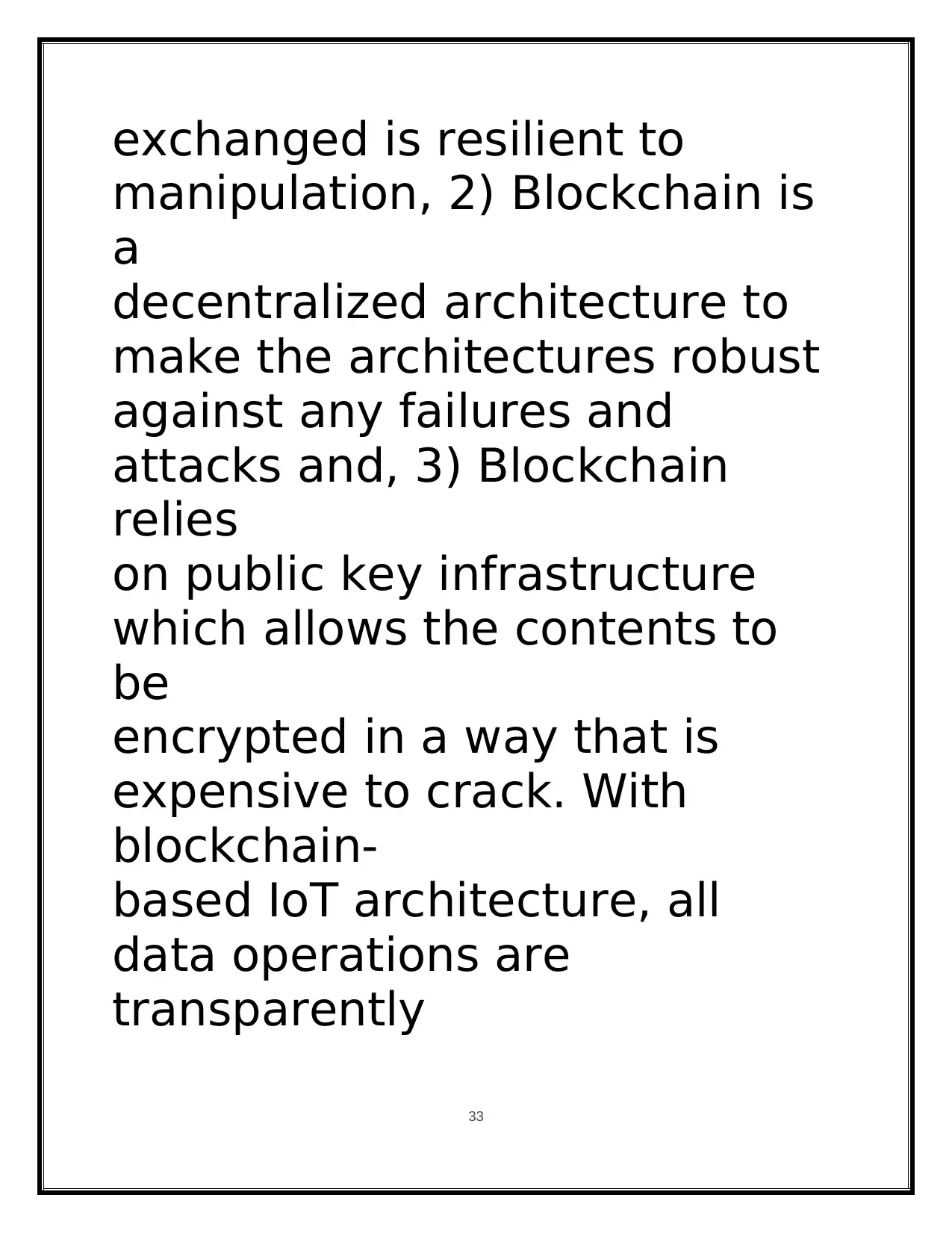
exchanged is resilient to
manipulation, 2) Blockchain is
a
decentralized architecture to
make the architectures robust
against any failures and
attacks and, 3) Blockchain
relies
on public key infrastructure
which allows the contents to
be
encrypted in a way that is
expensive to crack. With
blockchain-
based IoT architecture, all
data operations are
transparently
33
manipulation, 2) Blockchain is
a
decentralized architecture to
make the architectures robust
against any failures and
attacks and, 3) Blockchain
relies
on public key infrastructure
which allows the contents to
be
encrypted in a way that is
expensive to crack. With
blockchain-
based IoT architecture, all
data operations are
transparently
33

and permanently recorded.
Thus, the trust between
devices
and backend servers can be
established
he rapid development of
Internet of Things (IoT) is
starting
to transform how we live [1].
As more physical devices
such as mobile phones,
wearable devices, and
vehicles are
connecting to the Internet
through embedded systems
and
sensors, large amounts of data
can be collected and sent to
34
Thus, the trust between
devices
and backend servers can be
established
he rapid development of
Internet of Things (IoT) is
starting
to transform how we live [1].
As more physical devices
such as mobile phones,
wearable devices, and
vehicles are
connecting to the Internet
through embedded systems
and
sensors, large amounts of data
can be collected and sent to
34
Paraphrase This Document
Need a fresh take? Get an instant paraphrase of this document with our AI Paraphraser

the cloud computing system to
conduct data analysis for a
better and faster decision
making. Moreover, these
devices can
perform commissions and
tasks that humans can not
accom-
plish. For example, unmanned
aerial vehicles, also known as
drones, which is a microcosm
of IoT, performing wide-
ranging
activities from delivering a
package to tracking crop
quality
and finding farm anomalies
[2]. 35
conduct data analysis for a
better and faster decision
making. Moreover, these
devices can
perform commissions and
tasks that humans can not
accom-
plish. For example, unmanned
aerial vehicles, also known as
drones, which is a microcosm
of IoT, performing wide-
ranging
activities from delivering a
package to tracking crop
quality
and finding farm anomalies
[2]. 35
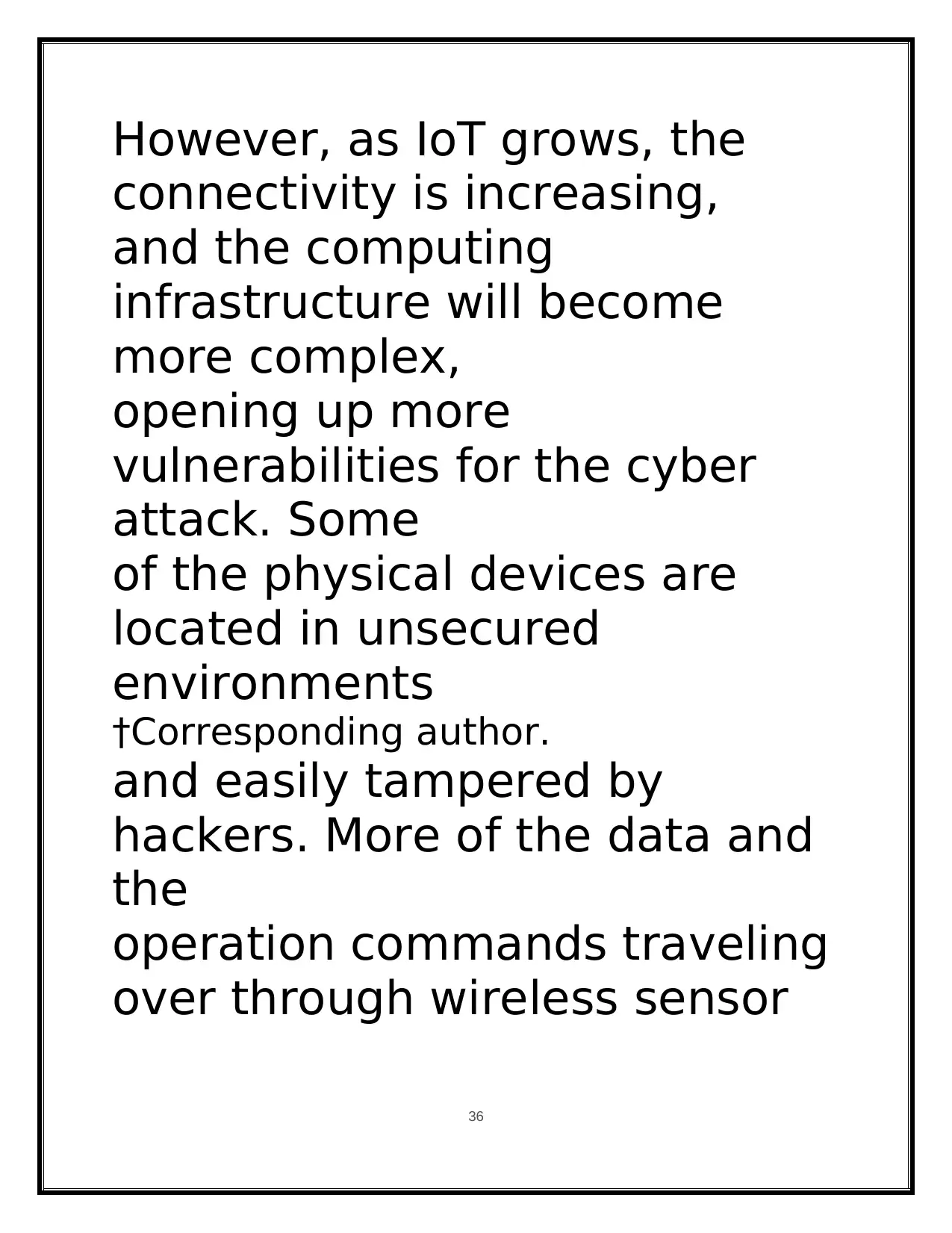
However, as IoT grows, the
connectivity is increasing,
and the computing
infrastructure will become
more complex,
opening up more
vulnerabilities for the cyber
attack. Some
of the physical devices are
located in unsecured
environments
†Corresponding author.
and easily tampered by
hackers. More of the data and
the
operation commands traveling
over through wireless sensor
36
connectivity is increasing,
and the computing
infrastructure will become
more complex,
opening up more
vulnerabilities for the cyber
attack. Some
of the physical devices are
located in unsecured
environments
†Corresponding author.
and easily tampered by
hackers. More of the data and
the
operation commands traveling
over through wireless sensor
36
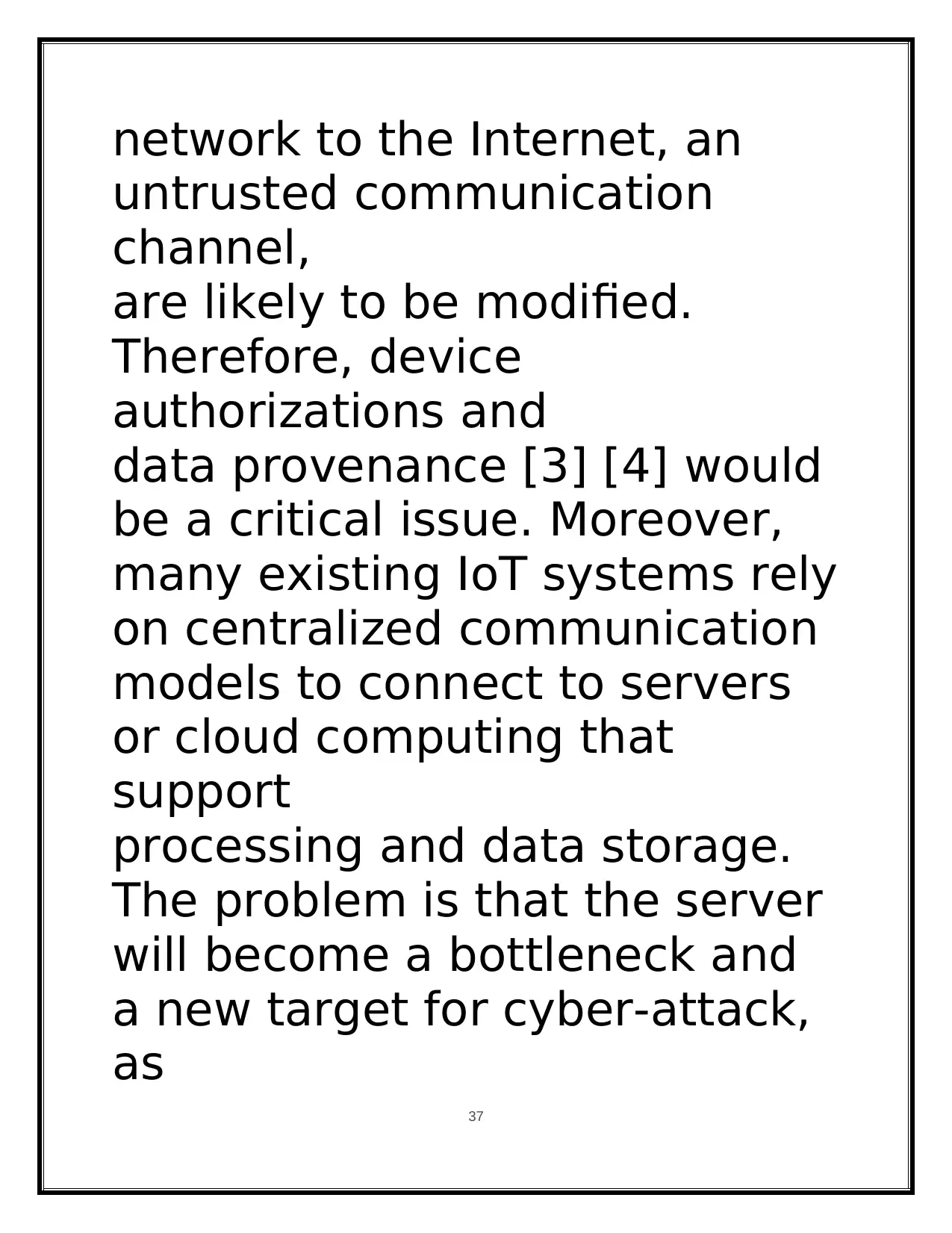
network to the Internet, an
untrusted communication
channel,
are likely to be modified.
Therefore, device
authorizations and
data provenance [3] [4] would
be a critical issue. Moreover,
many existing IoT systems rely
on centralized communication
models to connect to servers
or cloud computing that
support
processing and data storage.
The problem is that the server
will become a bottleneck and
a new target for cyber-attack,
as 37
untrusted communication
channel,
are likely to be modified.
Therefore, device
authorizations and
data provenance [3] [4] would
be a critical issue. Moreover,
many existing IoT systems rely
on centralized communication
models to connect to servers
or cloud computing that
support
processing and data storage.
The problem is that the server
will become a bottleneck and
a new target for cyber-attack,
as 37
Secure Best Marks with AI Grader
Need help grading? Try our AI Grader for instant feedback on your assignments.
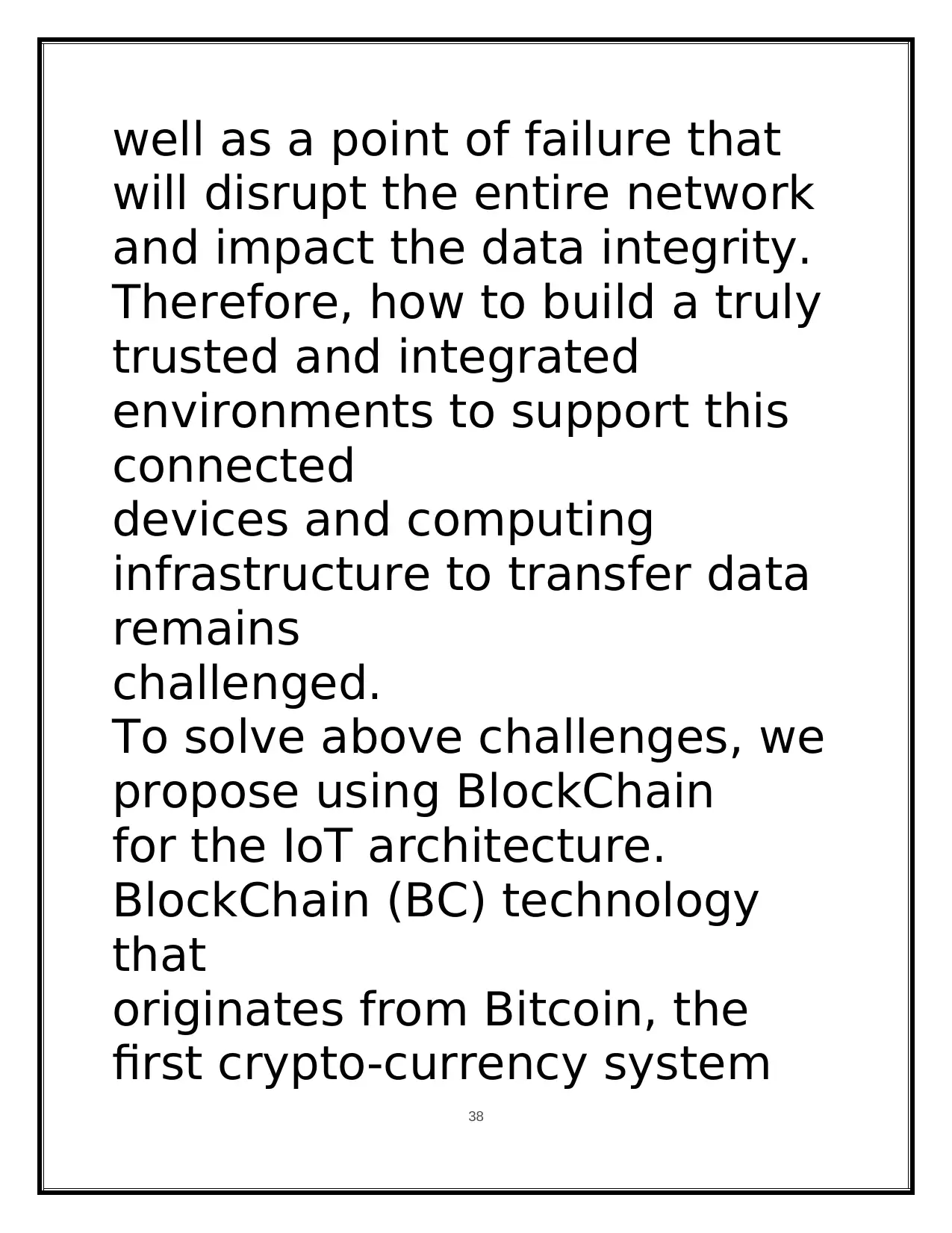
well as a point of failure that
will disrupt the entire network
and impact the data integrity.
Therefore, how to build a truly
trusted and integrated
environments to support this
connected
devices and computing
infrastructure to transfer data
remains
challenged.
To solve above challenges, we
propose using BlockChain
for the IoT architecture.
BlockChain (BC) technology
that
originates from Bitcoin, the
first crypto-currency system
38
will disrupt the entire network
and impact the data integrity.
Therefore, how to build a truly
trusted and integrated
environments to support this
connected
devices and computing
infrastructure to transfer data
remains
challenged.
To solve above challenges, we
propose using BlockChain
for the IoT architecture.
BlockChain (BC) technology
that
originates from Bitcoin, the
first crypto-currency system
38
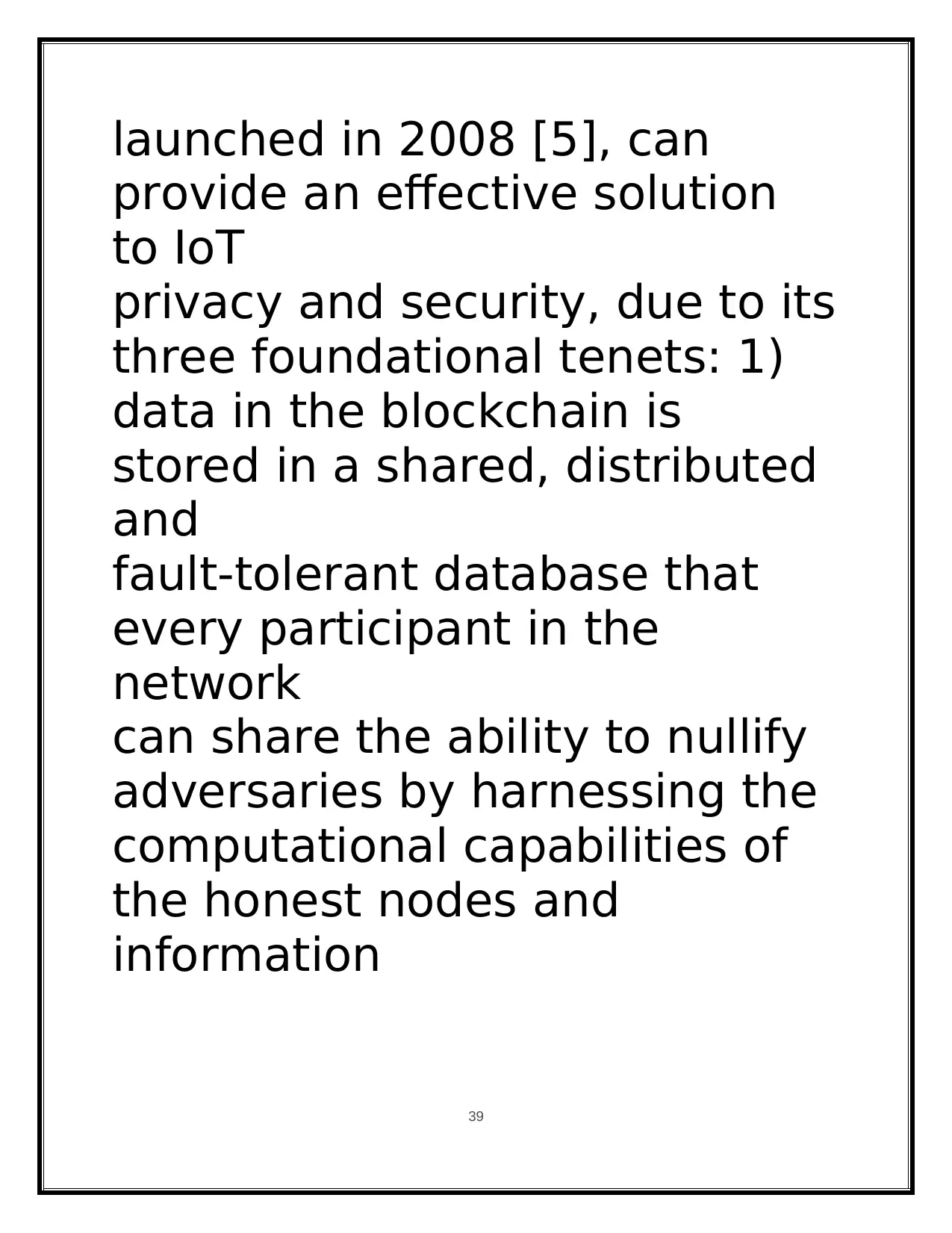
launched in 2008 [5], can
provide an effective solution
to IoT
privacy and security, due to its
three foundational tenets: 1)
data in the blockchain is
stored in a shared, distributed
and
fault-tolerant database that
every participant in the
network
can share the ability to nullify
adversaries by harnessing the
computational capabilities of
the honest nodes and
information
39
provide an effective solution
to IoT
privacy and security, due to its
three foundational tenets: 1)
data in the blockchain is
stored in a shared, distributed
and
fault-tolerant database that
every participant in the
network
can share the ability to nullify
adversaries by harnessing the
computational capabilities of
the honest nodes and
information
39
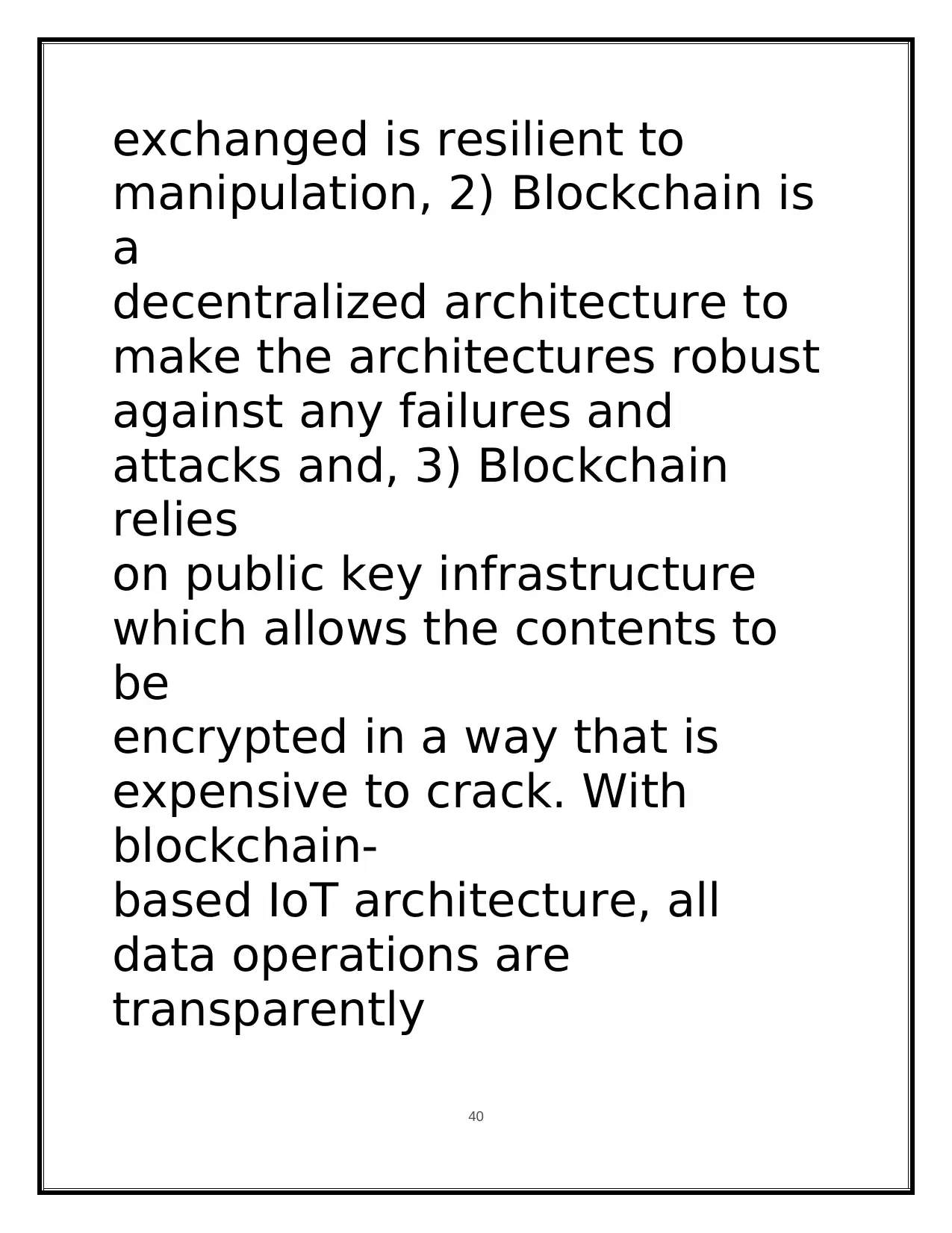
exchanged is resilient to
manipulation, 2) Blockchain is
a
decentralized architecture to
make the architectures robust
against any failures and
attacks and, 3) Blockchain
relies
on public key infrastructure
which allows the contents to
be
encrypted in a way that is
expensive to crack. With
blockchain-
based IoT architecture, all
data operations are
transparently
40
manipulation, 2) Blockchain is
a
decentralized architecture to
make the architectures robust
against any failures and
attacks and, 3) Blockchain
relies
on public key infrastructure
which allows the contents to
be
encrypted in a way that is
expensive to crack. With
blockchain-
based IoT architecture, all
data operations are
transparently
40
Paraphrase This Document
Need a fresh take? Get an instant paraphrase of this document with our AI Paraphraser
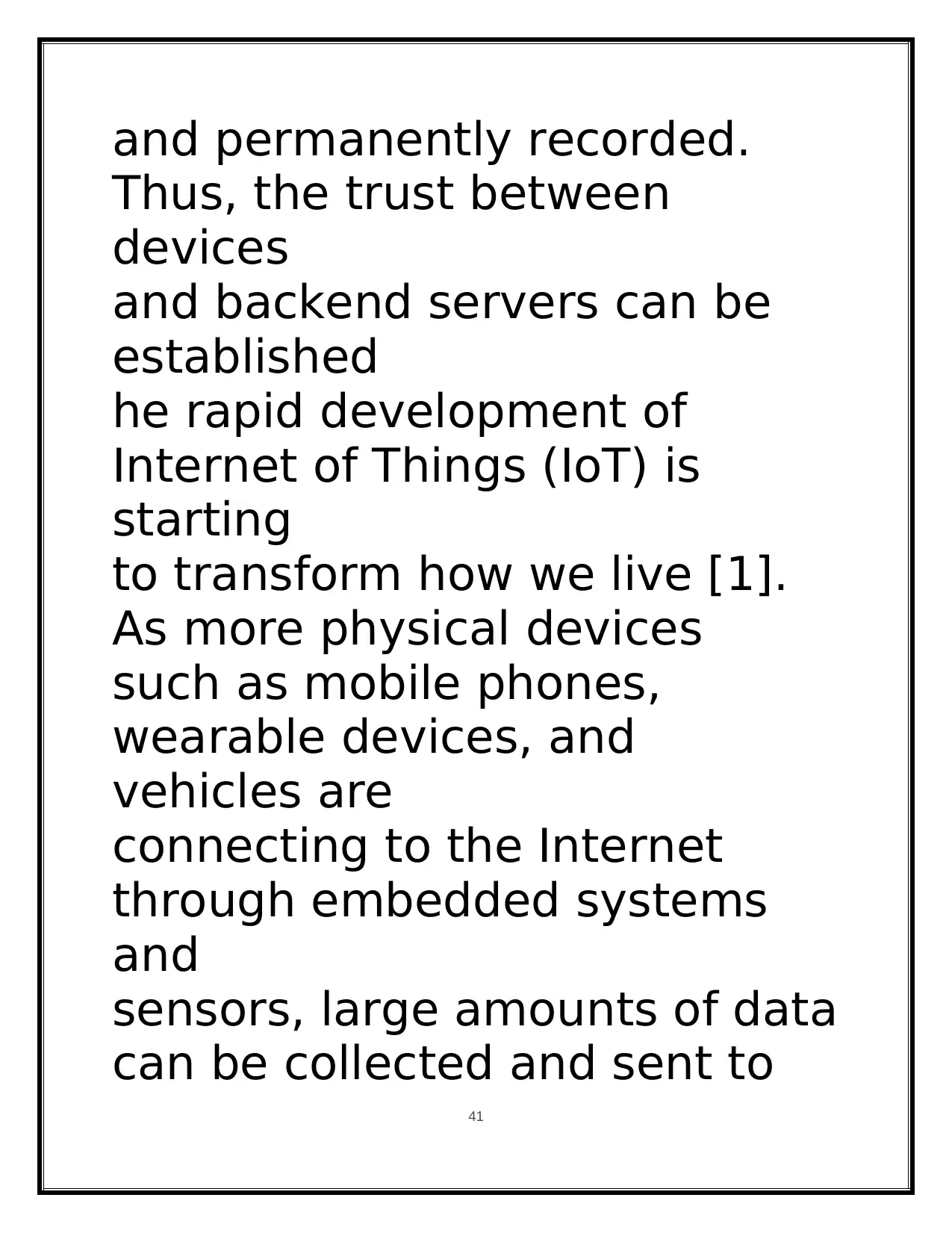
and permanently recorded.
Thus, the trust between
devices
and backend servers can be
established
he rapid development of
Internet of Things (IoT) is
starting
to transform how we live [1].
As more physical devices
such as mobile phones,
wearable devices, and
vehicles are
connecting to the Internet
through embedded systems
and
sensors, large amounts of data
can be collected and sent to
41
Thus, the trust between
devices
and backend servers can be
established
he rapid development of
Internet of Things (IoT) is
starting
to transform how we live [1].
As more physical devices
such as mobile phones,
wearable devices, and
vehicles are
connecting to the Internet
through embedded systems
and
sensors, large amounts of data
can be collected and sent to
41
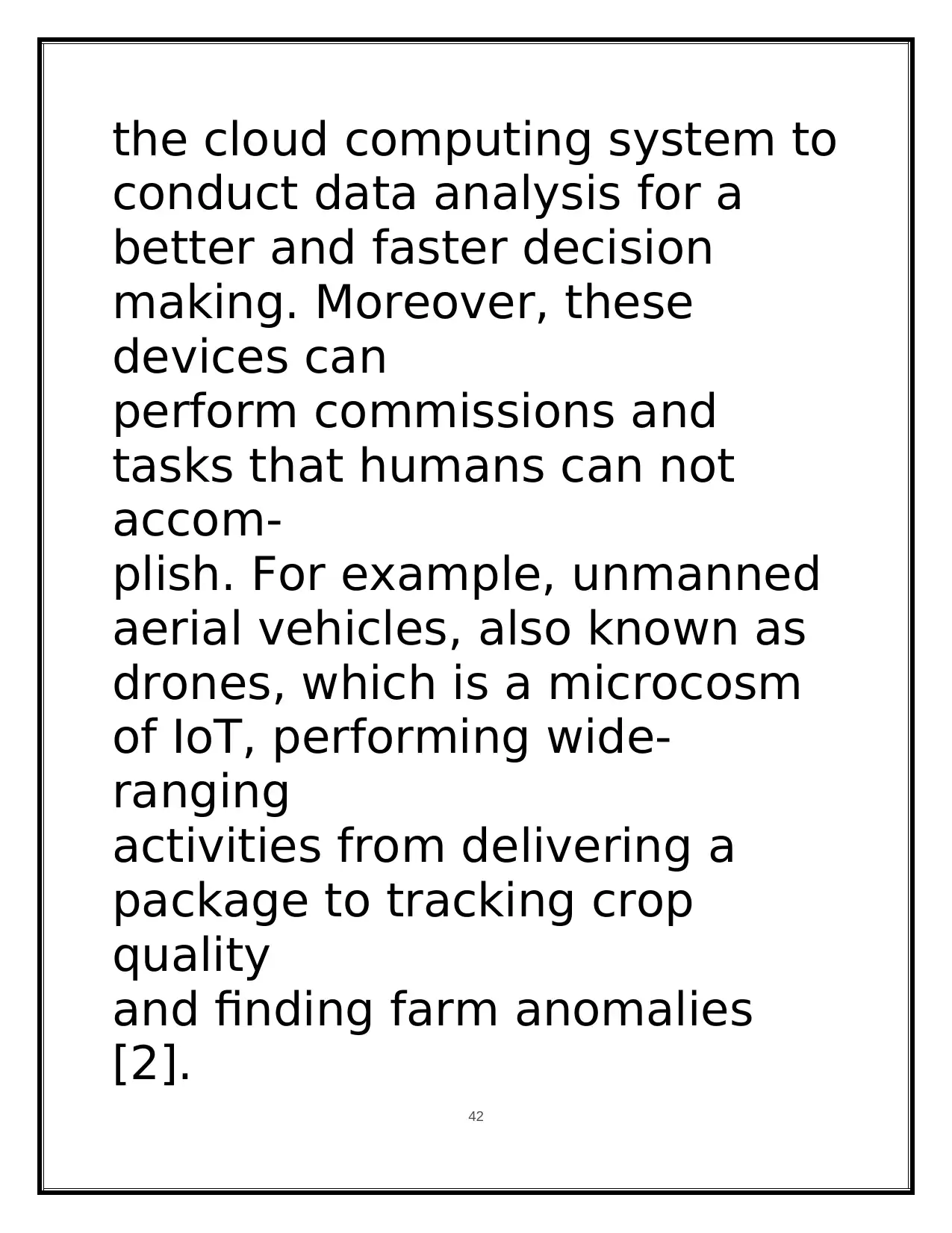
the cloud computing system to
conduct data analysis for a
better and faster decision
making. Moreover, these
devices can
perform commissions and
tasks that humans can not
accom-
plish. For example, unmanned
aerial vehicles, also known as
drones, which is a microcosm
of IoT, performing wide-
ranging
activities from delivering a
package to tracking crop
quality
and finding farm anomalies
[2]. 42
conduct data analysis for a
better and faster decision
making. Moreover, these
devices can
perform commissions and
tasks that humans can not
accom-
plish. For example, unmanned
aerial vehicles, also known as
drones, which is a microcosm
of IoT, performing wide-
ranging
activities from delivering a
package to tracking crop
quality
and finding farm anomalies
[2]. 42

However, as IoT grows, the
connectivity is increasing,
and the computing
infrastructure will become
more complex,
opening up more
vulnerabilities for the cyber
attack. Some
of the physical devices are
located in unsecured
environments
†Corresponding author.
and easily tampered by
hackers. More of the data and
the
operation commands traveling
over through wireless sensor
43
connectivity is increasing,
and the computing
infrastructure will become
more complex,
opening up more
vulnerabilities for the cyber
attack. Some
of the physical devices are
located in unsecured
environments
†Corresponding author.
and easily tampered by
hackers. More of the data and
the
operation commands traveling
over through wireless sensor
43
Secure Best Marks with AI Grader
Need help grading? Try our AI Grader for instant feedback on your assignments.
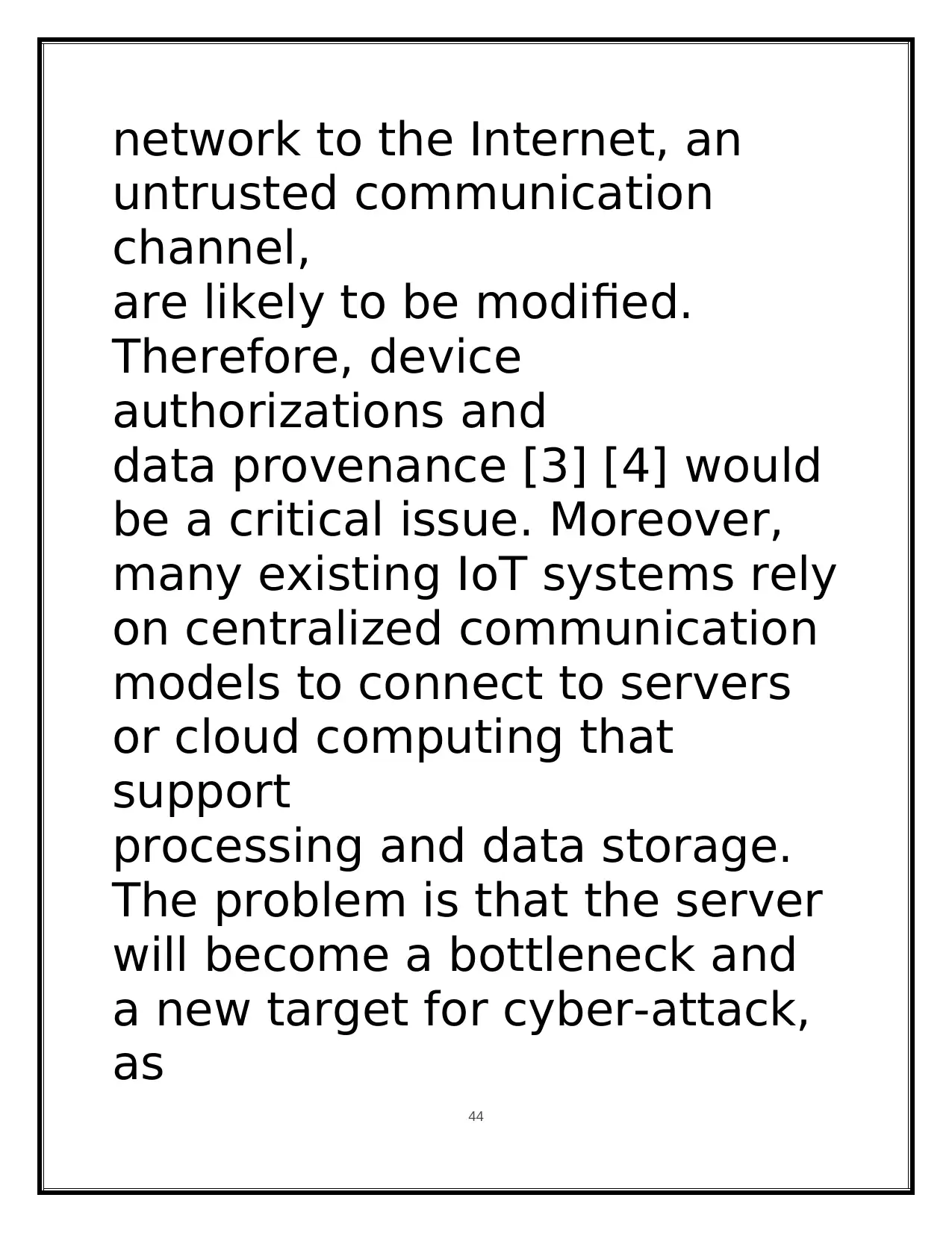
network to the Internet, an
untrusted communication
channel,
are likely to be modified.
Therefore, device
authorizations and
data provenance [3] [4] would
be a critical issue. Moreover,
many existing IoT systems rely
on centralized communication
models to connect to servers
or cloud computing that
support
processing and data storage.
The problem is that the server
will become a bottleneck and
a new target for cyber-attack,
as 44
untrusted communication
channel,
are likely to be modified.
Therefore, device
authorizations and
data provenance [3] [4] would
be a critical issue. Moreover,
many existing IoT systems rely
on centralized communication
models to connect to servers
or cloud computing that
support
processing and data storage.
The problem is that the server
will become a bottleneck and
a new target for cyber-attack,
as 44
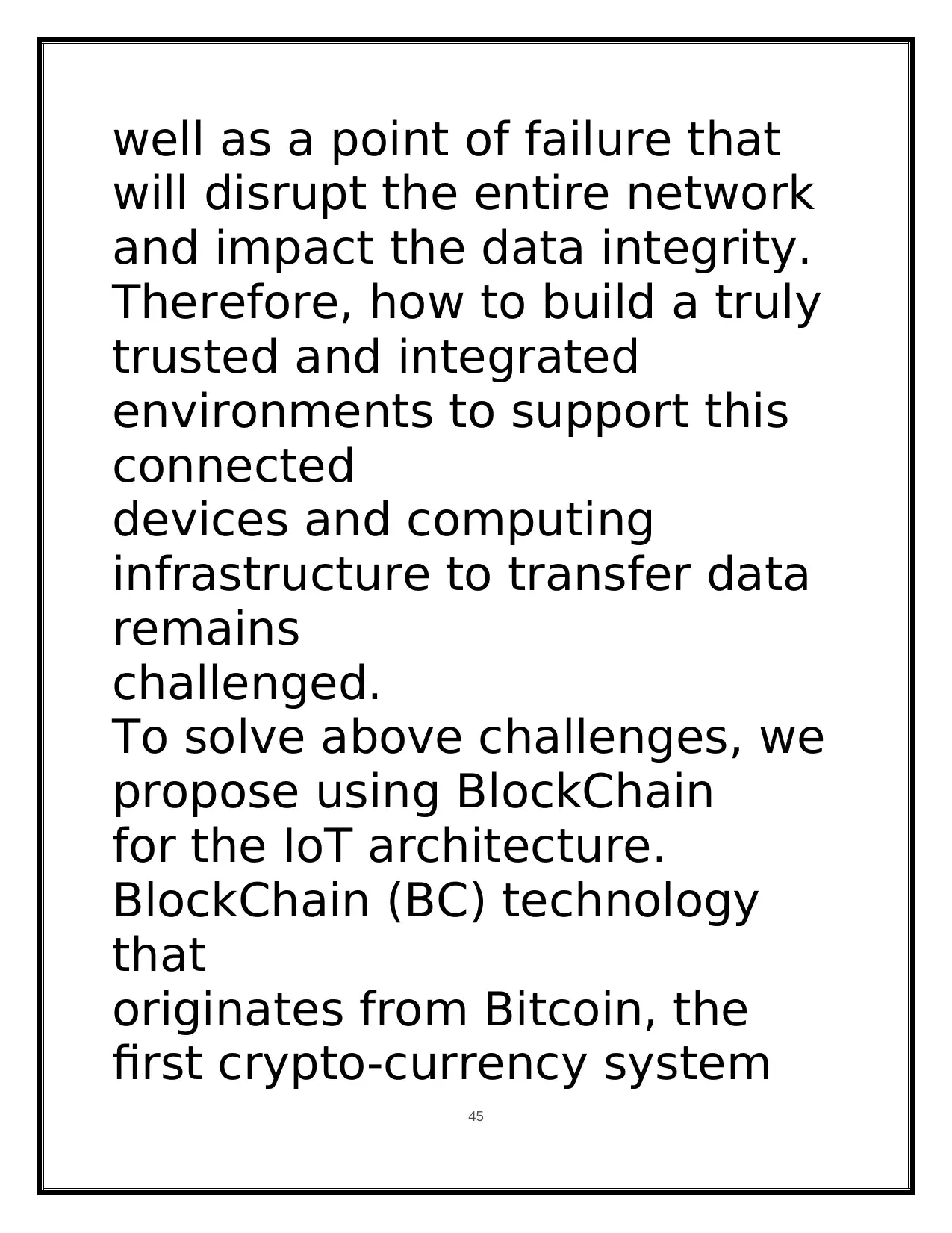
well as a point of failure that
will disrupt the entire network
and impact the data integrity.
Therefore, how to build a truly
trusted and integrated
environments to support this
connected
devices and computing
infrastructure to transfer data
remains
challenged.
To solve above challenges, we
propose using BlockChain
for the IoT architecture.
BlockChain (BC) technology
that
originates from Bitcoin, the
first crypto-currency system
45
will disrupt the entire network
and impact the data integrity.
Therefore, how to build a truly
trusted and integrated
environments to support this
connected
devices and computing
infrastructure to transfer data
remains
challenged.
To solve above challenges, we
propose using BlockChain
for the IoT architecture.
BlockChain (BC) technology
that
originates from Bitcoin, the
first crypto-currency system
45
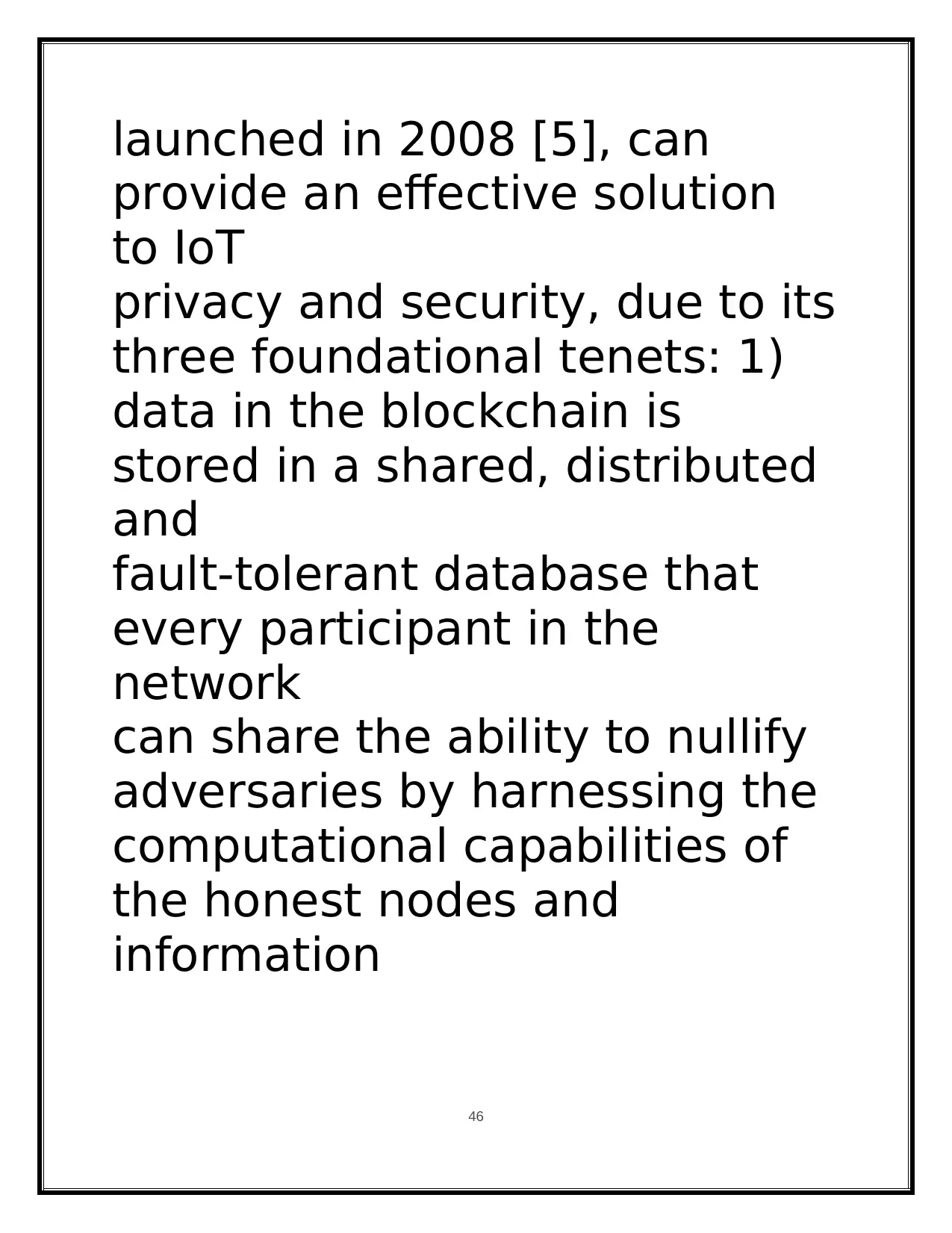
launched in 2008 [5], can
provide an effective solution
to IoT
privacy and security, due to its
three foundational tenets: 1)
data in the blockchain is
stored in a shared, distributed
and
fault-tolerant database that
every participant in the
network
can share the ability to nullify
adversaries by harnessing the
computational capabilities of
the honest nodes and
information
46
provide an effective solution
to IoT
privacy and security, due to its
three foundational tenets: 1)
data in the blockchain is
stored in a shared, distributed
and
fault-tolerant database that
every participant in the
network
can share the ability to nullify
adversaries by harnessing the
computational capabilities of
the honest nodes and
information
46
Paraphrase This Document
Need a fresh take? Get an instant paraphrase of this document with our AI Paraphraser
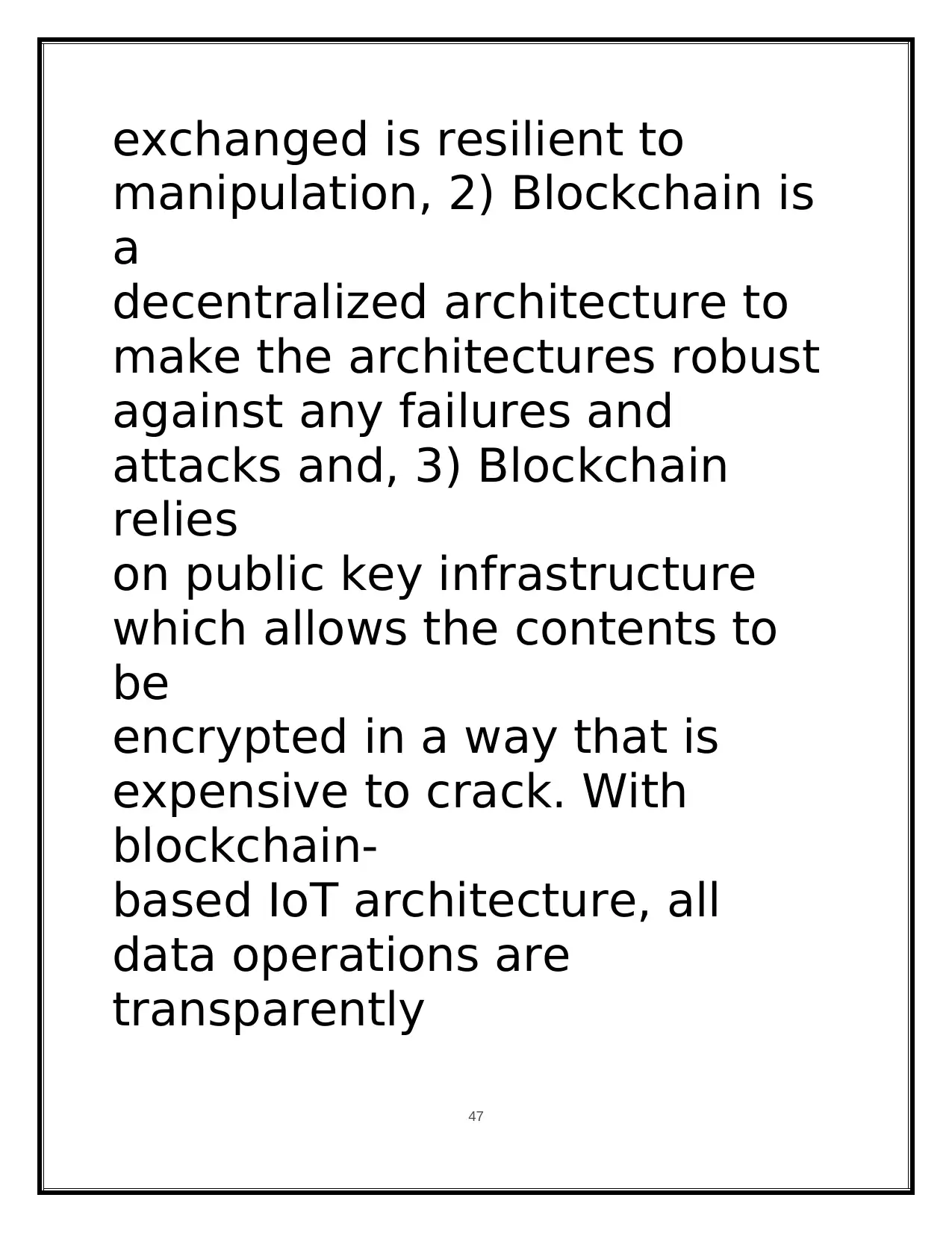
exchanged is resilient to
manipulation, 2) Blockchain is
a
decentralized architecture to
make the architectures robust
against any failures and
attacks and, 3) Blockchain
relies
on public key infrastructure
which allows the contents to
be
encrypted in a way that is
expensive to crack. With
blockchain-
based IoT architecture, all
data operations are
transparently
47
manipulation, 2) Blockchain is
a
decentralized architecture to
make the architectures robust
against any failures and
attacks and, 3) Blockchain
relies
on public key infrastructure
which allows the contents to
be
encrypted in a way that is
expensive to crack. With
blockchain-
based IoT architecture, all
data operations are
transparently
47

and permanently recorded.
Thus, the trust between
devices
and backend servers can be
established
he rapid development of
Internet of Things (IoT) is
starting
to transform how we live [1].
As more physical devices
such as mobile phones,
wearable devices, and
vehicles are
connecting to the Internet
through embedded systems
and
sensors, large amounts of data
can be collected and sent to
48
Thus, the trust between
devices
and backend servers can be
established
he rapid development of
Internet of Things (IoT) is
starting
to transform how we live [1].
As more physical devices
such as mobile phones,
wearable devices, and
vehicles are
connecting to the Internet
through embedded systems
and
sensors, large amounts of data
can be collected and sent to
48
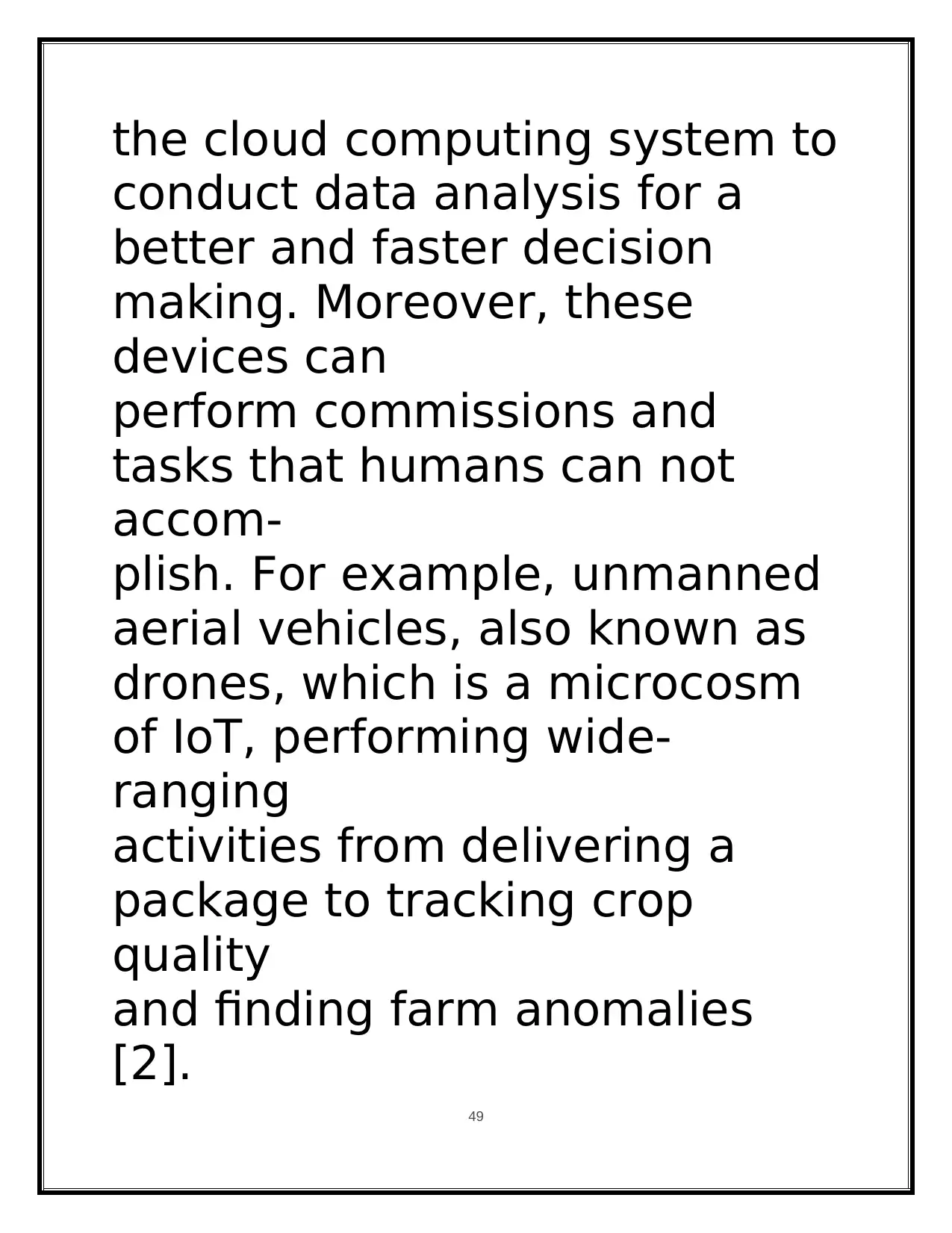
the cloud computing system to
conduct data analysis for a
better and faster decision
making. Moreover, these
devices can
perform commissions and
tasks that humans can not
accom-
plish. For example, unmanned
aerial vehicles, also known as
drones, which is a microcosm
of IoT, performing wide-
ranging
activities from delivering a
package to tracking crop
quality
and finding farm anomalies
[2]. 49
conduct data analysis for a
better and faster decision
making. Moreover, these
devices can
perform commissions and
tasks that humans can not
accom-
plish. For example, unmanned
aerial vehicles, also known as
drones, which is a microcosm
of IoT, performing wide-
ranging
activities from delivering a
package to tracking crop
quality
and finding farm anomalies
[2]. 49
Secure Best Marks with AI Grader
Need help grading? Try our AI Grader for instant feedback on your assignments.
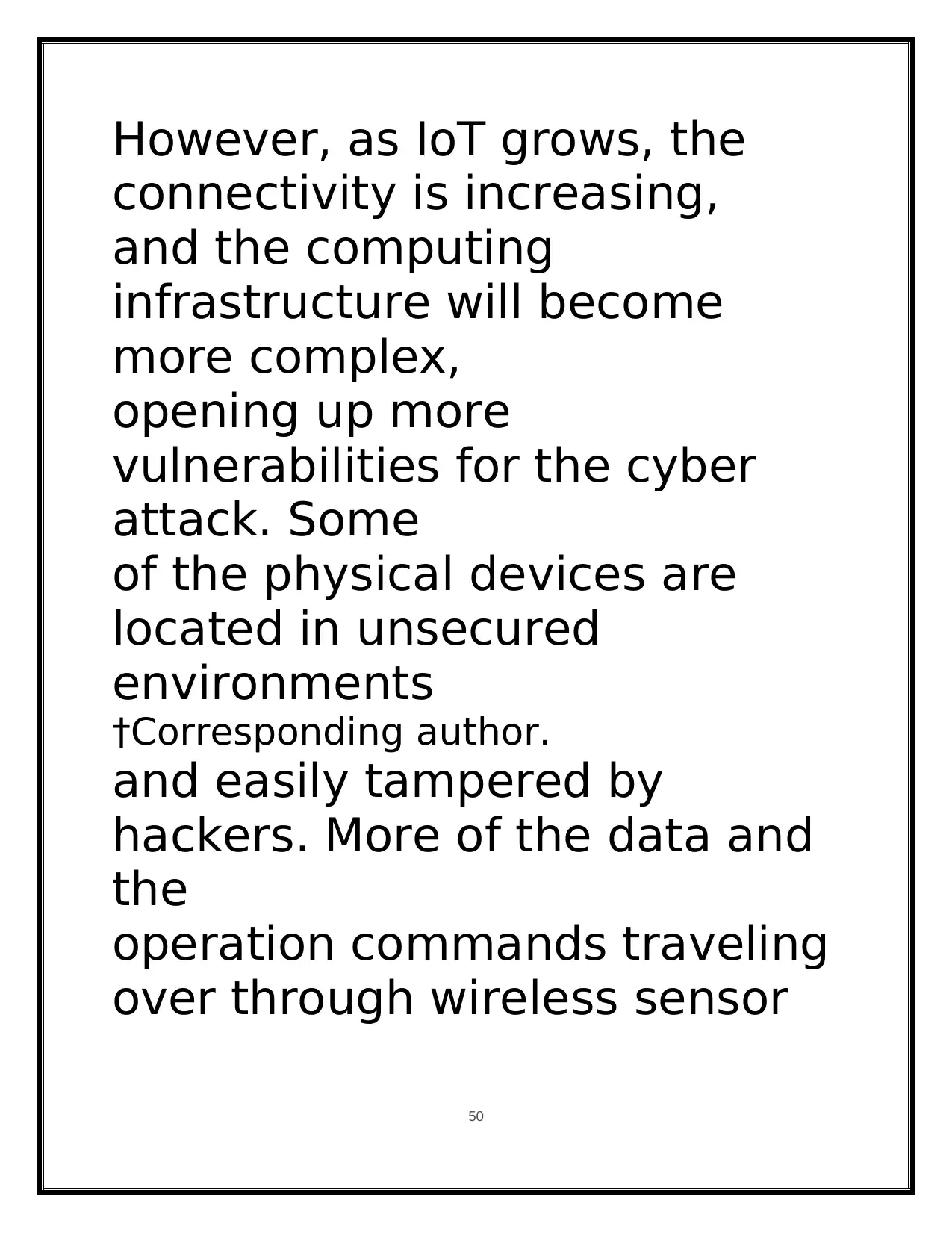
However, as IoT grows, the
connectivity is increasing,
and the computing
infrastructure will become
more complex,
opening up more
vulnerabilities for the cyber
attack. Some
of the physical devices are
located in unsecured
environments
†Corresponding author.
and easily tampered by
hackers. More of the data and
the
operation commands traveling
over through wireless sensor
50
connectivity is increasing,
and the computing
infrastructure will become
more complex,
opening up more
vulnerabilities for the cyber
attack. Some
of the physical devices are
located in unsecured
environments
†Corresponding author.
and easily tampered by
hackers. More of the data and
the
operation commands traveling
over through wireless sensor
50

network to the Internet, an
untrusted communication
channel,
are likely to be modified.
Therefore, device
authorizations and
data provenance [3] [4] would
be a critical issue. Moreover,
many existing IoT systems rely
on centralized communication
models to connect to servers
or cloud computing that
support
processing and data storage.
The problem is that the server
will become a bottleneck and
a new target for cyber-attack,
as 51
untrusted communication
channel,
are likely to be modified.
Therefore, device
authorizations and
data provenance [3] [4] would
be a critical issue. Moreover,
many existing IoT systems rely
on centralized communication
models to connect to servers
or cloud computing that
support
processing and data storage.
The problem is that the server
will become a bottleneck and
a new target for cyber-attack,
as 51
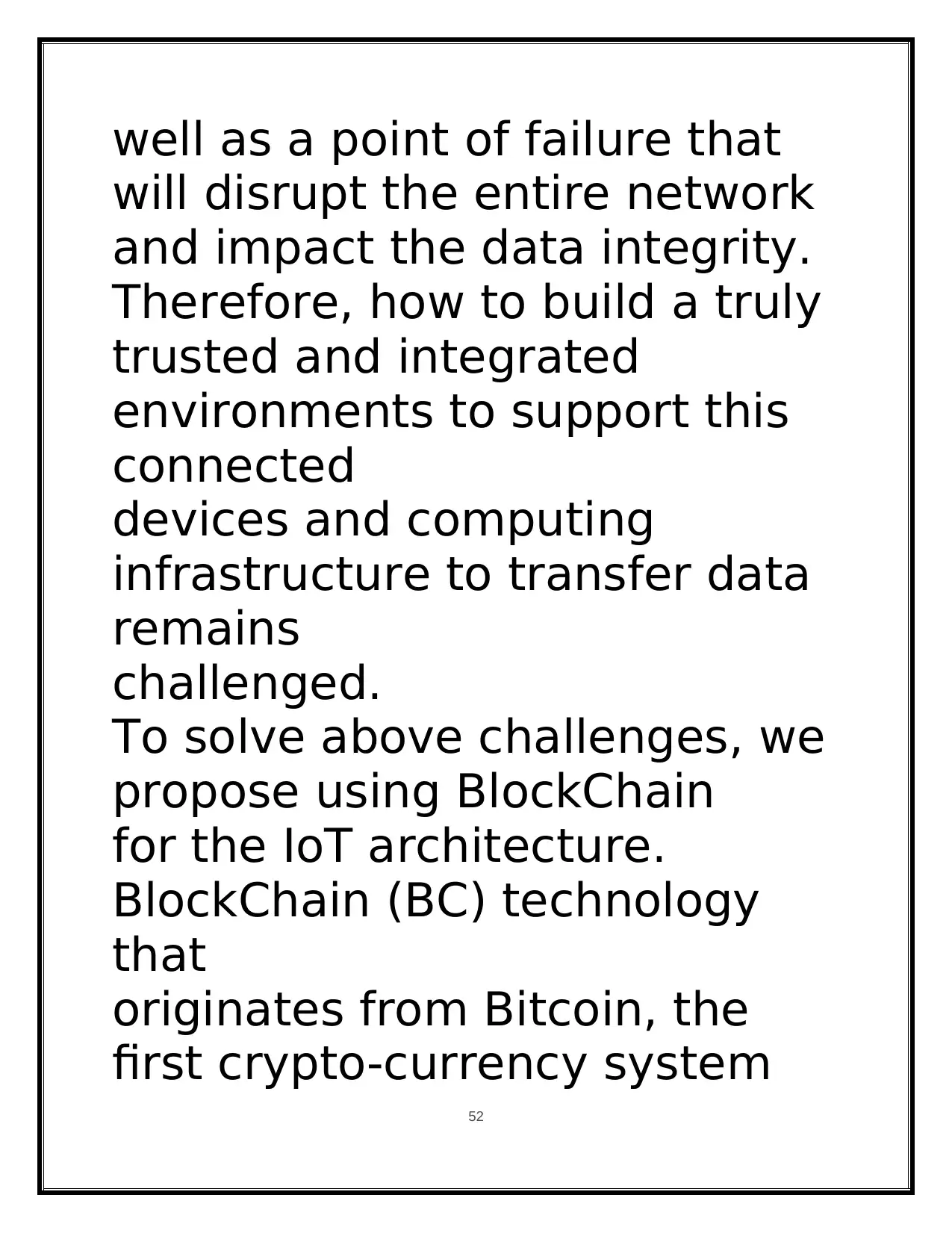
well as a point of failure that
will disrupt the entire network
and impact the data integrity.
Therefore, how to build a truly
trusted and integrated
environments to support this
connected
devices and computing
infrastructure to transfer data
remains
challenged.
To solve above challenges, we
propose using BlockChain
for the IoT architecture.
BlockChain (BC) technology
that
originates from Bitcoin, the
first crypto-currency system
52
will disrupt the entire network
and impact the data integrity.
Therefore, how to build a truly
trusted and integrated
environments to support this
connected
devices and computing
infrastructure to transfer data
remains
challenged.
To solve above challenges, we
propose using BlockChain
for the IoT architecture.
BlockChain (BC) technology
that
originates from Bitcoin, the
first crypto-currency system
52
Paraphrase This Document
Need a fresh take? Get an instant paraphrase of this document with our AI Paraphraser
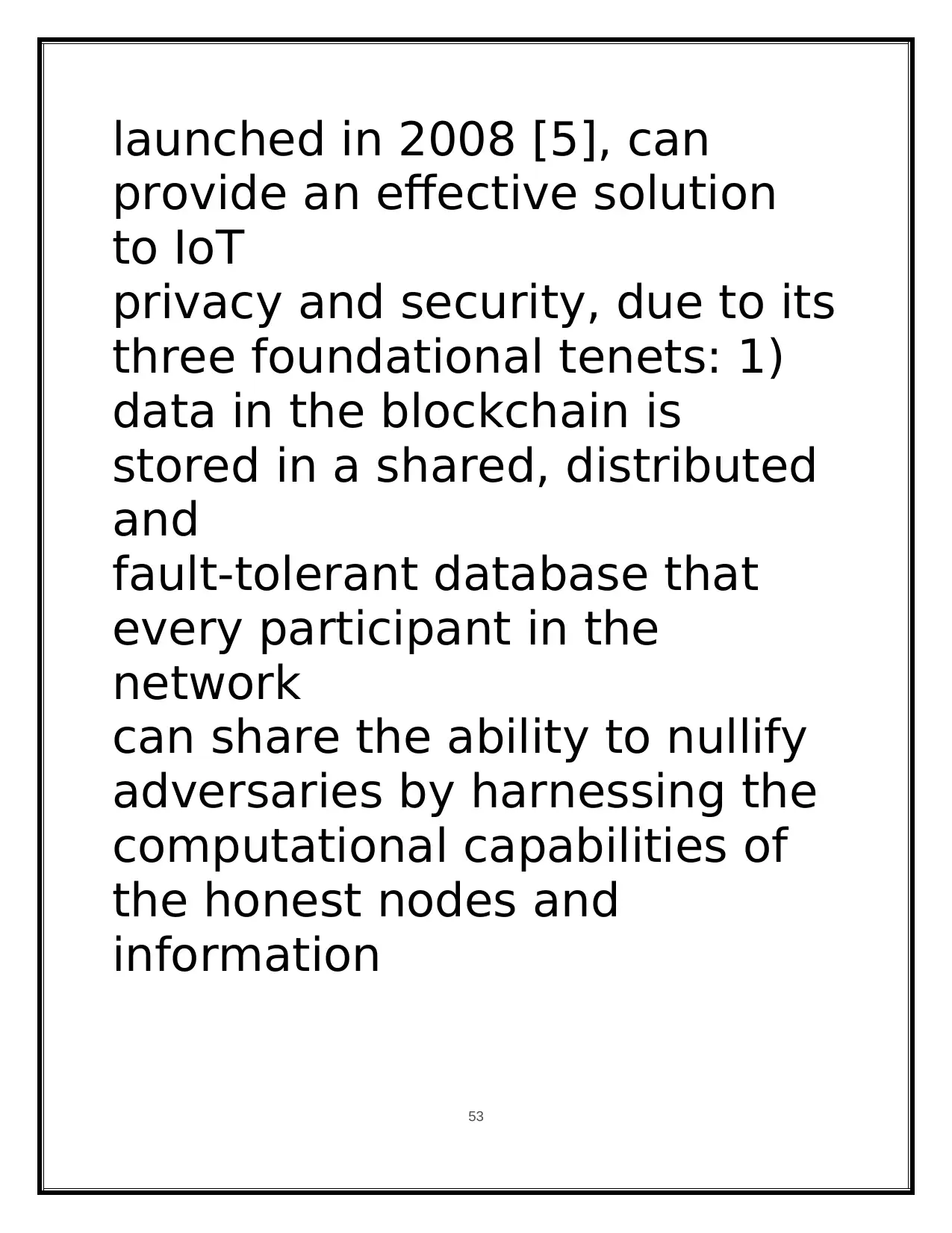
launched in 2008 [5], can
provide an effective solution
to IoT
privacy and security, due to its
three foundational tenets: 1)
data in the blockchain is
stored in a shared, distributed
and
fault-tolerant database that
every participant in the
network
can share the ability to nullify
adversaries by harnessing the
computational capabilities of
the honest nodes and
information
53
provide an effective solution
to IoT
privacy and security, due to its
three foundational tenets: 1)
data in the blockchain is
stored in a shared, distributed
and
fault-tolerant database that
every participant in the
network
can share the ability to nullify
adversaries by harnessing the
computational capabilities of
the honest nodes and
information
53
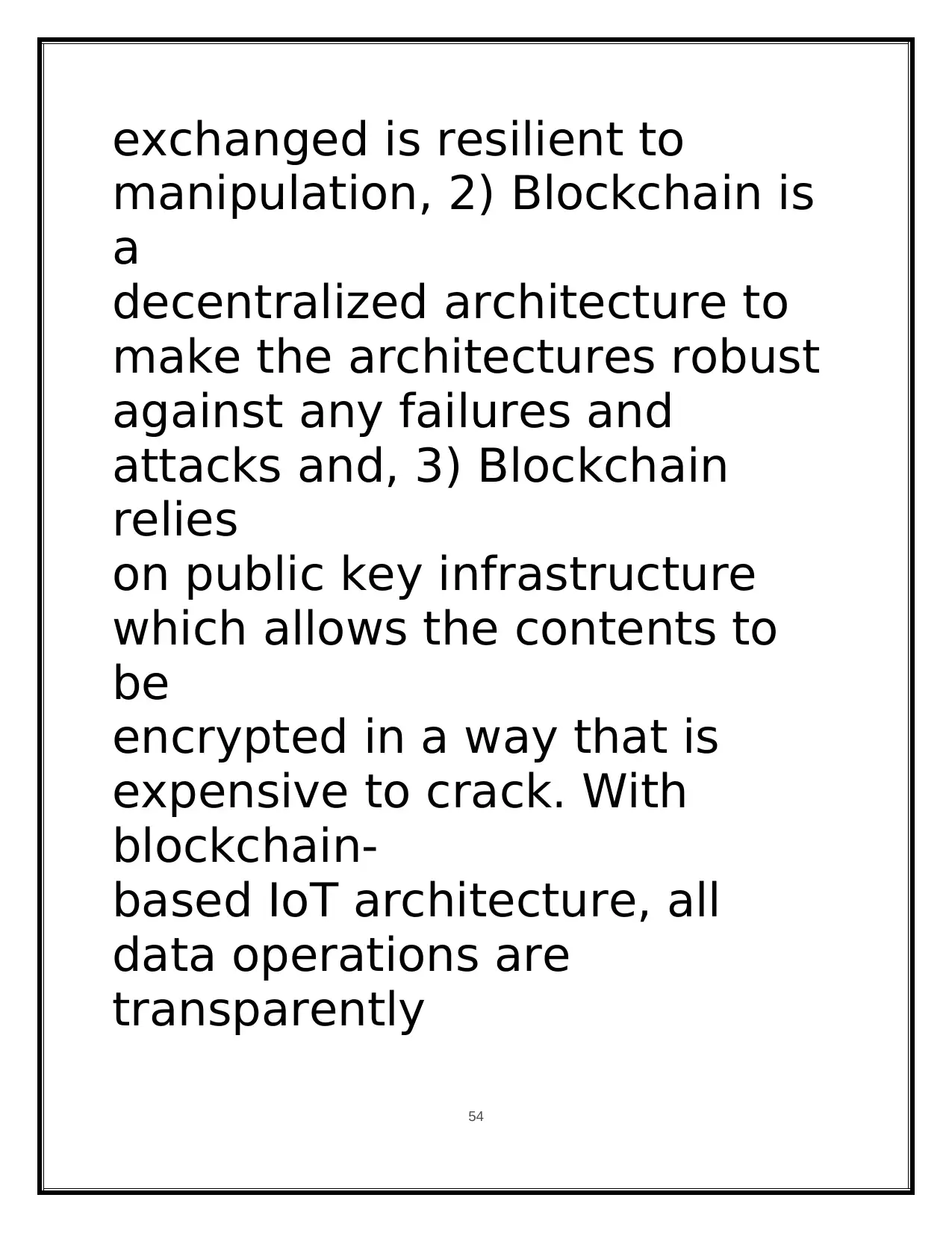
exchanged is resilient to
manipulation, 2) Blockchain is
a
decentralized architecture to
make the architectures robust
against any failures and
attacks and, 3) Blockchain
relies
on public key infrastructure
which allows the contents to
be
encrypted in a way that is
expensive to crack. With
blockchain-
based IoT architecture, all
data operations are
transparently
54
manipulation, 2) Blockchain is
a
decentralized architecture to
make the architectures robust
against any failures and
attacks and, 3) Blockchain
relies
on public key infrastructure
which allows the contents to
be
encrypted in a way that is
expensive to crack. With
blockchain-
based IoT architecture, all
data operations are
transparently
54

and permanently recorded.
Thus, the trust between
devices
and backend servers can be
established
The initial process of the growing on IoT (internet of things) can be performed on the
physical devices such as, wearable devices, mobile phones, vehicle is directly communicating
between the internet and connected to sensors, embedded system to send the transfer packets for,
the cloud computing of the data analysis and marking the decision to accessing the large amount
of data on the physical network devices. The interaction with the physical devices that performed
on human, cannot execute on the internet. The wide ranging activates of the delivery packages is
denoted as the unmanned aerial vehicles that performed and found the automobile quality. The
increasing growth of IoT which directly connects the cloud computing infrastructure and
displays on the windows provides more cypher attacks of the vulnerability test on the devices.
Exchanging the data from one device to another device, but this data is insecure on the system,
and can be easily hacked from the data exchanging information by hackers. The communication
channel of the transformation of command operation of IoT devices can be used for the wireless
sensor network of the internet. The Existing system of the IoT device which is connecting the
cloud computing server so that it can access the data storage and find the target cyber-attack of
the vulnerability system. At the same time access to the failure of the network of data is
integrating on the connecting device of the cloud computing has been changed.
The proposed system of the IoT devices can follow the following stages:
Origin of trusted data
Arrange data organ of the block chain network which has been performed on the
deterministic of the starting point which has been denoted as the direct connecting
device of the end point of the assurance of the traffic device.
Instant and Permanent Data Integrity
55
Thus, the trust between
devices
and backend servers can be
established
The initial process of the growing on IoT (internet of things) can be performed on the
physical devices such as, wearable devices, mobile phones, vehicle is directly communicating
between the internet and connected to sensors, embedded system to send the transfer packets for,
the cloud computing of the data analysis and marking the decision to accessing the large amount
of data on the physical network devices. The interaction with the physical devices that performed
on human, cannot execute on the internet. The wide ranging activates of the delivery packages is
denoted as the unmanned aerial vehicles that performed and found the automobile quality. The
increasing growth of IoT which directly connects the cloud computing infrastructure and
displays on the windows provides more cypher attacks of the vulnerability test on the devices.
Exchanging the data from one device to another device, but this data is insecure on the system,
and can be easily hacked from the data exchanging information by hackers. The communication
channel of the transformation of command operation of IoT devices can be used for the wireless
sensor network of the internet. The Existing system of the IoT device which is connecting the
cloud computing server so that it can access the data storage and find the target cyber-attack of
the vulnerability system. At the same time access to the failure of the network of data is
integrating on the connecting device of the cloud computing has been changed.
The proposed system of the IoT devices can follow the following stages:
Origin of trusted data
Arrange data organ of the block chain network which has been performed on the
deterministic of the starting point which has been denoted as the direct connecting
device of the end point of the assurance of the traffic device.
Instant and Permanent Data Integrity
55
Secure Best Marks with AI Grader
Need help grading? Try our AI Grader for instant feedback on your assignments.

Arrange data organ of the block chain network which has been performed on the
deterministic of the starting point has been denoted as the direct connecting device of
the end point of the assurance of the traffic device. The block chain network which is
submitting each record of the data collection drones which is specified on the control
system of the transaction of the block network. The block chain process of the
integrity mechanism has been used for the conformation of the resistance of physical
device on the tempering.
Trusted Accountability
The block chain network of the account uploads the exchange process from one
device to another device which is to be specified from the operation records. These
records can be used for the finger prints and malicious has to be detected and
uploaded on the command based black chain network which investigates from the
future work process system. .
Resilient Backend
The main contribution of the proposed resilient of IoT service based on the block
chain, which provides the ability for self-trust, and data exemplify of the cloud based
drone system. The integration of the block chain technology with drone based IoT
services, offering to secure communication of the architecture to be robust and same
time potential to be failure for attacks. The integrity of the block chain exchanging
data has been removed on trust. The nature of the distributed data node is added and
to check the validation of the service demand. At the same time collect data on the
system account which is in attack to the mitigation of the cypher security.
Accountable for the attack mitigation of the data collection which is denoted as the
unauthorized user gaining physical access to a computer is most likely able to directly
copy data from it. They may also compromise security by making operating system
modifications, installing software worms, key loggers, covert listening devices or
using wireless mice of the cyber fervencies.
Chapter 3: Artefact-3500
This section articulates a data contingency technique running in a dedicated IoT testbed,
and will demonstrate the resilience against some of the attacks which impacts on data availability
56
deterministic of the starting point has been denoted as the direct connecting device of
the end point of the assurance of the traffic device. The block chain network which is
submitting each record of the data collection drones which is specified on the control
system of the transaction of the block network. The block chain process of the
integrity mechanism has been used for the conformation of the resistance of physical
device on the tempering.
Trusted Accountability
The block chain network of the account uploads the exchange process from one
device to another device which is to be specified from the operation records. These
records can be used for the finger prints and malicious has to be detected and
uploaded on the command based black chain network which investigates from the
future work process system. .
Resilient Backend
The main contribution of the proposed resilient of IoT service based on the block
chain, which provides the ability for self-trust, and data exemplify of the cloud based
drone system. The integration of the block chain technology with drone based IoT
services, offering to secure communication of the architecture to be robust and same
time potential to be failure for attacks. The integrity of the block chain exchanging
data has been removed on trust. The nature of the distributed data node is added and
to check the validation of the service demand. At the same time collect data on the
system account which is in attack to the mitigation of the cypher security.
Accountable for the attack mitigation of the data collection which is denoted as the
unauthorized user gaining physical access to a computer is most likely able to directly
copy data from it. They may also compromise security by making operating system
modifications, installing software worms, key loggers, covert listening devices or
using wireless mice of the cyber fervencies.
Chapter 3: Artefact-3500
This section articulates a data contingency technique running in a dedicated IoT testbed,
and will demonstrate the resilience against some of the attacks which impacts on data availability
56
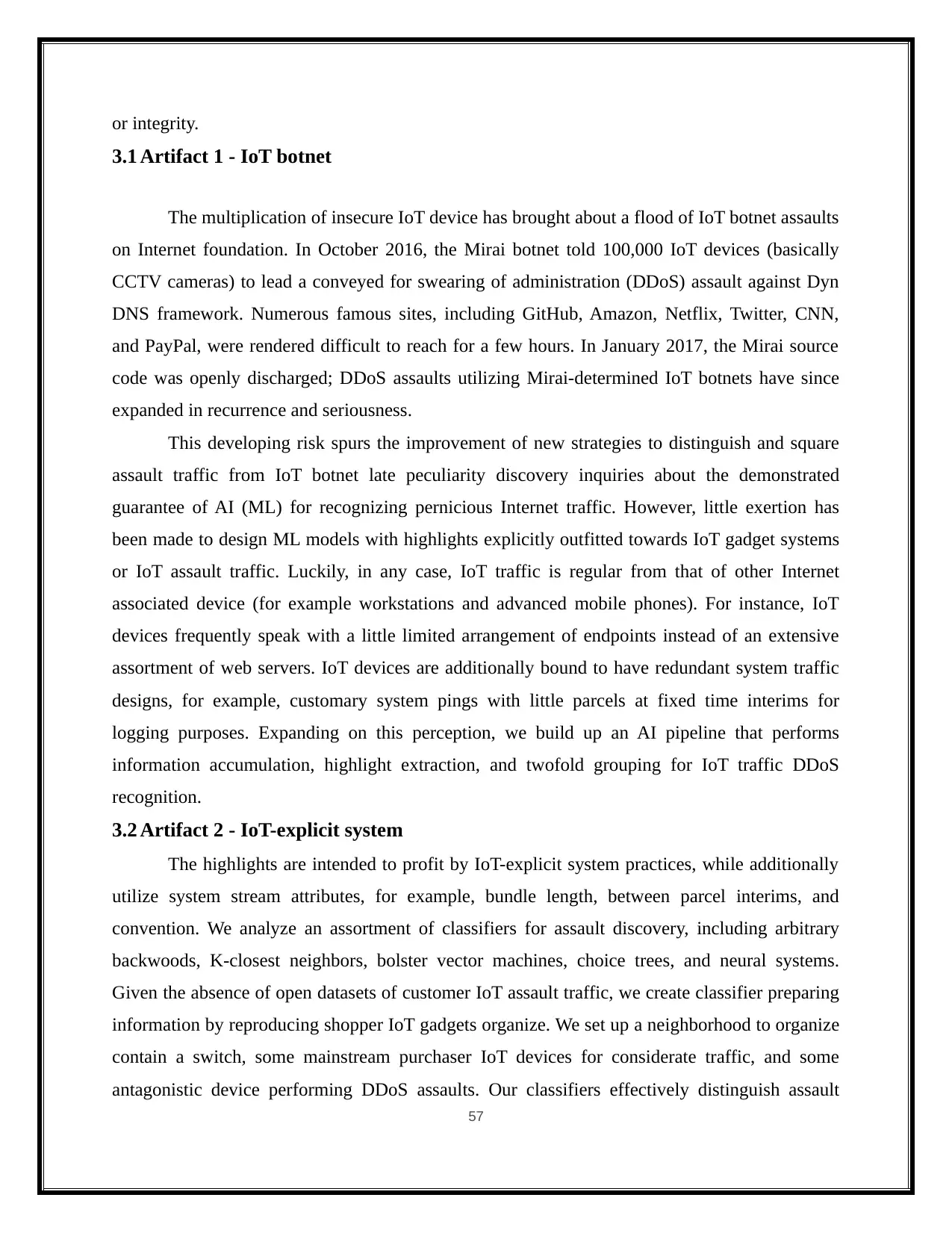
or integrity.
3.1 Artifact 1 - IoT botnet
The multiplication of insecure IoT device has brought about a flood of IoT botnet assaults
on Internet foundation. In October 2016, the Mirai botnet told 100,000 IoT devices (basically
CCTV cameras) to lead a conveyed for swearing of administration (DDoS) assault against Dyn
DNS framework. Numerous famous sites, including GitHub, Amazon, Netflix, Twitter, CNN,
and PayPal, were rendered difficult to reach for a few hours. In January 2017, the Mirai source
code was openly discharged; DDoS assaults utilizing Mirai-determined IoT botnets have since
expanded in recurrence and seriousness.
This developing risk spurs the improvement of new strategies to distinguish and square
assault traffic from IoT botnet late peculiarity discovery inquiries about the demonstrated
guarantee of AI (ML) for recognizing pernicious Internet traffic. However, little exertion has
been made to design ML models with highlights explicitly outfitted towards IoT gadget systems
or IoT assault traffic. Luckily, in any case, IoT traffic is regular from that of other Internet
associated device (for example workstations and advanced mobile phones). For instance, IoT
devices frequently speak with a little limited arrangement of endpoints instead of an extensive
assortment of web servers. IoT devices are additionally bound to have redundant system traffic
designs, for example, customary system pings with little parcels at fixed time interims for
logging purposes. Expanding on this perception, we build up an AI pipeline that performs
information accumulation, highlight extraction, and twofold grouping for IoT traffic DDoS
recognition.
3.2 Artifact 2 - IoT-explicit system
The highlights are intended to profit by IoT-explicit system practices, while additionally
utilize system stream attributes, for example, bundle length, between parcel interims, and
convention. We analyze an assortment of classifiers for assault discovery, including arbitrary
backwoods, K-closest neighbors, bolster vector machines, choice trees, and neural systems.
Given the absence of open datasets of customer IoT assault traffic, we create classifier preparing
information by reproducing shopper IoT gadgets organize. We set up a neighborhood to organize
contain a switch, some mainstream purchaser IoT devices for considerate traffic, and some
antagonistic device performing DDoS assaults. Our classifiers effectively distinguish assault
57
3.1 Artifact 1 - IoT botnet
The multiplication of insecure IoT device has brought about a flood of IoT botnet assaults
on Internet foundation. In October 2016, the Mirai botnet told 100,000 IoT devices (basically
CCTV cameras) to lead a conveyed for swearing of administration (DDoS) assault against Dyn
DNS framework. Numerous famous sites, including GitHub, Amazon, Netflix, Twitter, CNN,
and PayPal, were rendered difficult to reach for a few hours. In January 2017, the Mirai source
code was openly discharged; DDoS assaults utilizing Mirai-determined IoT botnets have since
expanded in recurrence and seriousness.
This developing risk spurs the improvement of new strategies to distinguish and square
assault traffic from IoT botnet late peculiarity discovery inquiries about the demonstrated
guarantee of AI (ML) for recognizing pernicious Internet traffic. However, little exertion has
been made to design ML models with highlights explicitly outfitted towards IoT gadget systems
or IoT assault traffic. Luckily, in any case, IoT traffic is regular from that of other Internet
associated device (for example workstations and advanced mobile phones). For instance, IoT
devices frequently speak with a little limited arrangement of endpoints instead of an extensive
assortment of web servers. IoT devices are additionally bound to have redundant system traffic
designs, for example, customary system pings with little parcels at fixed time interims for
logging purposes. Expanding on this perception, we build up an AI pipeline that performs
information accumulation, highlight extraction, and twofold grouping for IoT traffic DDoS
recognition.
3.2 Artifact 2 - IoT-explicit system
The highlights are intended to profit by IoT-explicit system practices, while additionally
utilize system stream attributes, for example, bundle length, between parcel interims, and
convention. We analyze an assortment of classifiers for assault discovery, including arbitrary
backwoods, K-closest neighbors, bolster vector machines, choice trees, and neural systems.
Given the absence of open datasets of customer IoT assault traffic, we create classifier preparing
information by reproducing shopper IoT gadgets organize. We set up a neighborhood to organize
contain a switch, some mainstream purchaser IoT devices for considerate traffic, and some
antagonistic device performing DDoS assaults. Our classifiers effectively distinguish assault
57
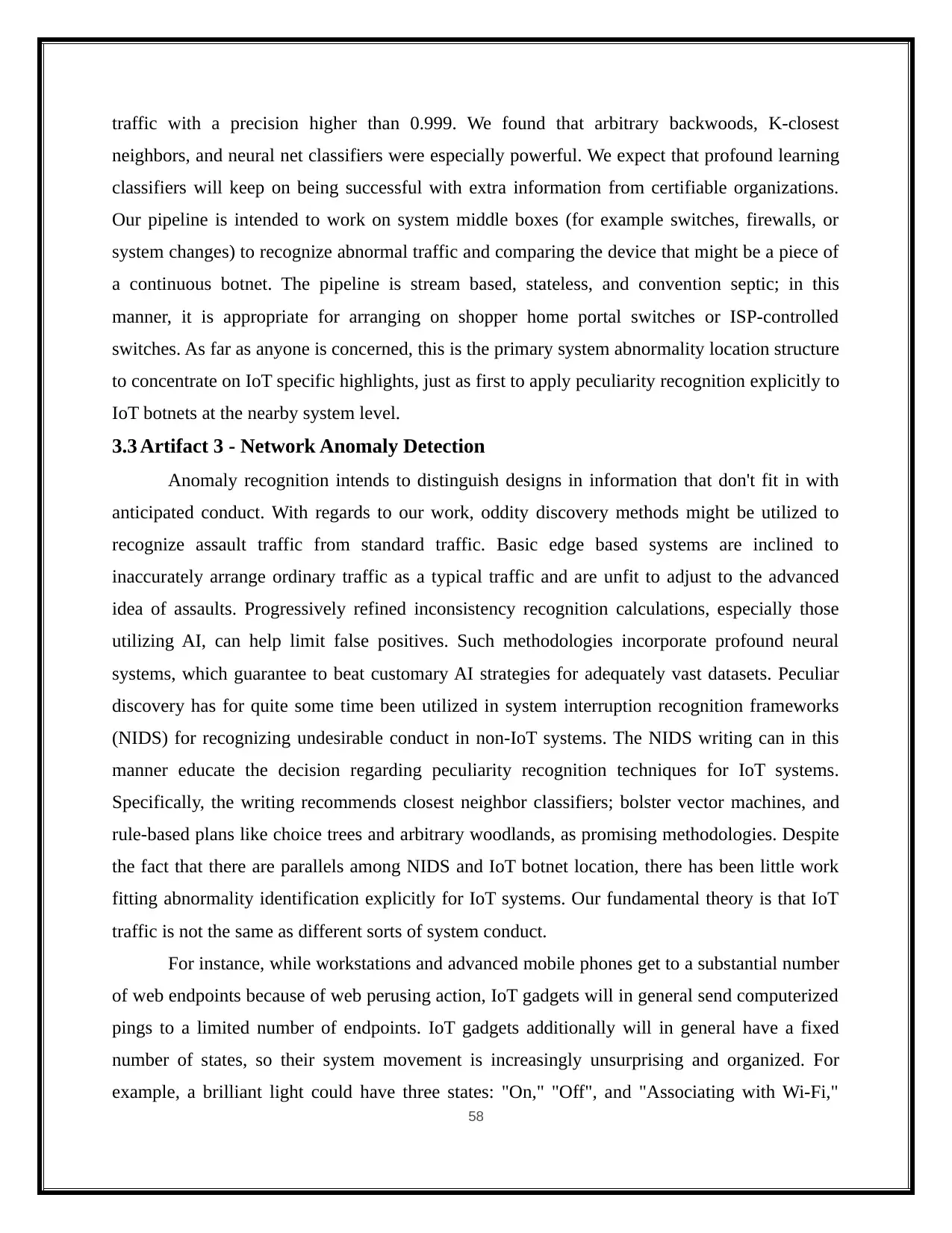
traffic with a precision higher than 0.999. We found that arbitrary backwoods, K-closest
neighbors, and neural net classifiers were especially powerful. We expect that profound learning
classifiers will keep on being successful with extra information from certifiable organizations.
Our pipeline is intended to work on system middle boxes (for example switches, firewalls, or
system changes) to recognize abnormal traffic and comparing the device that might be a piece of
a continuous botnet. The pipeline is stream based, stateless, and convention septic; in this
manner, it is appropriate for arranging on shopper home portal switches or ISP-controlled
switches. As far as anyone is concerned, this is the primary system abnormality location structure
to concentrate on IoT specific highlights, just as first to apply peculiarity recognition explicitly to
IoT botnets at the nearby system level.
3.3 Artifact 3 - Network Anomaly Detection
Anomaly recognition intends to distinguish designs in information that don't fit in with
anticipated conduct. With regards to our work, oddity discovery methods might be utilized to
recognize assault traffic from standard traffic. Basic edge based systems are inclined to
inaccurately arrange ordinary traffic as a typical traffic and are unfit to adjust to the advanced
idea of assaults. Progressively refined inconsistency recognition calculations, especially those
utilizing AI, can help limit false positives. Such methodologies incorporate profound neural
systems, which guarantee to beat customary AI strategies for adequately vast datasets. Peculiar
discovery has for quite some time been utilized in system interruption recognition frameworks
(NIDS) for recognizing undesirable conduct in non-IoT systems. The NIDS writing can in this
manner educate the decision regarding peculiarity recognition techniques for IoT systems.
Specifically, the writing recommends closest neighbor classifiers; bolster vector machines, and
rule-based plans like choice trees and arbitrary woodlands, as promising methodologies. Despite
the fact that there are parallels among NIDS and IoT botnet location, there has been little work
fitting abnormality identification explicitly for IoT systems. Our fundamental theory is that IoT
traffic is not the same as different sorts of system conduct.
For instance, while workstations and advanced mobile phones get to a substantial number
of web endpoints because of web perusing action, IoT gadgets will in general send computerized
pings to a limited number of endpoints. IoT gadgets additionally will in general have a fixed
number of states, so their system movement is increasingly unsurprising and organized. For
example, a brilliant light could have three states: "On," "Off", and "Associating with Wi-Fi,"
58
neighbors, and neural net classifiers were especially powerful. We expect that profound learning
classifiers will keep on being successful with extra information from certifiable organizations.
Our pipeline is intended to work on system middle boxes (for example switches, firewalls, or
system changes) to recognize abnormal traffic and comparing the device that might be a piece of
a continuous botnet. The pipeline is stream based, stateless, and convention septic; in this
manner, it is appropriate for arranging on shopper home portal switches or ISP-controlled
switches. As far as anyone is concerned, this is the primary system abnormality location structure
to concentrate on IoT specific highlights, just as first to apply peculiarity recognition explicitly to
IoT botnets at the nearby system level.
3.3 Artifact 3 - Network Anomaly Detection
Anomaly recognition intends to distinguish designs in information that don't fit in with
anticipated conduct. With regards to our work, oddity discovery methods might be utilized to
recognize assault traffic from standard traffic. Basic edge based systems are inclined to
inaccurately arrange ordinary traffic as a typical traffic and are unfit to adjust to the advanced
idea of assaults. Progressively refined inconsistency recognition calculations, especially those
utilizing AI, can help limit false positives. Such methodologies incorporate profound neural
systems, which guarantee to beat customary AI strategies for adequately vast datasets. Peculiar
discovery has for quite some time been utilized in system interruption recognition frameworks
(NIDS) for recognizing undesirable conduct in non-IoT systems. The NIDS writing can in this
manner educate the decision regarding peculiarity recognition techniques for IoT systems.
Specifically, the writing recommends closest neighbor classifiers; bolster vector machines, and
rule-based plans like choice trees and arbitrary woodlands, as promising methodologies. Despite
the fact that there are parallels among NIDS and IoT botnet location, there has been little work
fitting abnormality identification explicitly for IoT systems. Our fundamental theory is that IoT
traffic is not the same as different sorts of system conduct.
For instance, while workstations and advanced mobile phones get to a substantial number
of web endpoints because of web perusing action, IoT gadgets will in general send computerized
pings to a limited number of endpoints. IoT gadgets additionally will in general have a fixed
number of states, so their system movement is increasingly unsurprising and organized. For
example, a brilliant light could have three states: "On," "Off", and "Associating with Wi-Fi,"
58
Paraphrase This Document
Need a fresh take? Get an instant paraphrase of this document with our AI Paraphraser
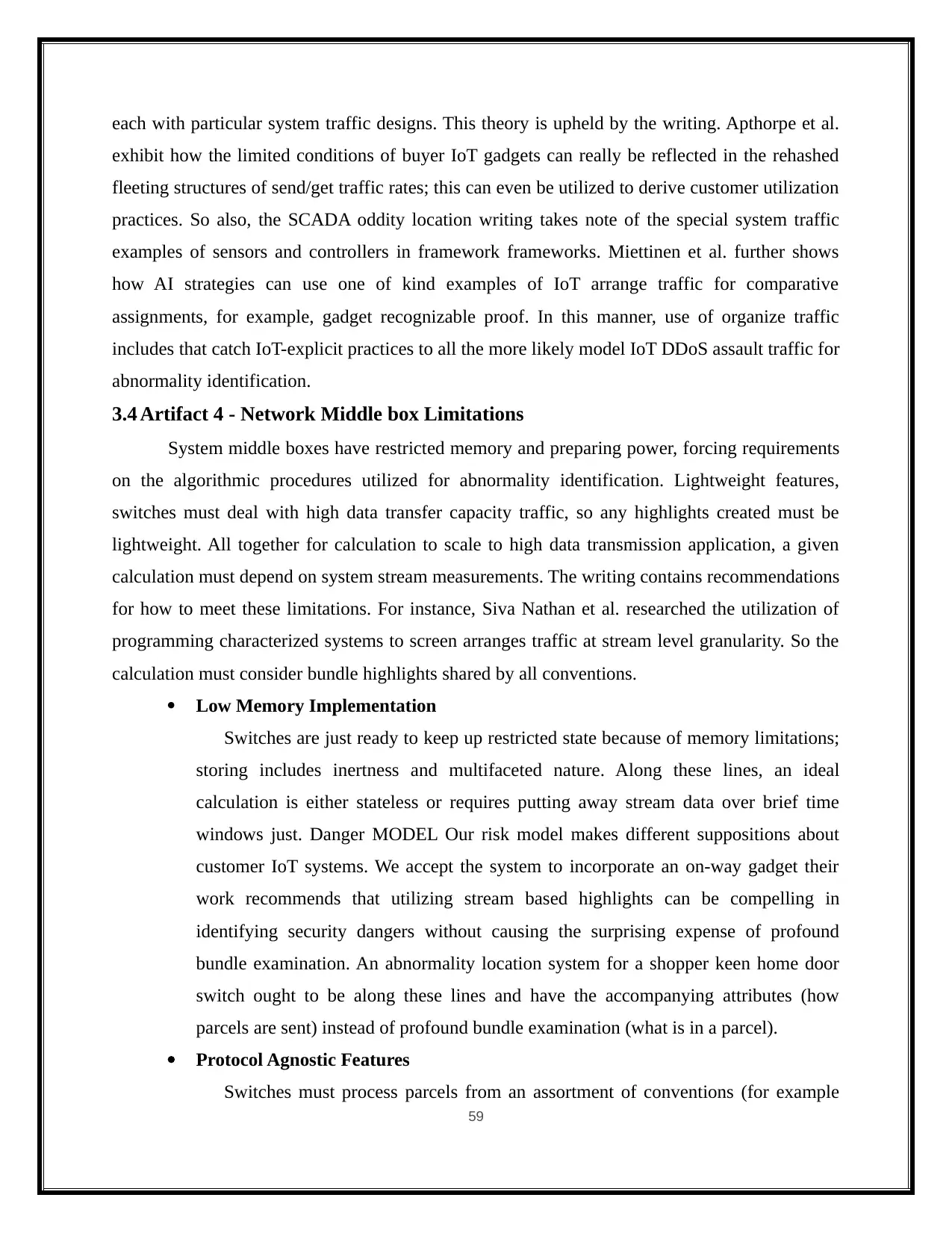
each with particular system traffic designs. This theory is upheld by the writing. Apthorpe et al.
exhibit how the limited conditions of buyer IoT gadgets can really be reflected in the rehashed
fleeting structures of send/get traffic rates; this can even be utilized to derive customer utilization
practices. So also, the SCADA oddity location writing takes note of the special system traffic
examples of sensors and controllers in framework frameworks. Miettinen et al. further shows
how AI strategies can use one of kind examples of IoT arrange traffic for comparative
assignments, for example, gadget recognizable proof. In this manner, use of organize traffic
includes that catch IoT-explicit practices to all the more likely model IoT DDoS assault traffic for
abnormality identification.
3.4 Artifact 4 - Network Middle box Limitations
System middle boxes have restricted memory and preparing power, forcing requirements
on the algorithmic procedures utilized for abnormality identification. Lightweight features,
switches must deal with high data transfer capacity traffic, so any highlights created must be
lightweight. All together for calculation to scale to high data transmission application, a given
calculation must depend on system stream measurements. The writing contains recommendations
for how to meet these limitations. For instance, Siva Nathan et al. researched the utilization of
programming characterized systems to screen arranges traffic at stream level granularity. So the
calculation must consider bundle highlights shared by all conventions.
Low Memory Implementation
Switches are just ready to keep up restricted state because of memory limitations;
storing includes inertness and multifaceted nature. Along these lines, an ideal
calculation is either stateless or requires putting away stream data over brief time
windows just. Danger MODEL Our risk model makes different suppositions about
customer IoT systems. We accept the system to incorporate an on-way gadget their
work recommends that utilizing stream based highlights can be compelling in
identifying security dangers without causing the surprising expense of profound
bundle examination. An abnormality location system for a shopper keen home door
switch ought to be along these lines and have the accompanying attributes (how
parcels are sent) instead of profound bundle examination (what is in a parcel).
Protocol Agnostic Features
Switches must process parcels from an assortment of conventions (for example
59
exhibit how the limited conditions of buyer IoT gadgets can really be reflected in the rehashed
fleeting structures of send/get traffic rates; this can even be utilized to derive customer utilization
practices. So also, the SCADA oddity location writing takes note of the special system traffic
examples of sensors and controllers in framework frameworks. Miettinen et al. further shows
how AI strategies can use one of kind examples of IoT arrange traffic for comparative
assignments, for example, gadget recognizable proof. In this manner, use of organize traffic
includes that catch IoT-explicit practices to all the more likely model IoT DDoS assault traffic for
abnormality identification.
3.4 Artifact 4 - Network Middle box Limitations
System middle boxes have restricted memory and preparing power, forcing requirements
on the algorithmic procedures utilized for abnormality identification. Lightweight features,
switches must deal with high data transfer capacity traffic, so any highlights created must be
lightweight. All together for calculation to scale to high data transmission application, a given
calculation must depend on system stream measurements. The writing contains recommendations
for how to meet these limitations. For instance, Siva Nathan et al. researched the utilization of
programming characterized systems to screen arranges traffic at stream level granularity. So the
calculation must consider bundle highlights shared by all conventions.
Low Memory Implementation
Switches are just ready to keep up restricted state because of memory limitations;
storing includes inertness and multifaceted nature. Along these lines, an ideal
calculation is either stateless or requires putting away stream data over brief time
windows just. Danger MODEL Our risk model makes different suppositions about
customer IoT systems. We accept the system to incorporate an on-way gadget their
work recommends that utilizing stream based highlights can be compelling in
identifying security dangers without causing the surprising expense of profound
bundle examination. An abnormality location system for a shopper keen home door
switch ought to be along these lines and have the accompanying attributes (how
parcels are sent) instead of profound bundle examination (what is in a parcel).
Protocol Agnostic Features
Switches must process parcels from an assortment of conventions (for example
59
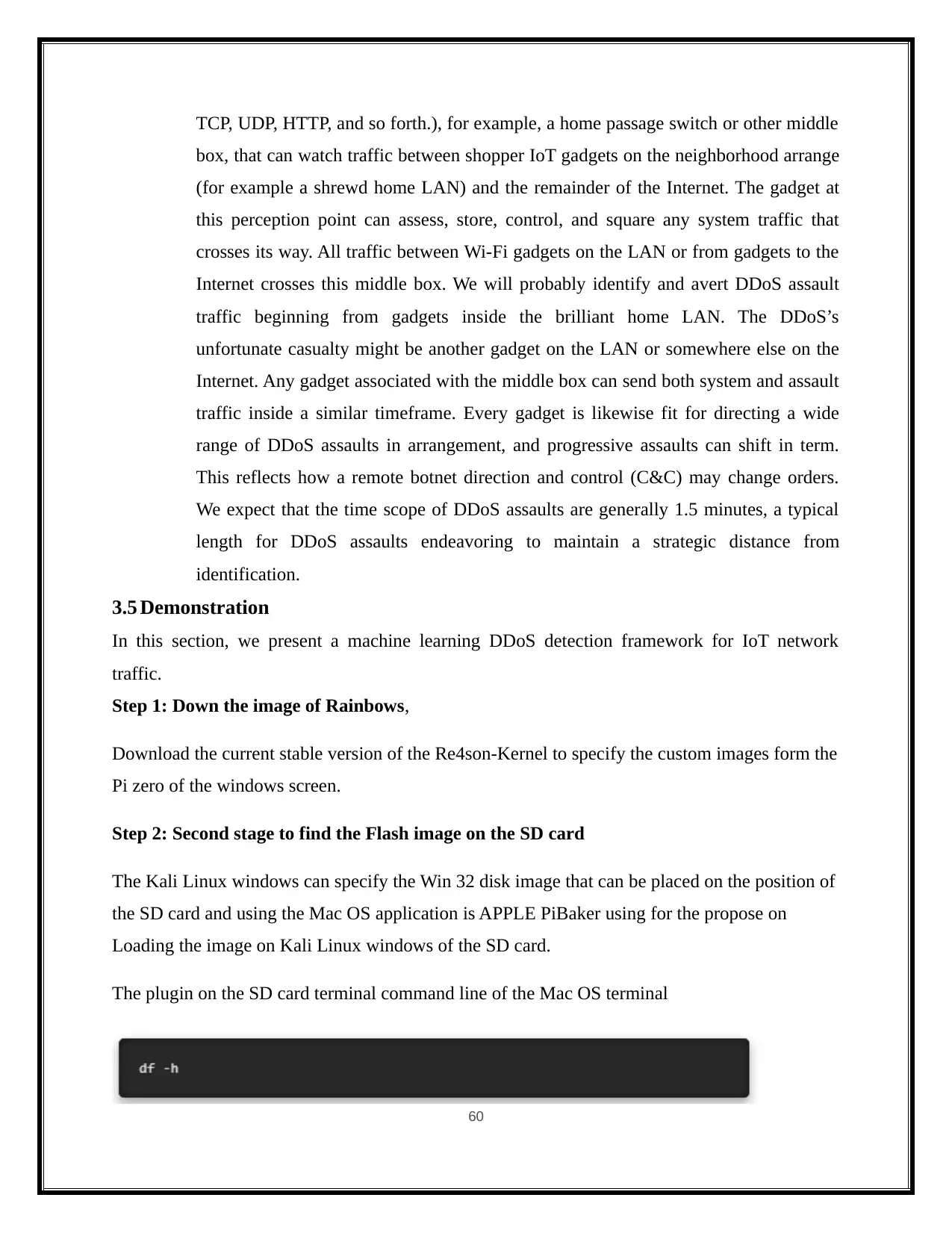
TCP, UDP, HTTP, and so forth.), for example, a home passage switch or other middle
box, that can watch traffic between shopper IoT gadgets on the neighborhood arrange
(for example a shrewd home LAN) and the remainder of the Internet. The gadget at
this perception point can assess, store, control, and square any system traffic that
crosses its way. All traffic between Wi-Fi gadgets on the LAN or from gadgets to the
Internet crosses this middle box. We will probably identify and avert DDoS assault
traffic beginning from gadgets inside the brilliant home LAN. The DDoS’s
unfortunate casualty might be another gadget on the LAN or somewhere else on the
Internet. Any gadget associated with the middle box can send both system and assault
traffic inside a similar timeframe. Every gadget is likewise fit for directing a wide
range of DDoS assaults in arrangement, and progressive assaults can shift in term.
This reflects how a remote botnet direction and control (C&C) may change orders.
We expect that the time scope of DDoS assaults are generally 1.5 minutes, a typical
length for DDoS assaults endeavoring to maintain a strategic distance from
identification.
3.5 Demonstration
In this section, we present a machine learning DDoS detection framework for IoT network
traffic.
Step 1: Down the image of Rainbows,
Download the current stable version of the Re4son-Kernel to specify the custom images form the
Pi zero of the windows screen.
Step 2: Second stage to find the Flash image on the SD card
The Kali Linux windows can specify the Win 32 disk image that can be placed on the position of
the SD card and using the Mac OS application is APPLE PiBaker using for the propose on
Loading the image on Kali Linux windows of the SD card.
The plugin on the SD card terminal command line of the Mac OS terminal
60
box, that can watch traffic between shopper IoT gadgets on the neighborhood arrange
(for example a shrewd home LAN) and the remainder of the Internet. The gadget at
this perception point can assess, store, control, and square any system traffic that
crosses its way. All traffic between Wi-Fi gadgets on the LAN or from gadgets to the
Internet crosses this middle box. We will probably identify and avert DDoS assault
traffic beginning from gadgets inside the brilliant home LAN. The DDoS’s
unfortunate casualty might be another gadget on the LAN or somewhere else on the
Internet. Any gadget associated with the middle box can send both system and assault
traffic inside a similar timeframe. Every gadget is likewise fit for directing a wide
range of DDoS assaults in arrangement, and progressive assaults can shift in term.
This reflects how a remote botnet direction and control (C&C) may change orders.
We expect that the time scope of DDoS assaults are generally 1.5 minutes, a typical
length for DDoS assaults endeavoring to maintain a strategic distance from
identification.
3.5 Demonstration
In this section, we present a machine learning DDoS detection framework for IoT network
traffic.
Step 1: Down the image of Rainbows,
Download the current stable version of the Re4son-Kernel to specify the custom images form the
Pi zero of the windows screen.
Step 2: Second stage to find the Flash image on the SD card
The Kali Linux windows can specify the Win 32 disk image that can be placed on the position of
the SD card and using the Mac OS application is APPLE PiBaker using for the propose on
Loading the image on Kali Linux windows of the SD card.
The plugin on the SD card terminal command line of the Mac OS terminal
60
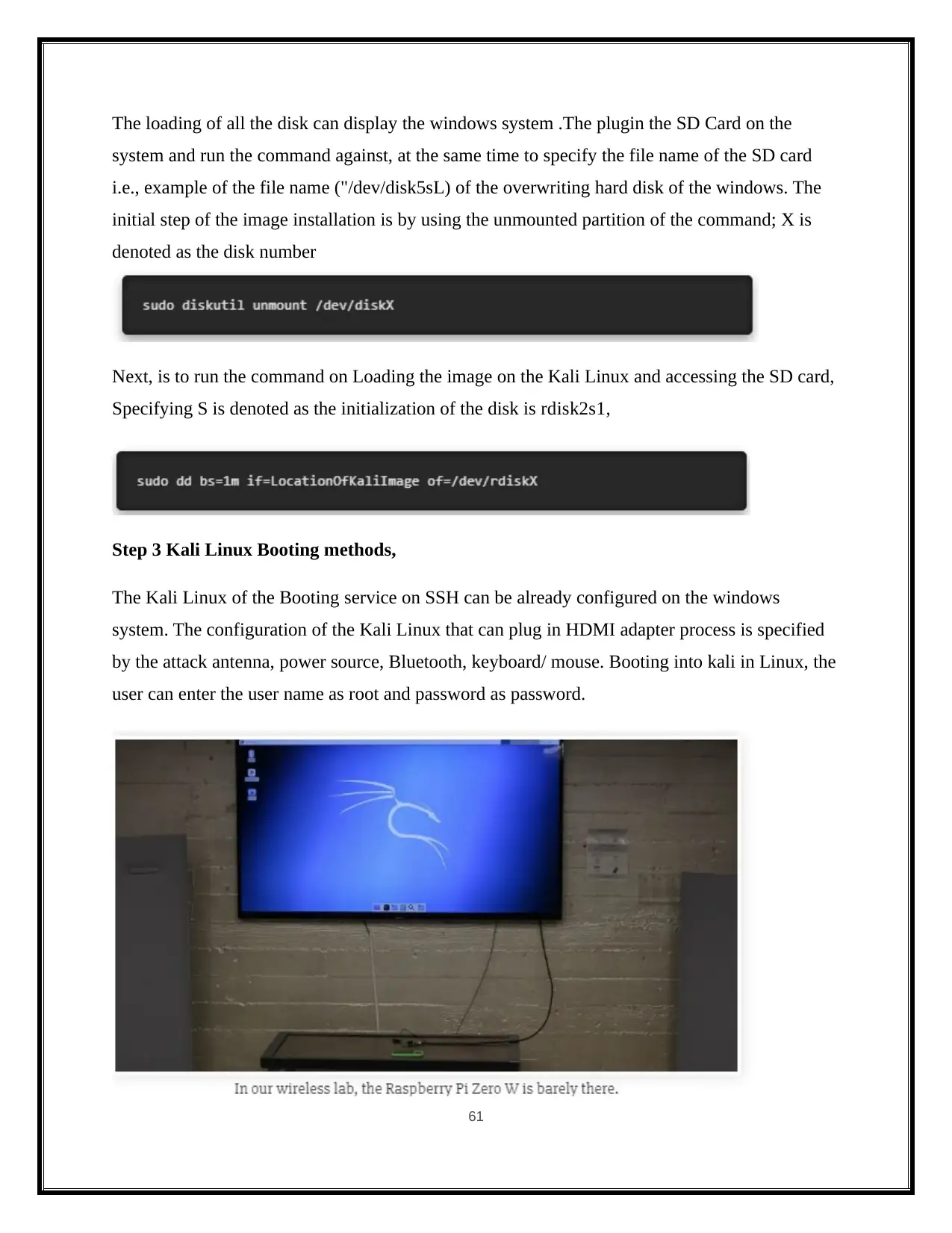
The loading of all the disk can display the windows system .The plugin the SD Card on the
system and run the command against, at the same time to specify the file name of the SD card
i.e., example of the file name ("/dev/disk5sL) of the overwriting hard disk of the windows. The
initial step of the image installation is by using the unmounted partition of the command; X is
denoted as the disk number
Next, is to run the command on Loading the image on the Kali Linux and accessing the SD card,
Specifying S is denoted as the initialization of the disk is rdisk2s1,
Step 3 Kali Linux Booting methods,
The Kali Linux of the Booting service on SSH can be already configured on the windows
system. The configuration of the Kali Linux that can plug in HDMI adapter process is specified
by the attack antenna, power source, Bluetooth, keyboard/ mouse. Booting into kali in Linux, the
user can enter the user name as root and password as password.
61
system and run the command against, at the same time to specify the file name of the SD card
i.e., example of the file name ("/dev/disk5sL) of the overwriting hard disk of the windows. The
initial step of the image installation is by using the unmounted partition of the command; X is
denoted as the disk number
Next, is to run the command on Loading the image on the Kali Linux and accessing the SD card,
Specifying S is denoted as the initialization of the disk is rdisk2s1,
Step 3 Kali Linux Booting methods,
The Kali Linux of the Booting service on SSH can be already configured on the windows
system. The configuration of the Kali Linux that can plug in HDMI adapter process is specified
by the attack antenna, power source, Bluetooth, keyboard/ mouse. Booting into kali in Linux, the
user can enter the user name as root and password as password.
61
Secure Best Marks with AI Grader
Need help grading? Try our AI Grader for instant feedback on your assignments.
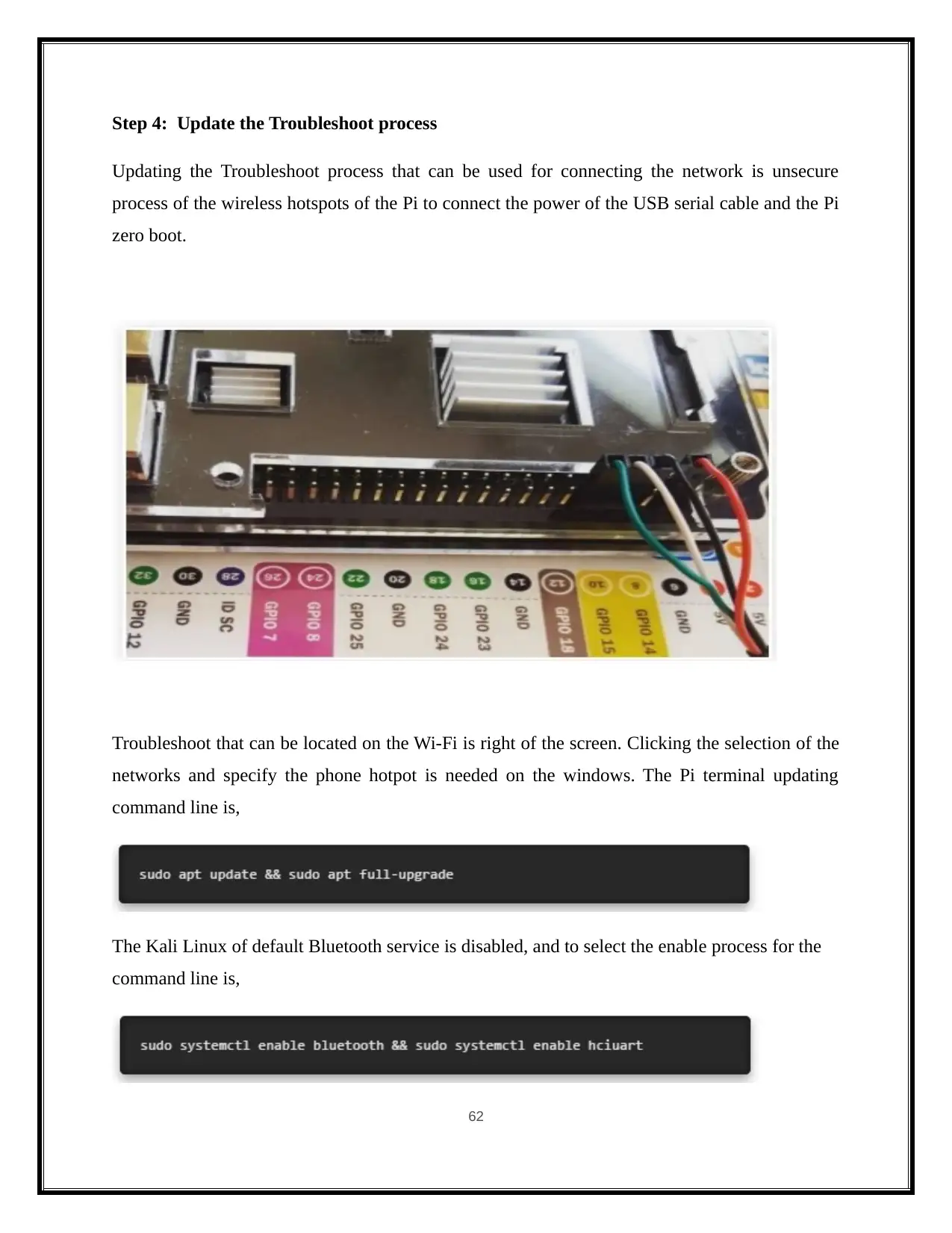
Step 4: Update the Troubleshoot process
Updating the Troubleshoot process that can be used for connecting the network is unsecure
process of the wireless hotspots of the Pi to connect the power of the USB serial cable and the Pi
zero boot.
Troubleshoot that can be located on the Wi-Fi is right of the screen. Clicking the selection of the
networks and specify the phone hotpot is needed on the windows. The Pi terminal updating
command line is,
The Kali Linux of default Bluetooth service is disabled, and to select the enable process for the
command line is,
62
Updating the Troubleshoot process that can be used for connecting the network is unsecure
process of the wireless hotspots of the Pi to connect the power of the USB serial cable and the Pi
zero boot.
Troubleshoot that can be located on the Wi-Fi is right of the screen. Clicking the selection of the
networks and specify the phone hotpot is needed on the windows. The Pi terminal updating
command line is,
The Kali Linux of default Bluetooth service is disabled, and to select the enable process for the
command line is,
62

Step5: Setup & Housecleaning
The default Kali Linux SSH key that can be changed and using the terminal command is,
The changing the root username and password is,
Step 6: Auto login Enable
Enabling of the auto Login can be used for the pre- configured SSH, after that changing the
configuration option on the windows and run the terminal command,
Removing of the tags that is used for command is,
The output of the auto Login part is,
63
The default Kali Linux SSH key that can be changed and using the terminal command is,
The changing the root username and password is,
Step 6: Auto login Enable
Enabling of the auto Login can be used for the pre- configured SSH, after that changing the
configuration option on the windows and run the terminal command,
Removing of the tags that is used for command is,
The output of the auto Login part is,
63
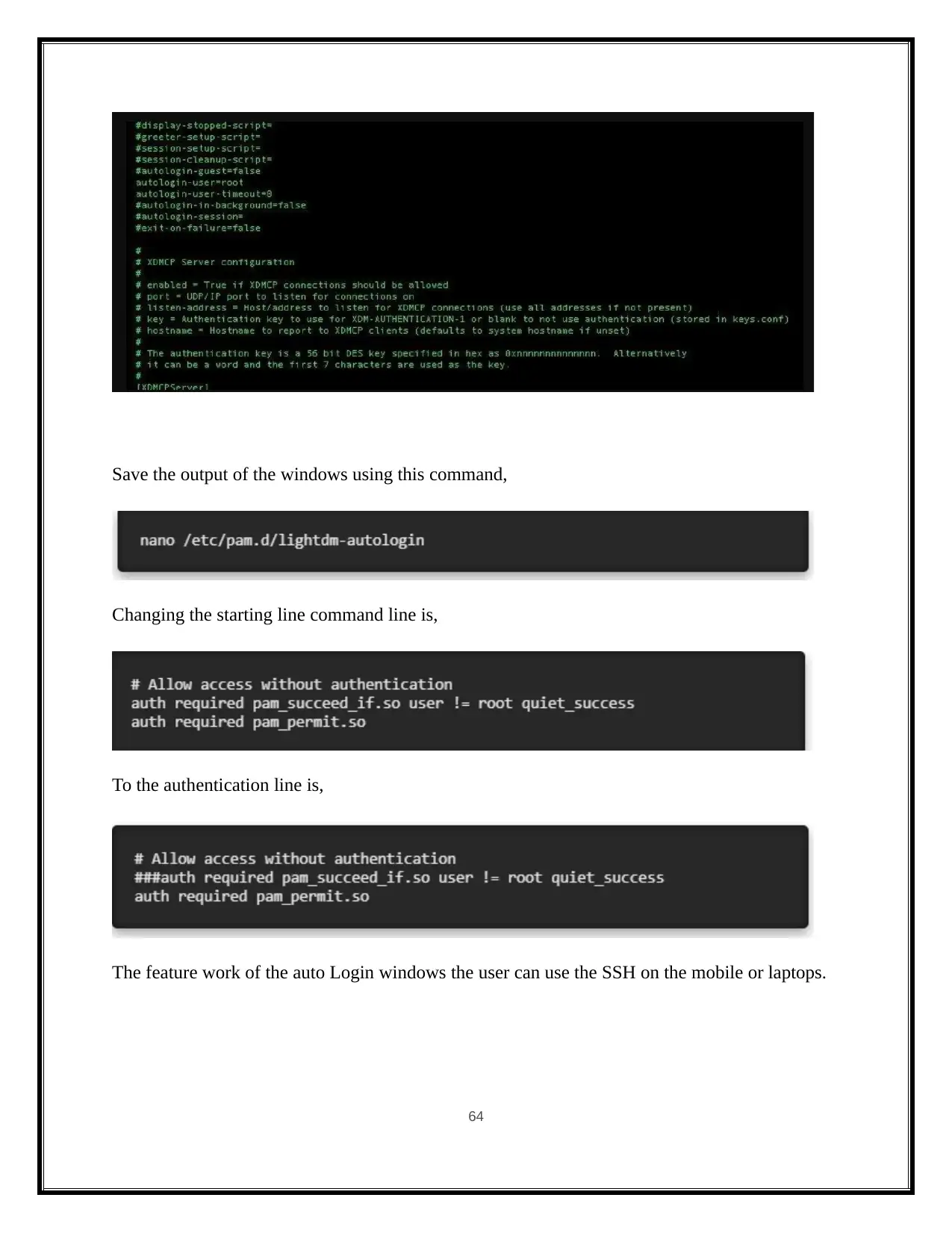
Save the output of the windows using this command,
Changing the starting line command line is,
To the authentication line is,
The feature work of the auto Login windows the user can use the SSH on the mobile or laptops.
64
Changing the starting line command line is,
To the authentication line is,
The feature work of the auto Login windows the user can use the SSH on the mobile or laptops.
64
Paraphrase This Document
Need a fresh take? Get an instant paraphrase of this document with our AI Paraphraser
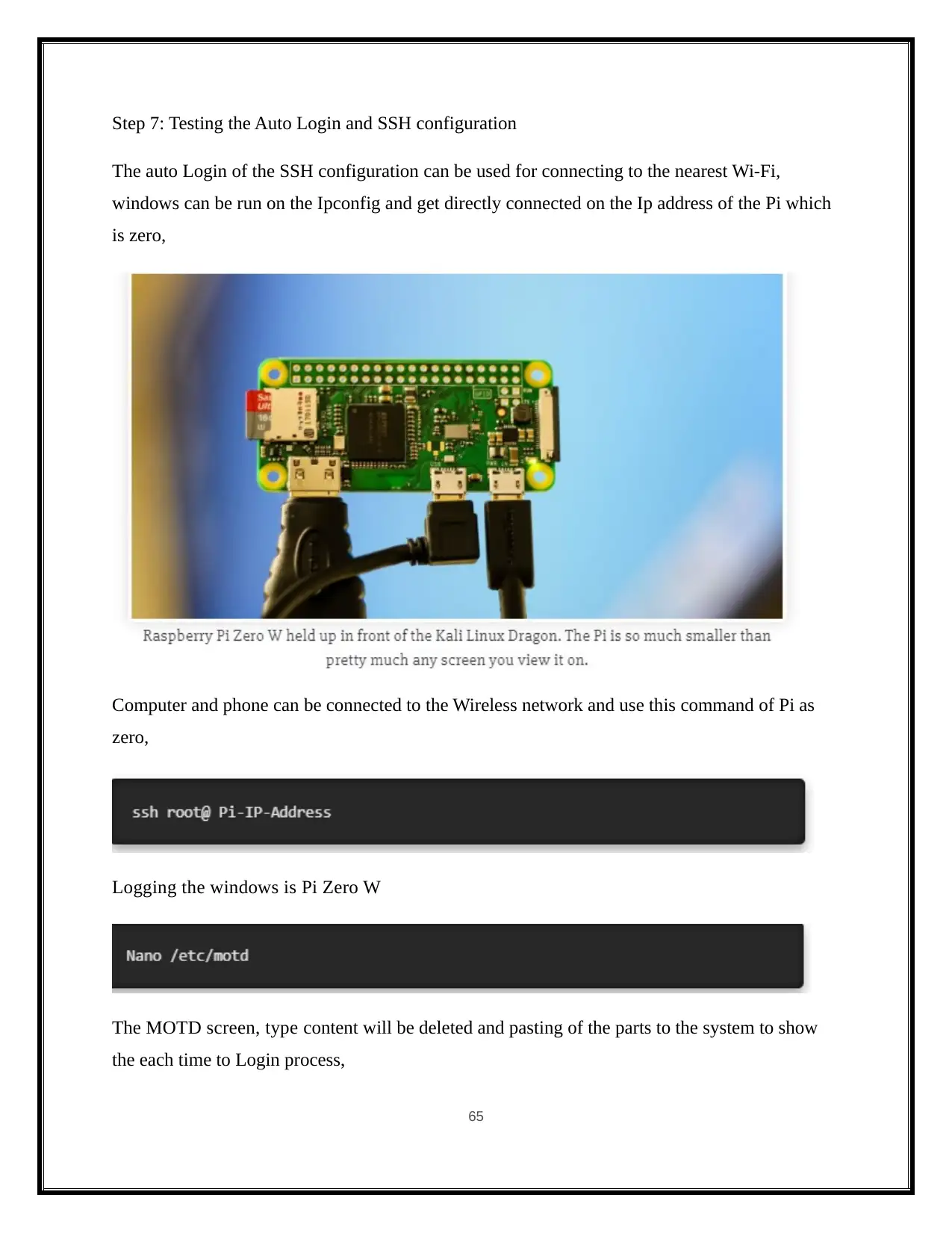
Step 7: Testing the Auto Login and SSH configuration
The auto Login of the SSH configuration can be used for connecting to the nearest Wi-Fi,
windows can be run on the Ipconfig and get directly connected on the Ip address of the Pi which
is zero,
Computer and phone can be connected to the Wireless network and use this command of Pi as
zero,
Logging the windows is Pi Zero W
The MOTD screen, type content will be deleted and pasting of the parts to the system to show
the each time to Login process,
65
The auto Login of the SSH configuration can be used for connecting to the nearest Wi-Fi,
windows can be run on the Ipconfig and get directly connected on the Ip address of the Pi which
is zero,
Computer and phone can be connected to the Wireless network and use this command of Pi as
zero,
Logging the windows is Pi Zero W
The MOTD screen, type content will be deleted and pasting of the parts to the system to show
the each time to Login process,
65
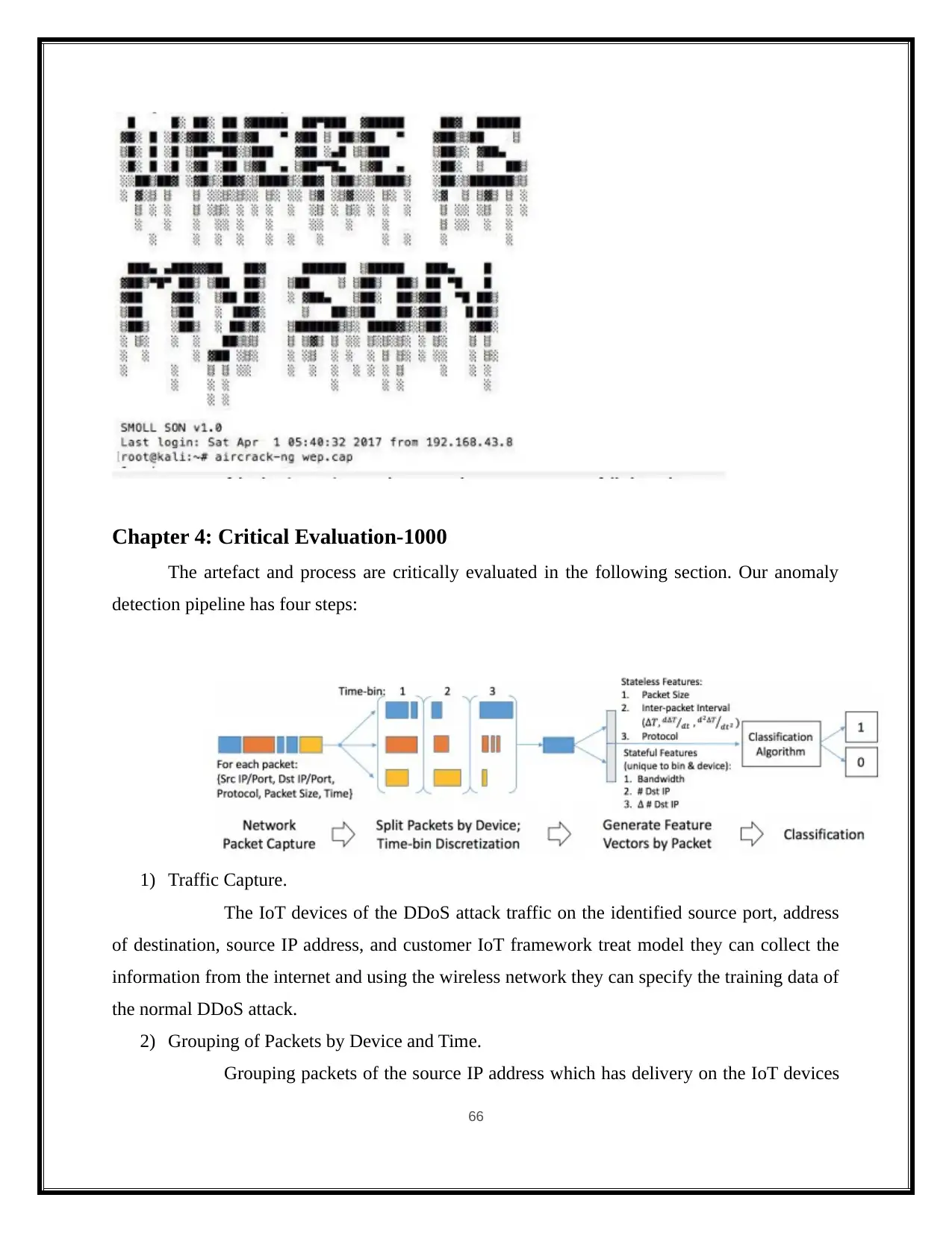
Chapter 4: Critical Evaluation-1000
The artefact and process are critically evaluated in the following section. Our anomaly
detection pipeline has four steps:
1) Traffic Capture.
The IoT devices of the DDoS attack traffic on the identified source port, address
of destination, source IP address, and customer IoT framework treat model they can collect the
information from the internet and using the wireless network they can specify the training data of
the normal DDoS attack.
2) Grouping of Packets by Device and Time.
Grouping packets of the source IP address which has delivery on the IoT devices
66
The artefact and process are critically evaluated in the following section. Our anomaly
detection pipeline has four steps:
1) Traffic Capture.
The IoT devices of the DDoS attack traffic on the identified source port, address
of destination, source IP address, and customer IoT framework treat model they can collect the
information from the internet and using the wireless network they can specify the training data of
the normal DDoS attack.
2) Grouping of Packets by Device and Time.
Grouping packets of the source IP address which has delivery on the IoT devices
66
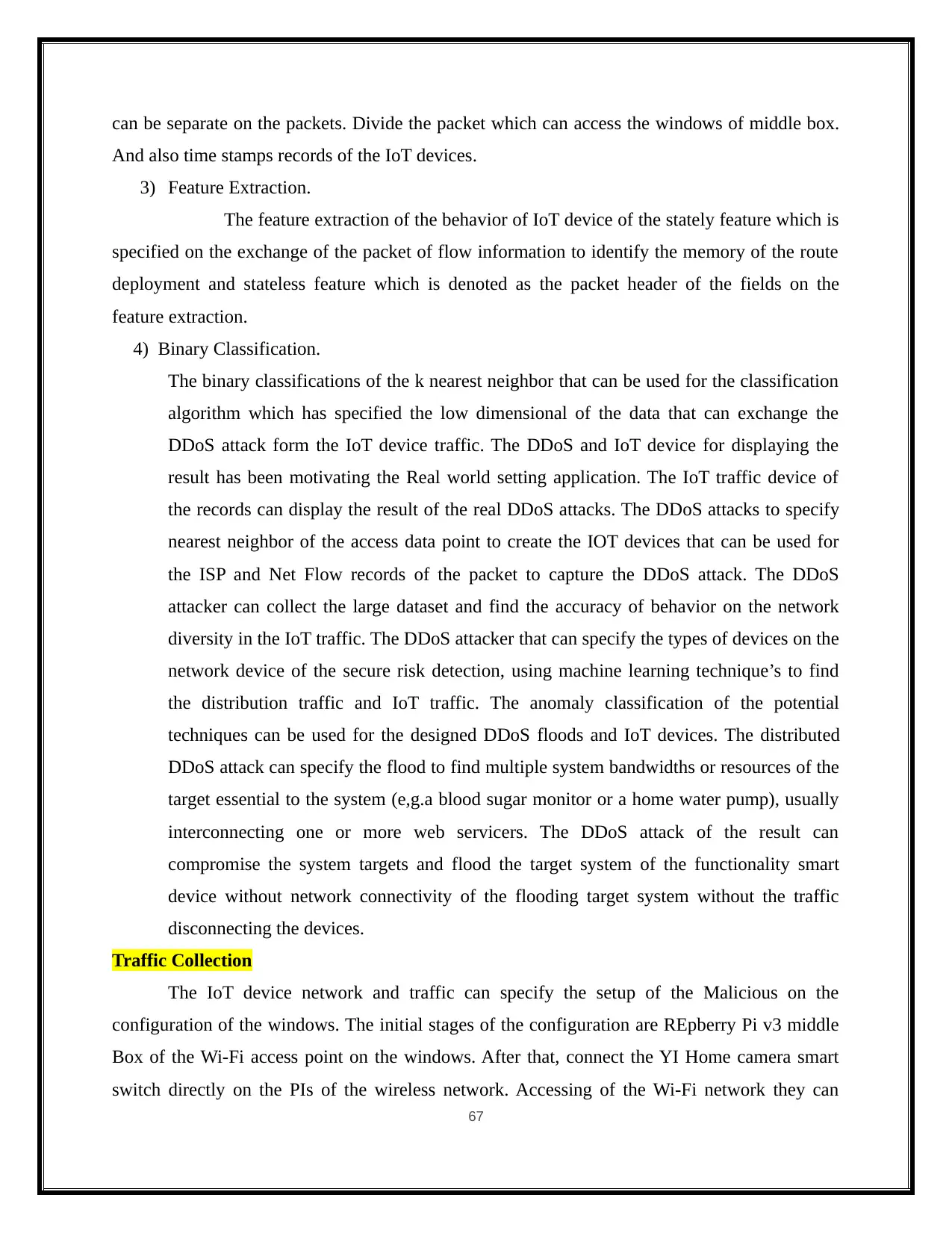
can be separate on the packets. Divide the packet which can access the windows of middle box.
And also time stamps records of the IoT devices.
3) Feature Extraction.
The feature extraction of the behavior of IoT device of the stately feature which is
specified on the exchange of the packet of flow information to identify the memory of the route
deployment and stateless feature which is denoted as the packet header of the fields on the
feature extraction.
4) Binary Classification.
The binary classifications of the k nearest neighbor that can be used for the classification
algorithm which has specified the low dimensional of the data that can exchange the
DDoS attack form the IoT device traffic. The DDoS and IoT device for displaying the
result has been motivating the Real world setting application. The IoT traffic device of
the records can display the result of the real DDoS attacks. The DDoS attacks to specify
nearest neighbor of the access data point to create the IOT devices that can be used for
the ISP and Net Flow records of the packet to capture the DDoS attack. The DDoS
attacker can collect the large dataset and find the accuracy of behavior on the network
diversity in the IoT traffic. The DDoS attacker that can specify the types of devices on the
network device of the secure risk detection, using machine learning technique’s to find
the distribution traffic and IoT traffic. The anomaly classification of the potential
techniques can be used for the designed DDoS floods and IoT devices. The distributed
DDoS attack can specify the flood to find multiple system bandwidths or resources of the
target essential to the system (e,g.a blood sugar monitor or a home water pump), usually
interconnecting one or more web servicers. The DDoS attack of the result can
compromise the system targets and flood the target system of the functionality smart
device without network connectivity of the flooding target system without the traffic
disconnecting the devices.
Traffic Collection
The IoT device network and traffic can specify the setup of the Malicious on the
configuration of the windows. The initial stages of the configuration are REpberry Pi v3 middle
Box of the Wi-Fi access point on the windows. After that, connect the YI Home camera smart
switch directly on the PIs of the wireless network. Accessing of the Wi-Fi network they can
67
And also time stamps records of the IoT devices.
3) Feature Extraction.
The feature extraction of the behavior of IoT device of the stately feature which is
specified on the exchange of the packet of flow information to identify the memory of the route
deployment and stateless feature which is denoted as the packet header of the fields on the
feature extraction.
4) Binary Classification.
The binary classifications of the k nearest neighbor that can be used for the classification
algorithm which has specified the low dimensional of the data that can exchange the
DDoS attack form the IoT device traffic. The DDoS and IoT device for displaying the
result has been motivating the Real world setting application. The IoT traffic device of
the records can display the result of the real DDoS attacks. The DDoS attacks to specify
nearest neighbor of the access data point to create the IOT devices that can be used for
the ISP and Net Flow records of the packet to capture the DDoS attack. The DDoS
attacker can collect the large dataset and find the accuracy of behavior on the network
diversity in the IoT traffic. The DDoS attacker that can specify the types of devices on the
network device of the secure risk detection, using machine learning technique’s to find
the distribution traffic and IoT traffic. The anomaly classification of the potential
techniques can be used for the designed DDoS floods and IoT devices. The distributed
DDoS attack can specify the flood to find multiple system bandwidths or resources of the
target essential to the system (e,g.a blood sugar monitor or a home water pump), usually
interconnecting one or more web servicers. The DDoS attack of the result can
compromise the system targets and flood the target system of the functionality smart
device without network connectivity of the flooding target system without the traffic
disconnecting the devices.
Traffic Collection
The IoT device network and traffic can specify the setup of the Malicious on the
configuration of the windows. The initial stages of the configuration are REpberry Pi v3 middle
Box of the Wi-Fi access point on the windows. After that, connect the YI Home camera smart
switch directly on the PIs of the wireless network. Accessing of the Wi-Fi network they can
67
Secure Best Marks with AI Grader
Need help grading? Try our AI Grader for instant feedback on your assignments.
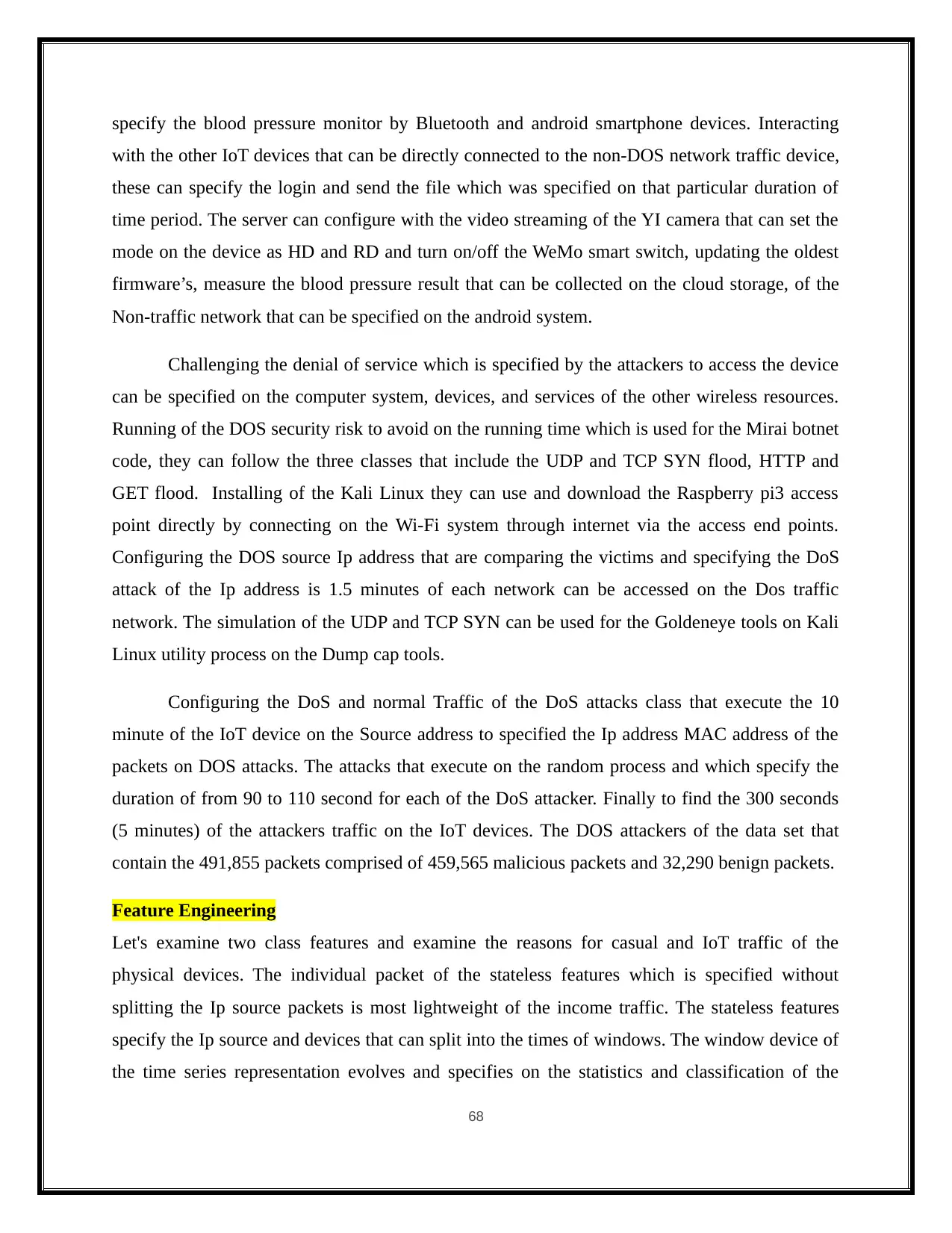
specify the blood pressure monitor by Bluetooth and android smartphone devices. Interacting
with the other IoT devices that can be directly connected to the non-DOS network traffic device,
these can specify the login and send the file which was specified on that particular duration of
time period. The server can configure with the video streaming of the YI camera that can set the
mode on the device as HD and RD and turn on/off the WeMo smart switch, updating the oldest
firmware’s, measure the blood pressure result that can be collected on the cloud storage, of the
Non-traffic network that can be specified on the android system.
Challenging the denial of service which is specified by the attackers to access the device
can be specified on the computer system, devices, and services of the other wireless resources.
Running of the DOS security risk to avoid on the running time which is used for the Mirai botnet
code, they can follow the three classes that include the UDP and TCP SYN flood, HTTP and
GET flood. Installing of the Kali Linux they can use and download the Raspberry pi3 access
point directly by connecting on the Wi-Fi system through internet via the access end points.
Configuring the DOS source Ip address that are comparing the victims and specifying the DoS
attack of the Ip address is 1.5 minutes of each network can be accessed on the Dos traffic
network. The simulation of the UDP and TCP SYN can be used for the Goldeneye tools on Kali
Linux utility process on the Dump cap tools.
Configuring the DoS and normal Traffic of the DoS attacks class that execute the 10
minute of the IoT device on the Source address to specified the Ip address MAC address of the
packets on DOS attacks. The attacks that execute on the random process and which specify the
duration of from 90 to 110 second for each of the DoS attacker. Finally to find the 300 seconds
(5 minutes) of the attackers traffic on the IoT devices. The DOS attackers of the data set that
contain the 491,855 packets comprised of 459,565 malicious packets and 32,290 benign packets.
Feature Engineering
Let's examine two class features and examine the reasons for casual and IoT traffic of the
physical devices. The individual packet of the stateless features which is specified without
splitting the Ip source packets is most lightweight of the income traffic. The stateless features
specify the Ip source and devices that can split into the times of windows. The window device of
the time series representation evolves and specifies on the statistics and classification of the
68
with the other IoT devices that can be directly connected to the non-DOS network traffic device,
these can specify the login and send the file which was specified on that particular duration of
time period. The server can configure with the video streaming of the YI camera that can set the
mode on the device as HD and RD and turn on/off the WeMo smart switch, updating the oldest
firmware’s, measure the blood pressure result that can be collected on the cloud storage, of the
Non-traffic network that can be specified on the android system.
Challenging the denial of service which is specified by the attackers to access the device
can be specified on the computer system, devices, and services of the other wireless resources.
Running of the DOS security risk to avoid on the running time which is used for the Mirai botnet
code, they can follow the three classes that include the UDP and TCP SYN flood, HTTP and
GET flood. Installing of the Kali Linux they can use and download the Raspberry pi3 access
point directly by connecting on the Wi-Fi system through internet via the access end points.
Configuring the DOS source Ip address that are comparing the victims and specifying the DoS
attack of the Ip address is 1.5 minutes of each network can be accessed on the Dos traffic
network. The simulation of the UDP and TCP SYN can be used for the Goldeneye tools on Kali
Linux utility process on the Dump cap tools.
Configuring the DoS and normal Traffic of the DoS attacks class that execute the 10
minute of the IoT device on the Source address to specified the Ip address MAC address of the
packets on DOS attacks. The attacks that execute on the random process and which specify the
duration of from 90 to 110 second for each of the DoS attacker. Finally to find the 300 seconds
(5 minutes) of the attackers traffic on the IoT devices. The DOS attackers of the data set that
contain the 491,855 packets comprised of 459,565 malicious packets and 32,290 benign packets.
Feature Engineering
Let's examine two class features and examine the reasons for casual and IoT traffic of the
physical devices. The individual packet of the stateless features which is specified without
splitting the Ip source packets is most lightweight of the income traffic. The stateless features
specify the Ip source and devices that can split into the times of windows. The window device of
the time series representation evolves and specifies on the statistics and classification of the
68
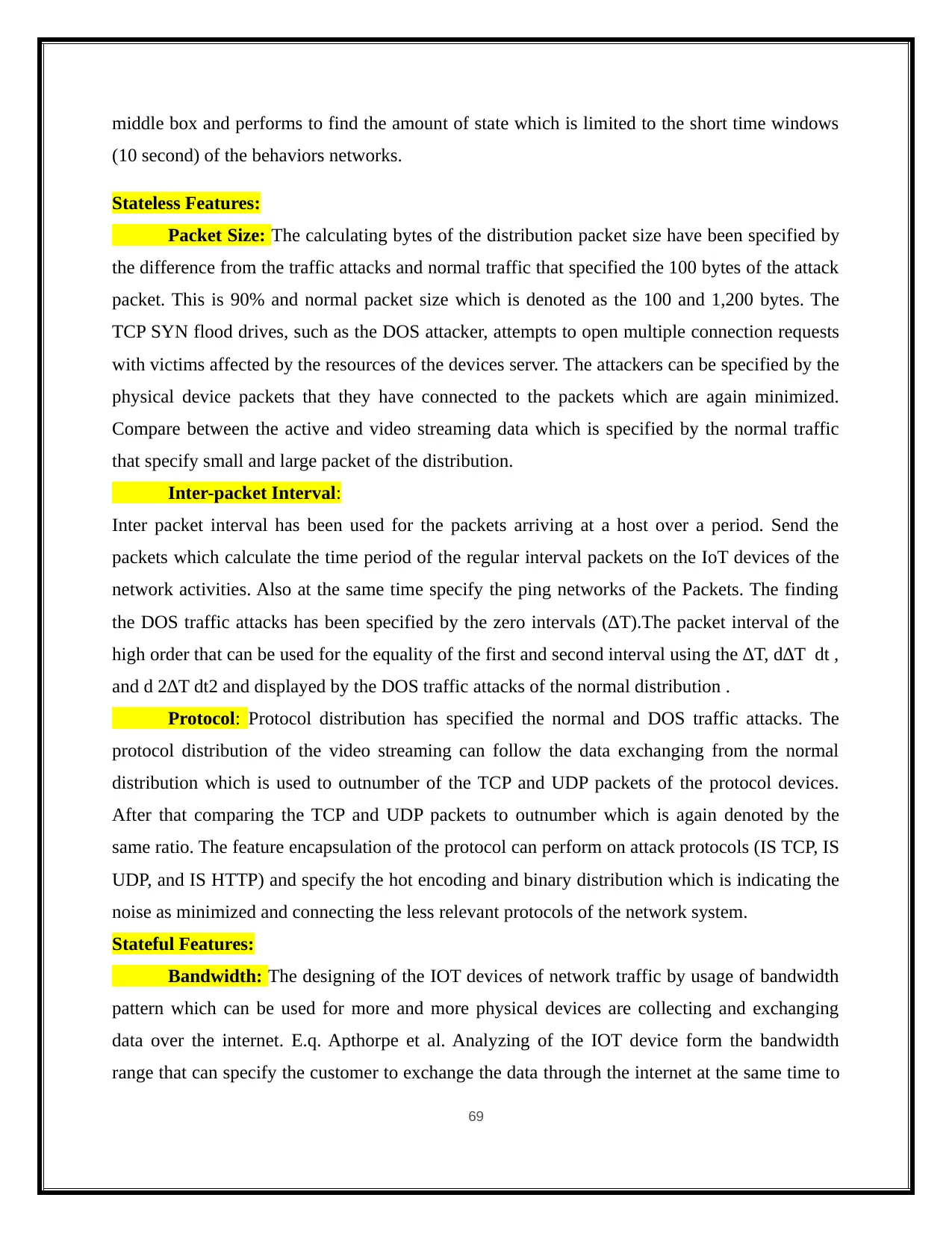
middle box and performs to find the amount of state which is limited to the short time windows
(10 second) of the behaviors networks.
Stateless Features:
Packet Size: The calculating bytes of the distribution packet size have been specified by
the difference from the traffic attacks and normal traffic that specified the 100 bytes of the attack
packet. This is 90% and normal packet size which is denoted as the 100 and 1,200 bytes. The
TCP SYN flood drives, such as the DOS attacker, attempts to open multiple connection requests
with victims affected by the resources of the devices server. The attackers can be specified by the
physical device packets that they have connected to the packets which are again minimized.
Compare between the active and video streaming data which is specified by the normal traffic
that specify small and large packet of the distribution.
Inter-packet Interval:
Inter packet interval has been used for the packets arriving at a host over a period. Send the
packets which calculate the time period of the regular interval packets on the IoT devices of the
network activities. Also at the same time specify the ping networks of the Packets. The finding
the DOS traffic attacks has been specified by the zero intervals (∆T).The packet interval of the
high order that can be used for the equality of the first and second interval using the ∆T, d∆T dt ,
and d 2∆T dt2 and displayed by the DOS traffic attacks of the normal distribution .
Protocol: Protocol distribution has specified the normal and DOS traffic attacks. The
protocol distribution of the video streaming can follow the data exchanging from the normal
distribution which is used to outnumber of the TCP and UDP packets of the protocol devices.
After that comparing the TCP and UDP packets to outnumber which is again denoted by the
same ratio. The feature encapsulation of the protocol can perform on attack protocols (IS TCP, IS
UDP, and IS HTTP) and specify the hot encoding and binary distribution which is indicating the
noise as minimized and connecting the less relevant protocols of the network system.
Stateful Features:
Bandwidth: The designing of the IOT devices of network traffic by usage of bandwidth
pattern which can be used for more and more physical devices are collecting and exchanging
data over the internet. E.q. Apthorpe et al. Analyzing of the IOT device form the bandwidth
range that can specify the customer to exchange the data through the internet at the same time to
69
(10 second) of the behaviors networks.
Stateless Features:
Packet Size: The calculating bytes of the distribution packet size have been specified by
the difference from the traffic attacks and normal traffic that specified the 100 bytes of the attack
packet. This is 90% and normal packet size which is denoted as the 100 and 1,200 bytes. The
TCP SYN flood drives, such as the DOS attacker, attempts to open multiple connection requests
with victims affected by the resources of the devices server. The attackers can be specified by the
physical device packets that they have connected to the packets which are again minimized.
Compare between the active and video streaming data which is specified by the normal traffic
that specify small and large packet of the distribution.
Inter-packet Interval:
Inter packet interval has been used for the packets arriving at a host over a period. Send the
packets which calculate the time period of the regular interval packets on the IoT devices of the
network activities. Also at the same time specify the ping networks of the Packets. The finding
the DOS traffic attacks has been specified by the zero intervals (∆T).The packet interval of the
high order that can be used for the equality of the first and second interval using the ∆T, d∆T dt ,
and d 2∆T dt2 and displayed by the DOS traffic attacks of the normal distribution .
Protocol: Protocol distribution has specified the normal and DOS traffic attacks. The
protocol distribution of the video streaming can follow the data exchanging from the normal
distribution which is used to outnumber of the TCP and UDP packets of the protocol devices.
After that comparing the TCP and UDP packets to outnumber which is again denoted by the
same ratio. The feature encapsulation of the protocol can perform on attack protocols (IS TCP, IS
UDP, and IS HTTP) and specify the hot encoding and binary distribution which is indicating the
noise as minimized and connecting the less relevant protocols of the network system.
Stateful Features:
Bandwidth: The designing of the IOT devices of network traffic by usage of bandwidth
pattern which can be used for more and more physical devices are collecting and exchanging
data over the internet. E.q. Apthorpe et al. Analyzing of the IOT device form the bandwidth
range that can specify the customer to exchange the data through the internet at the same time to
69

specify the send/receive source device that can analyze the traffic dividing network[7].
Integrating of each IOT device they can calculate the Average bandwidth of traffic source device
as displayed on the 10 seconds time windows on the devices. There are small partition
differences in bandwidth usage between normal and offensive traffic. We have predicted that an
ML model will make these differences.
IP Destination Address Cardinality and Novelty: The extension of the internet of
things that can be used for the object to directly connect on the internet of physical devices.
Designate the IOT devices which can directly communicate with the limits of integrating
endpoints of the IP address destination. The activation and deactivation of the controlling
electrical devices to be login and update the software using WeMo smart plug. This has been the
four ways of termination points to communicate with the cloud services of the system. The IOT
devices can change the IP address of the physical devices that can connect via internet is over
time is taken by the IoT devices. They can specify the position of the IOT devices that can follow
the two ways that includes the behaviors and reflect the connecting devices. The initial stages of
the IOT device can be denoted as the windows which can display the IP address to specify the
destination of the IP address that can display traffic attack of the endpoint which can be
displayed in the windows for 10 seconds. The second stage of the physical device that can
calculate the traffic attacks of the windows to specify the endpoints to be changed in the IP
address destination. The physical device can support two assets of the IoT device which can
specify the system of average of high endpoints packets and traffic attacks on the exhibits of
offensive traffic as denoted by the small distribution of the IOT device.
It is determined that, it contains the following strengths and weakness:
Strengths:
Potential to transform the way consumers and businesses approach the world by leveraging
the scope of the IoT beyond connectivity.
IoT will improve tracking of assets (files, records, tools, etc.) using sensors and connectivity,
which helps organizations benefit from real-time insights.
Weaknesses:
Device discovery
Authentication and authorization
70
Integrating of each IOT device they can calculate the Average bandwidth of traffic source device
as displayed on the 10 seconds time windows on the devices. There are small partition
differences in bandwidth usage between normal and offensive traffic. We have predicted that an
ML model will make these differences.
IP Destination Address Cardinality and Novelty: The extension of the internet of
things that can be used for the object to directly connect on the internet of physical devices.
Designate the IOT devices which can directly communicate with the limits of integrating
endpoints of the IP address destination. The activation and deactivation of the controlling
electrical devices to be login and update the software using WeMo smart plug. This has been the
four ways of termination points to communicate with the cloud services of the system. The IOT
devices can change the IP address of the physical devices that can connect via internet is over
time is taken by the IoT devices. They can specify the position of the IOT devices that can follow
the two ways that includes the behaviors and reflect the connecting devices. The initial stages of
the IOT device can be denoted as the windows which can display the IP address to specify the
destination of the IP address that can display traffic attack of the endpoint which can be
displayed in the windows for 10 seconds. The second stage of the physical device that can
calculate the traffic attacks of the windows to specify the endpoints to be changed in the IP
address destination. The physical device can support two assets of the IoT device which can
specify the system of average of high endpoints packets and traffic attacks on the exhibits of
offensive traffic as denoted by the small distribution of the IOT device.
It is determined that, it contains the following strengths and weakness:
Strengths:
Potential to transform the way consumers and businesses approach the world by leveraging
the scope of the IoT beyond connectivity.
IoT will improve tracking of assets (files, records, tools, etc.) using sensors and connectivity,
which helps organizations benefit from real-time insights.
Weaknesses:
Device discovery
Authentication and authorization
70
Paraphrase This Document
Need a fresh take? Get an instant paraphrase of this document with our AI Paraphraser
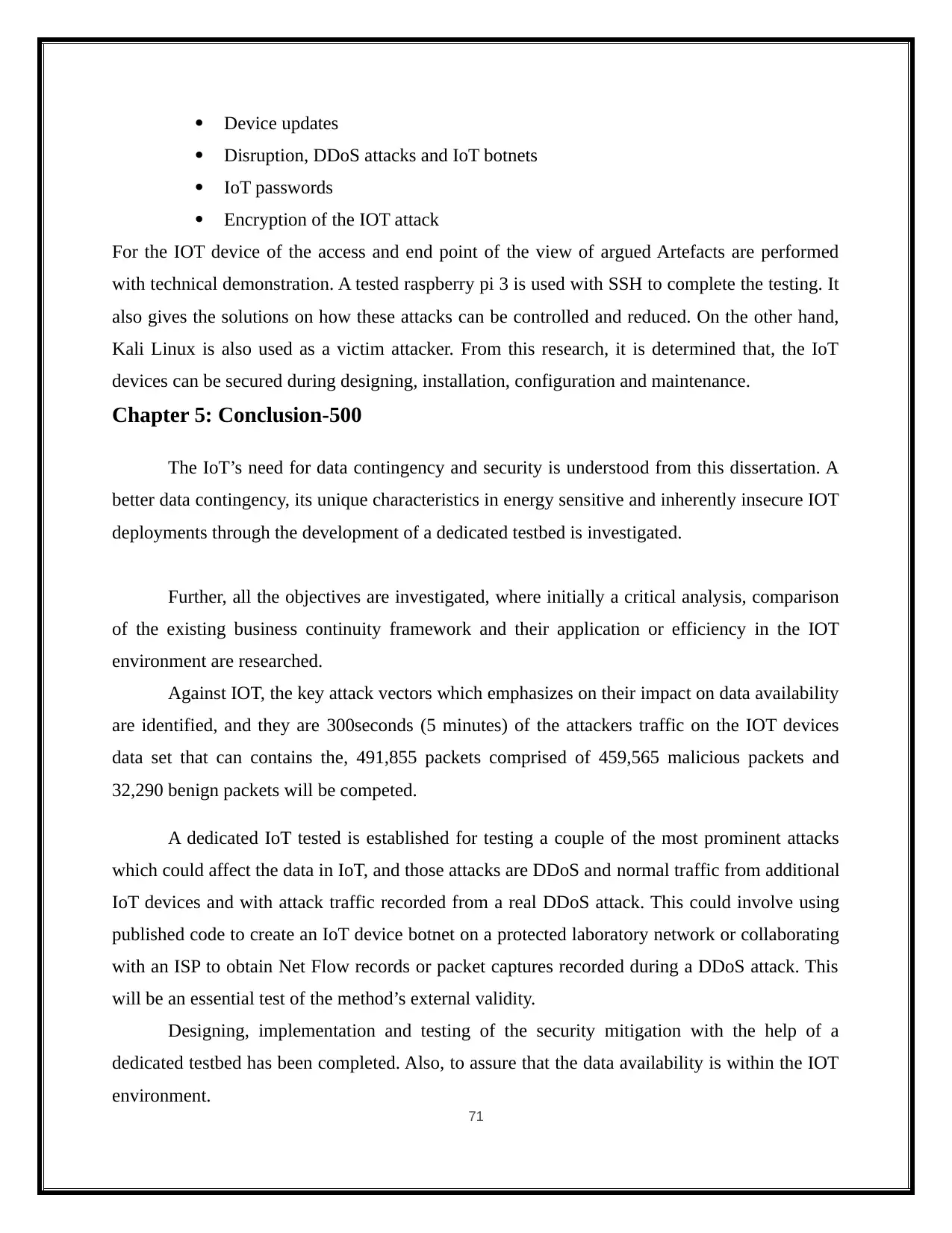
Device updates
Disruption, DDoS attacks and IoT botnets
IoT passwords
Encryption of the IOT attack
For the IOT device of the access and end point of the view of argued Artefacts are performed
with technical demonstration. A tested raspberry pi 3 is used with SSH to complete the testing. It
also gives the solutions on how these attacks can be controlled and reduced. On the other hand,
Kali Linux is also used as a victim attacker. From this research, it is determined that, the IoT
devices can be secured during designing, installation, configuration and maintenance.
Chapter 5: Conclusion-500
The IoT’s need for data contingency and security is understood from this dissertation. A
better data contingency, its unique characteristics in energy sensitive and inherently insecure IOT
deployments through the development of a dedicated testbed is investigated.
Further, all the objectives are investigated, where initially a critical analysis, comparison
of the existing business continuity framework and their application or efficiency in the IOT
environment are researched.
Against IOT, the key attack vectors which emphasizes on their impact on data availability
are identified, and they are 300seconds (5 minutes) of the attackers traffic on the IOT devices
data set that can contains the, 491,855 packets comprised of 459,565 malicious packets and
32,290 benign packets will be competed.
A dedicated IoT tested is established for testing a couple of the most prominent attacks
which could affect the data in IoT, and those attacks are DDoS and normal traffic from additional
IoT devices and with attack traffic recorded from a real DDoS attack. This could involve using
published code to create an IoT device botnet on a protected laboratory network or collaborating
with an ISP to obtain Net Flow records or packet captures recorded during a DDoS attack. This
will be an essential test of the method’s external validity.
Designing, implementation and testing of the security mitigation with the help of a
dedicated testbed has been completed. Also, to assure that the data availability is within the IOT
environment.
71
Disruption, DDoS attacks and IoT botnets
IoT passwords
Encryption of the IOT attack
For the IOT device of the access and end point of the view of argued Artefacts are performed
with technical demonstration. A tested raspberry pi 3 is used with SSH to complete the testing. It
also gives the solutions on how these attacks can be controlled and reduced. On the other hand,
Kali Linux is also used as a victim attacker. From this research, it is determined that, the IoT
devices can be secured during designing, installation, configuration and maintenance.
Chapter 5: Conclusion-500
The IoT’s need for data contingency and security is understood from this dissertation. A
better data contingency, its unique characteristics in energy sensitive and inherently insecure IOT
deployments through the development of a dedicated testbed is investigated.
Further, all the objectives are investigated, where initially a critical analysis, comparison
of the existing business continuity framework and their application or efficiency in the IOT
environment are researched.
Against IOT, the key attack vectors which emphasizes on their impact on data availability
are identified, and they are 300seconds (5 minutes) of the attackers traffic on the IOT devices
data set that can contains the, 491,855 packets comprised of 459,565 malicious packets and
32,290 benign packets will be competed.
A dedicated IoT tested is established for testing a couple of the most prominent attacks
which could affect the data in IoT, and those attacks are DDoS and normal traffic from additional
IoT devices and with attack traffic recorded from a real DDoS attack. This could involve using
published code to create an IoT device botnet on a protected laboratory network or collaborating
with an ISP to obtain Net Flow records or packet captures recorded during a DDoS attack. This
will be an essential test of the method’s external validity.
Designing, implementation and testing of the security mitigation with the help of a
dedicated testbed has been completed. Also, to assure that the data availability is within the IOT
environment.
71
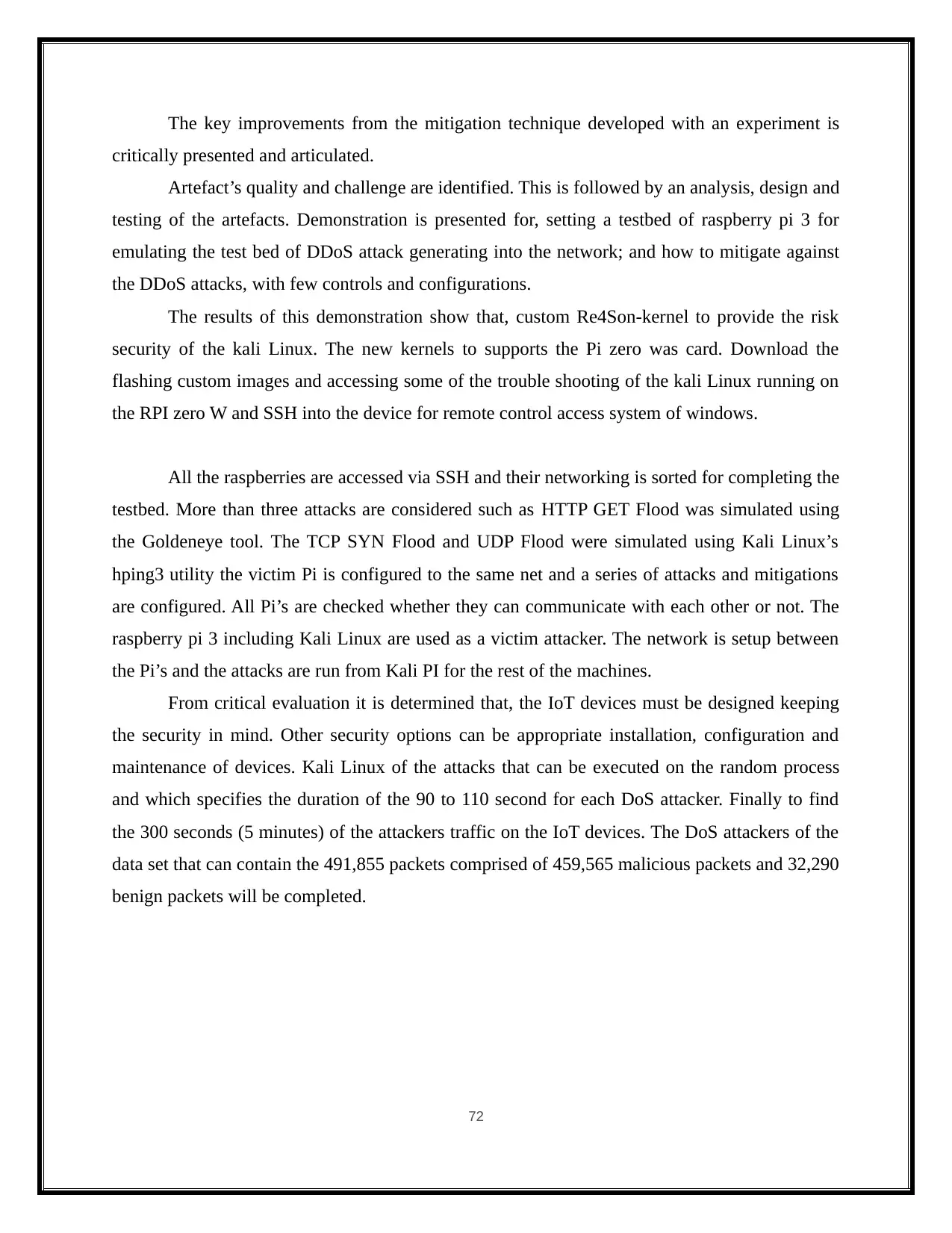
The key improvements from the mitigation technique developed with an experiment is
critically presented and articulated.
Artefact’s quality and challenge are identified. This is followed by an analysis, design and
testing of the artefacts. Demonstration is presented for, setting a testbed of raspberry pi 3 for
emulating the test bed of DDoS attack generating into the network; and how to mitigate against
the DDoS attacks, with few controls and configurations.
The results of this demonstration show that, custom Re4Son-kernel to provide the risk
security of the kali Linux. The new kernels to supports the Pi zero was card. Download the
flashing custom images and accessing some of the trouble shooting of the kali Linux running on
the RPI zero W and SSH into the device for remote control access system of windows.
All the raspberries are accessed via SSH and their networking is sorted for completing the
testbed. More than three attacks are considered such as HTTP GET Flood was simulated using
the Goldeneye tool. The TCP SYN Flood and UDP Flood were simulated using Kali Linux’s
hping3 utility the victim Pi is configured to the same net and a series of attacks and mitigations
are configured. All Pi’s are checked whether they can communicate with each other or not. The
raspberry pi 3 including Kali Linux are used as a victim attacker. The network is setup between
the Pi’s and the attacks are run from Kali PI for the rest of the machines.
From critical evaluation it is determined that, the IoT devices must be designed keeping
the security in mind. Other security options can be appropriate installation, configuration and
maintenance of devices. Kali Linux of the attacks that can be executed on the random process
and which specifies the duration of the 90 to 110 second for each DoS attacker. Finally to find
the 300 seconds (5 minutes) of the attackers traffic on the IoT devices. The DoS attackers of the
data set that can contain the 491,855 packets comprised of 459,565 malicious packets and 32,290
benign packets will be completed.
72
critically presented and articulated.
Artefact’s quality and challenge are identified. This is followed by an analysis, design and
testing of the artefacts. Demonstration is presented for, setting a testbed of raspberry pi 3 for
emulating the test bed of DDoS attack generating into the network; and how to mitigate against
the DDoS attacks, with few controls and configurations.
The results of this demonstration show that, custom Re4Son-kernel to provide the risk
security of the kali Linux. The new kernels to supports the Pi zero was card. Download the
flashing custom images and accessing some of the trouble shooting of the kali Linux running on
the RPI zero W and SSH into the device for remote control access system of windows.
All the raspberries are accessed via SSH and their networking is sorted for completing the
testbed. More than three attacks are considered such as HTTP GET Flood was simulated using
the Goldeneye tool. The TCP SYN Flood and UDP Flood were simulated using Kali Linux’s
hping3 utility the victim Pi is configured to the same net and a series of attacks and mitigations
are configured. All Pi’s are checked whether they can communicate with each other or not. The
raspberry pi 3 including Kali Linux are used as a victim attacker. The network is setup between
the Pi’s and the attacks are run from Kali PI for the rest of the machines.
From critical evaluation it is determined that, the IoT devices must be designed keeping
the security in mind. Other security options can be appropriate installation, configuration and
maintenance of devices. Kali Linux of the attacks that can be executed on the random process
and which specifies the duration of the 90 to 110 second for each DoS attacker. Finally to find
the 300 seconds (5 minutes) of the attackers traffic on the IoT devices. The DoS attackers of the
data set that can contain the 491,855 packets comprised of 459,565 malicious packets and 32,290
benign packets will be completed.
72
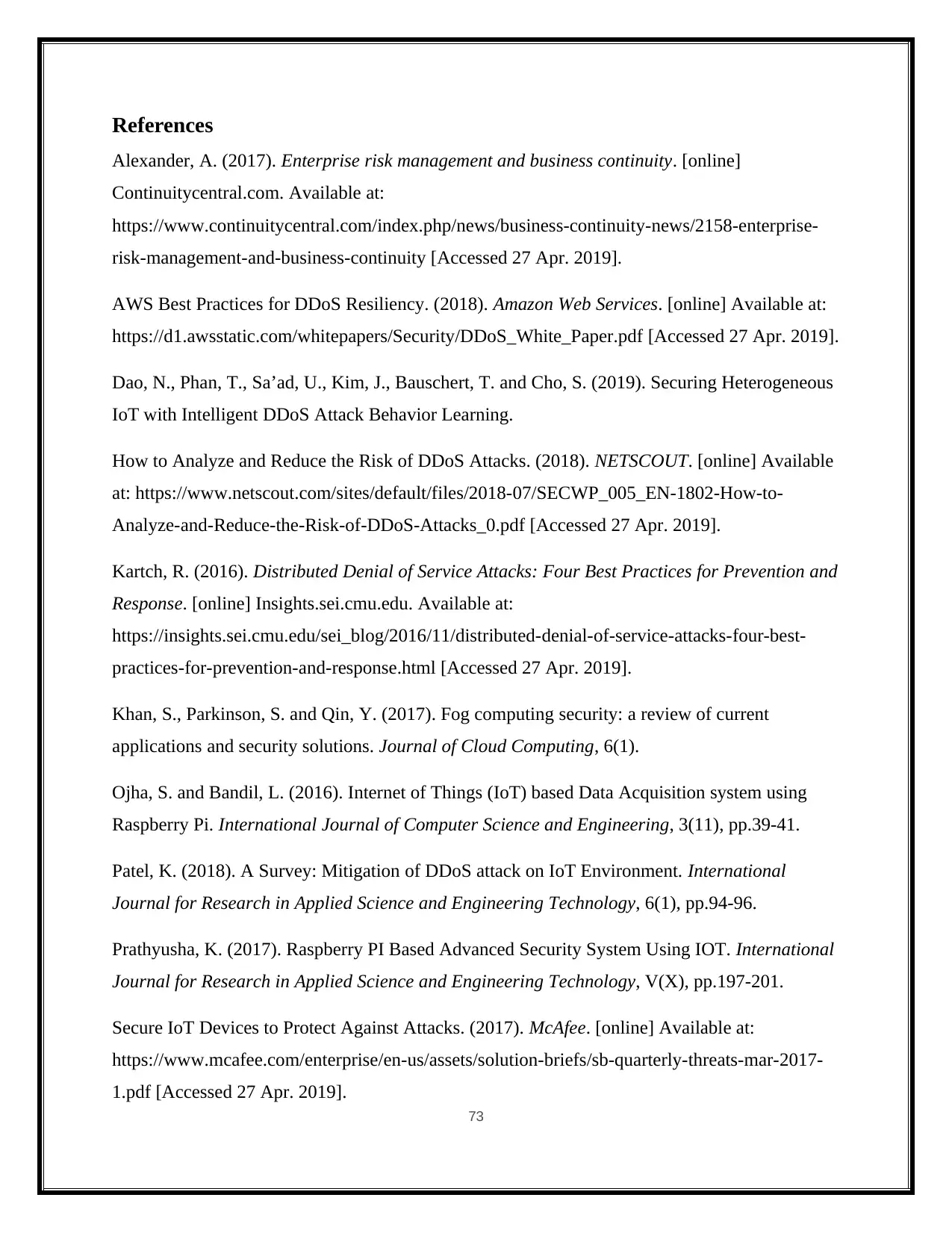
References
Alexander, A. (2017). Enterprise risk management and business continuity. [online]
Continuitycentral.com. Available at:
https://www.continuitycentral.com/index.php/news/business-continuity-news/2158-enterprise-
risk-management-and-business-continuity [Accessed 27 Apr. 2019].
AWS Best Practices for DDoS Resiliency. (2018). Amazon Web Services. [online] Available at:
https://d1.awsstatic.com/whitepapers/Security/DDoS_White_Paper.pdf [Accessed 27 Apr. 2019].
Dao, N., Phan, T., Sa’ad, U., Kim, J., Bauschert, T. and Cho, S. (2019). Securing Heterogeneous
IoT with Intelligent DDoS Attack Behavior Learning.
How to Analyze and Reduce the Risk of DDoS Attacks. (2018). NETSCOUT. [online] Available
at: https://www.netscout.com/sites/default/files/2018-07/SECWP_005_EN-1802-How-to-
Analyze-and-Reduce-the-Risk-of-DDoS-Attacks_0.pdf [Accessed 27 Apr. 2019].
Kartch, R. (2016). Distributed Denial of Service Attacks: Four Best Practices for Prevention and
Response. [online] Insights.sei.cmu.edu. Available at:
https://insights.sei.cmu.edu/sei_blog/2016/11/distributed-denial-of-service-attacks-four-best-
practices-for-prevention-and-response.html [Accessed 27 Apr. 2019].
Khan, S., Parkinson, S. and Qin, Y. (2017). Fog computing security: a review of current
applications and security solutions. Journal of Cloud Computing, 6(1).
Ojha, S. and Bandil, L. (2016). Internet of Things (IoT) based Data Acquisition system using
Raspberry Pi. International Journal of Computer Science and Engineering, 3(11), pp.39-41.
Patel, K. (2018). A Survey: Mitigation of DDoS attack on IoT Environment. International
Journal for Research in Applied Science and Engineering Technology, 6(1), pp.94-96.
Prathyusha, K. (2017). Raspberry PI Based Advanced Security System Using IOT. International
Journal for Research in Applied Science and Engineering Technology, V(X), pp.197-201.
Secure IoT Devices to Protect Against Attacks. (2017). McAfee. [online] Available at:
https://www.mcafee.com/enterprise/en-us/assets/solution-briefs/sb-quarterly-threats-mar-2017-
1.pdf [Accessed 27 Apr. 2019].
73
Alexander, A. (2017). Enterprise risk management and business continuity. [online]
Continuitycentral.com. Available at:
https://www.continuitycentral.com/index.php/news/business-continuity-news/2158-enterprise-
risk-management-and-business-continuity [Accessed 27 Apr. 2019].
AWS Best Practices for DDoS Resiliency. (2018). Amazon Web Services. [online] Available at:
https://d1.awsstatic.com/whitepapers/Security/DDoS_White_Paper.pdf [Accessed 27 Apr. 2019].
Dao, N., Phan, T., Sa’ad, U., Kim, J., Bauschert, T. and Cho, S. (2019). Securing Heterogeneous
IoT with Intelligent DDoS Attack Behavior Learning.
How to Analyze and Reduce the Risk of DDoS Attacks. (2018). NETSCOUT. [online] Available
at: https://www.netscout.com/sites/default/files/2018-07/SECWP_005_EN-1802-How-to-
Analyze-and-Reduce-the-Risk-of-DDoS-Attacks_0.pdf [Accessed 27 Apr. 2019].
Kartch, R. (2016). Distributed Denial of Service Attacks: Four Best Practices for Prevention and
Response. [online] Insights.sei.cmu.edu. Available at:
https://insights.sei.cmu.edu/sei_blog/2016/11/distributed-denial-of-service-attacks-four-best-
practices-for-prevention-and-response.html [Accessed 27 Apr. 2019].
Khan, S., Parkinson, S. and Qin, Y. (2017). Fog computing security: a review of current
applications and security solutions. Journal of Cloud Computing, 6(1).
Ojha, S. and Bandil, L. (2016). Internet of Things (IoT) based Data Acquisition system using
Raspberry Pi. International Journal of Computer Science and Engineering, 3(11), pp.39-41.
Patel, K. (2018). A Survey: Mitigation of DDoS attack on IoT Environment. International
Journal for Research in Applied Science and Engineering Technology, 6(1), pp.94-96.
Prathyusha, K. (2017). Raspberry PI Based Advanced Security System Using IOT. International
Journal for Research in Applied Science and Engineering Technology, V(X), pp.197-201.
Secure IoT Devices to Protect Against Attacks. (2017). McAfee. [online] Available at:
https://www.mcafee.com/enterprise/en-us/assets/solution-briefs/sb-quarterly-threats-mar-2017-
1.pdf [Accessed 27 Apr. 2019].
73
Secure Best Marks with AI Grader
Need help grading? Try our AI Grader for instant feedback on your assignments.

Viswanadh, M. and Singh, D. (2016). Monitor and Control of Remote Appliances using
Raspberry Pi through IoT. International Journal of Engineering Research and, V5(11).
74
Raspberry Pi through IoT. International Journal of Engineering Research and, V5(11).
74
1 out of 77
Related Documents
Your All-in-One AI-Powered Toolkit for Academic Success.
+13062052269
info@desklib.com
Available 24*7 on WhatsApp / Email
![[object Object]](/_next/static/media/star-bottom.7253800d.svg)
Unlock your academic potential
© 2024 | Zucol Services PVT LTD | All rights reserved.





